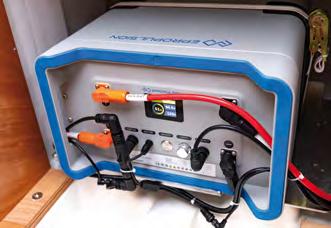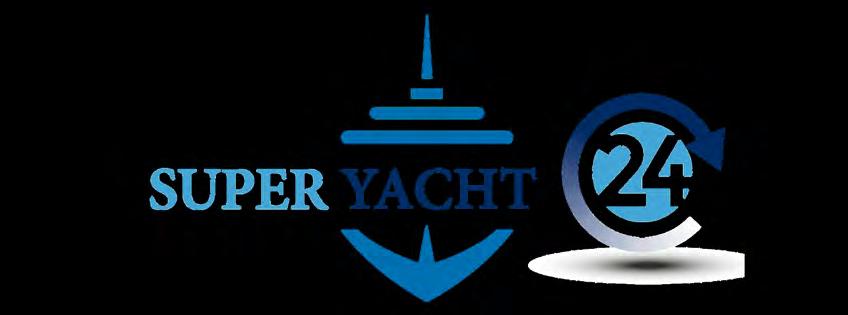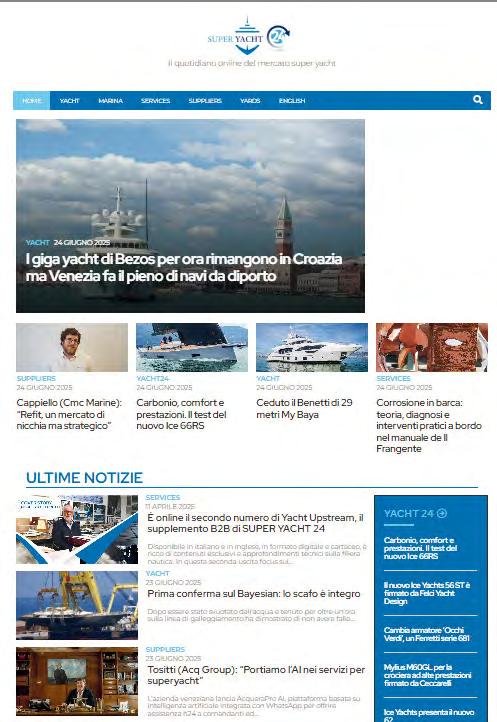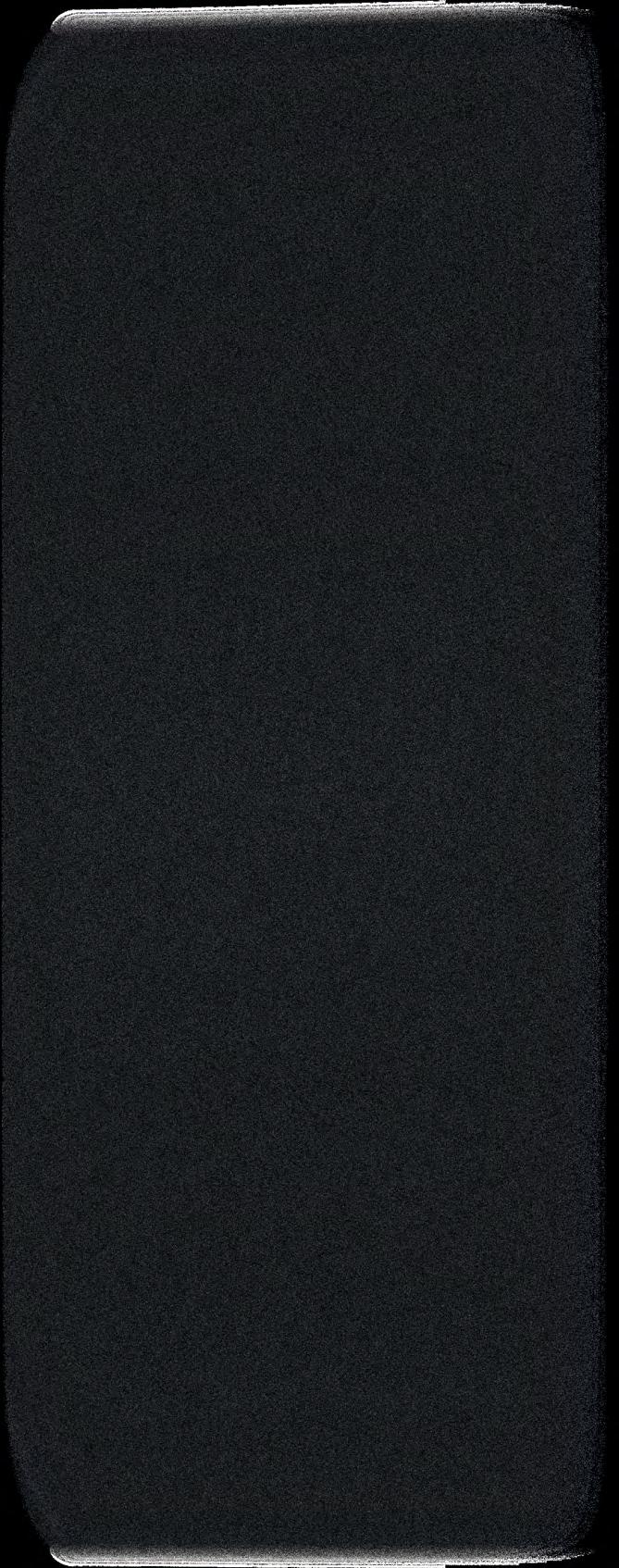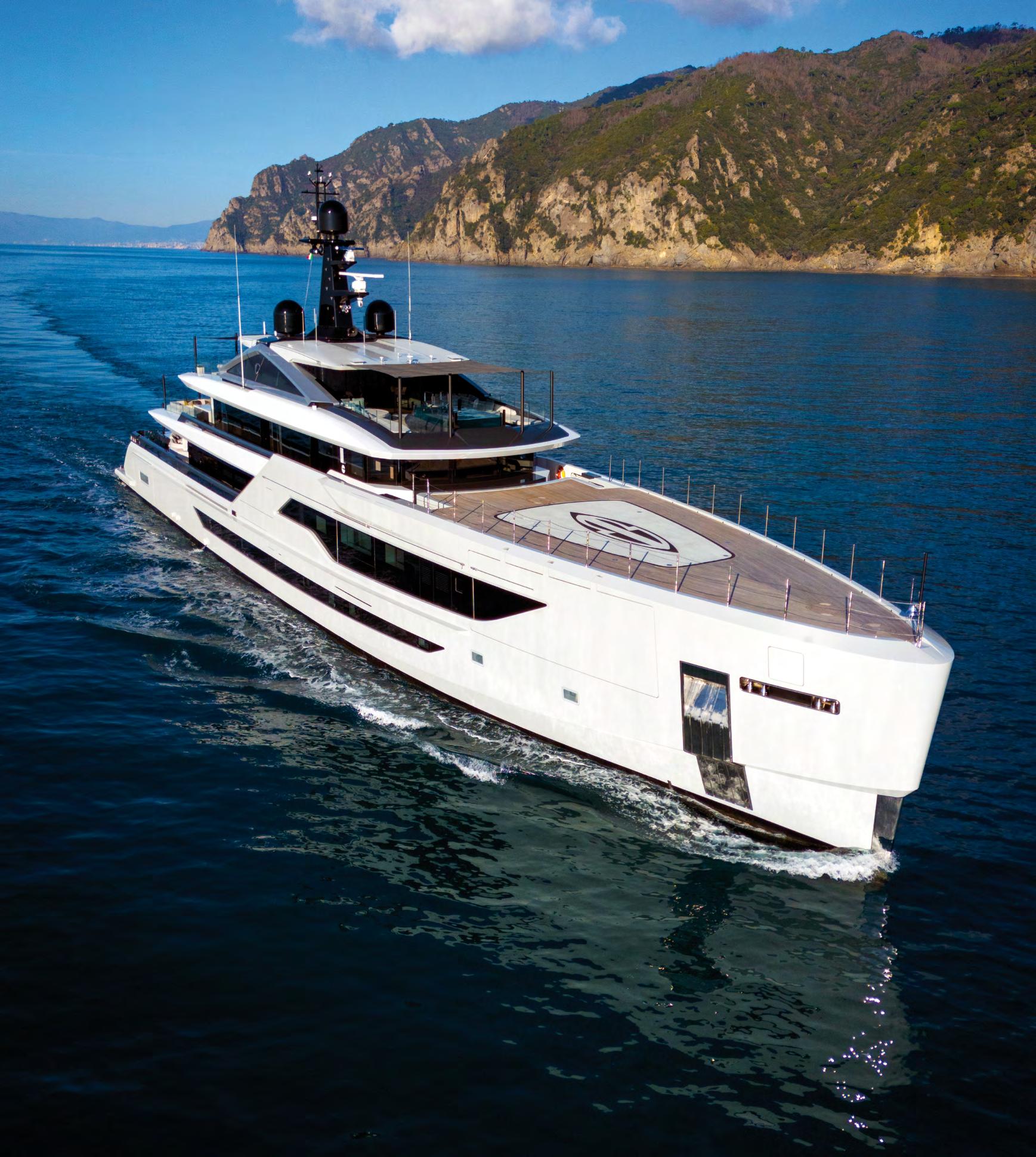
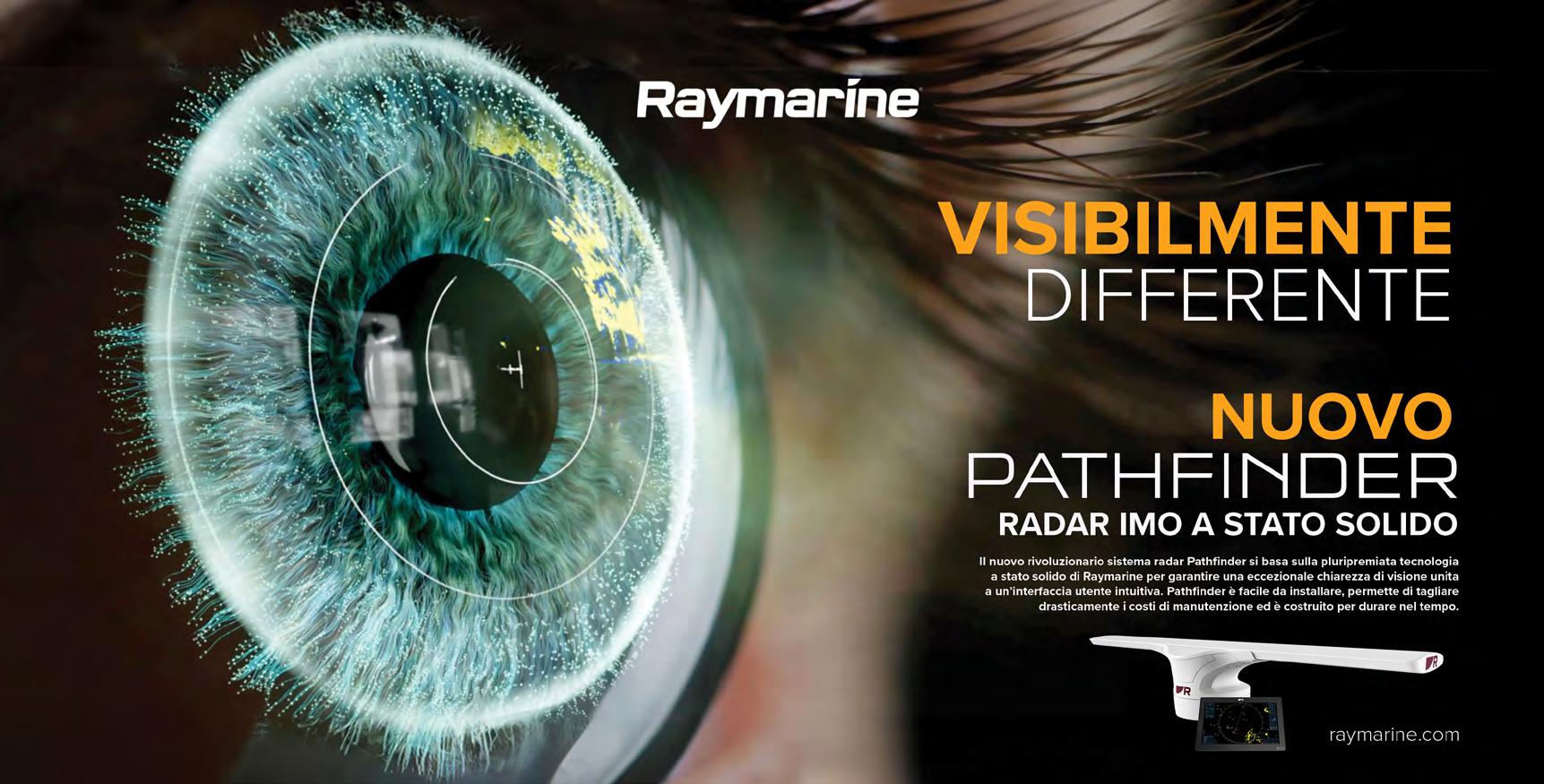
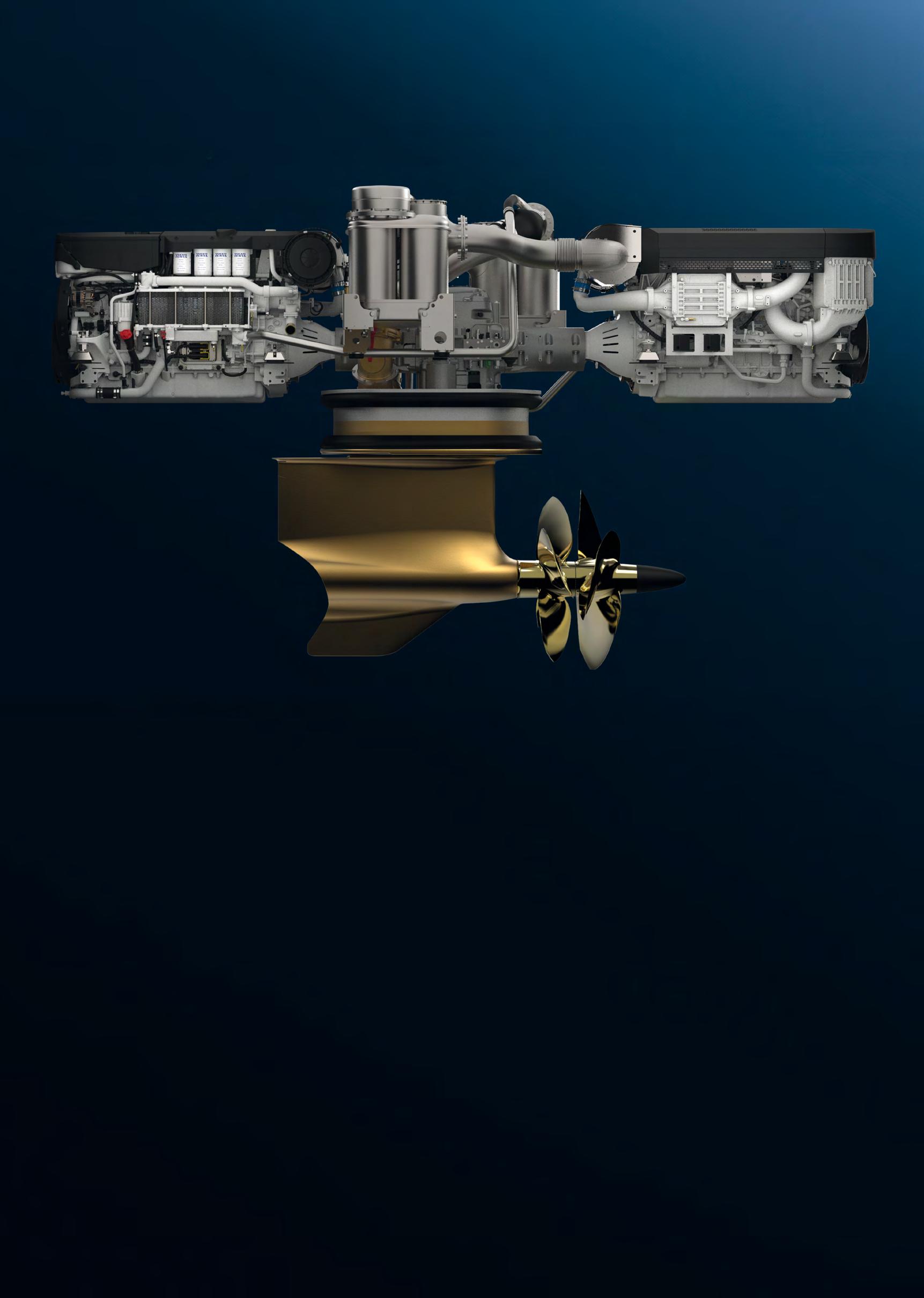






- alBErto Mariotti -
uscire dal porto senza fumi. accedere a zona protette. vivere e navigare con meno rumore e vibrazioni. sfruttare una maggiore efficienza energetica a bordo. sebbene la propulsione elettrica/ibrida - protagonista del nostro focus innovazione e sostenibilità di questo terzo numero di yacht upstream - sia ormai una realtà per alcuni cantieri e armatori, fatica ancora a diffondersi in modo capillare e ad essere considerata una valida alternativa al motore a combustione. i motivi sono diversi: costi maggiori, scarsa diffusione dei punti di ricarica, un certo timore di rimanere a secco di energia, una maggiore complicazione non sempre facile da gestire da comandanti ed equipaggi e una normativa ancora incompleta. sono questi i temi e le risposta che abbiamo approfondito nel nostro focus. superyacht, imbarcazioni e natanti hanno esigenze molto diverse e non esiste un’unica soluzione che le soddisfi tutte. la propulsione full electric pura è infatti appannaggio soprattutto delle barche medio/piccole, per le quali l’investimento è più gestibile così come l’autonomia di navigazione. nelle più grandi si parla di soluzioni ibride i cui benefici riguardano più il comfort di bordo per trascorrere una giornata con tutti i servizi hotel a disposizione ma senza dover accendere motori o generatori con i loro fumi e avere la possibilità di muoversi in porto o altre aree senza inquinare. Mentre gran parte dei cantieri si propone come “integratore di sistemi”, lo sviluppo di modelli ibridi è affidato a pochi ma visionari armatori che decidono di investire in tecnologia per avere uno yacht più sostenibile e attuale al momento della vendita. in questo panorama l’anello debole della catena sono le infrastrutture, ovvero i punti di ricarica veloce la cui diffusione è più lenta del previsto. anche nella grande vela le applicazioni elettriche stanno trovando spazio e al riguardo è interessante il commento di Giovanni Pomati (arrivato in chiusura del numero), a.d. di nautor swan, sull’esperienza fatta con il primo swan 88 ibrido: “non è soltanto una propulsione più verde, la barca è molto più silenziosa: anche quando si naviga con i generatori accesi per ricaricare le batterie e avere un range più ampio il rumore è minore di quello del motore a combustione. E poi meno vibrazioni, che per il comfort è fondamentale, la loro ricerca è sempre stata un’attività importante per noi. inoltre abbiamo scoperto che lavorando bene con l’energy management system, ovvero l’utilizzo del motore elettrico quando si naviga a vela, si genera moltissima energia totalmente verde”. nel focus trovate gli interventi di alcuni dei principali protagonisti, sia dei cantieri sia dei produttori di tecnologia e servizi: a zimut con la prova del nuovo seadeck 7 Hybrid in collaborazione con volvo Penta, Baglietto con il progetto a idrogeno Bzero, silent yachts, Fpt industrial, vetus, vukan, Frauscher, repower, s aim Marine e aqua superPower.
leaving the harbor without fumes. accessing protected areas. living and sailing with less noise and vibration. Benefiting from greater onboard energy efficiency. although electric/hybrid propulsion-the focus of our “innovation and s ustainability” featured in this third issue of Yacht upstream-is already a reality for some shipyards and owners, it is still struggling to gain widespread traction and to be seen as a real alternative to combustion engines. there are several reasons for this: higher costs, limited charging infrastructure, fear of running out of power, added complexity that isn’t always easy for captains and crews to manage, and a regulatory framework that remains incomplete. these are the topics and answers we’ve explored in our feature. s uperyachts, yachts, and small boats have very different needs, and there’s no one-size-fits-all solution. Pure full-electric propulsion is mainly suited to medium and small boats, where the investment is more manageable and range is less of an issue. For larger vessels, we’re talking about hybrid solutions, which mainly offer benefits in terms of onboard comfort-letting guests enjoy a full day with all hotel-style services available without running engines or generators, and enabling movement within ports or protected areas without causing pollution. while most shipyards position themselves as “system integrators,” the development of hybrid models is being driven by a few visionary yacht owners who choose to invest in technology to make their yachts more sustainable-and more appealing at the time of resale. in this scenario, the weakest link in the chain is infrastructure-specifically, fast-charging stations, whose rollout is progressing more slowly than expected. even in the world of large sailing yachts, electric applications are starting to gain ground. o n this topic, the remarks from Giovanni Pomati, ceo of nautor swan, regarding their experience with the first hybrid swan 88 (shared at the end of this issue), are particularly insightful: “it’s not just about greener propulsion-the yacht is also significantly quieter. even when sailing with the generators running to recharge the batteries and extend the range, the noise is noticeably lower than that of a combustion engine. and then there are fewer vibrations, which is essential for comfort-minimizing them has always been an important focus for us. we also discovered that with proper use of the energy management system-specifically, using the electric motor while under sail-it’s possible to generate a large amount of completely green energy”. in the feature, you’ll find insights from some of the key players-both shipyards and technology and service providers: a zimut, with the test of the new s eadeck 7 hybrid in collaboration with Volvo Penta; Baglietto, with the Bzero hydrogen project; as well as s ilent Yachts, FPt industrial, Vetus, Vukan, Frauscher, repower, s aim Marine, and aqua superPower.

EDITORIALE | EDITORIAL
BOAT
Tankoa Diamond Binta
PEOPLE
Capt. Luca Mosca
PEOPLE
Simona Giorgetta
FOCUS INNOVATION&SUSTAINABILITY
Filippo Rossi – Azimut Yachts
FOCUS INNOVATION&SUSTAINABILITY
Test Azimut Seadeck 7 Hybrid FOCUS
FOCUS INNOVATION&SUSTAINABILITY
Alessandro Mor – Fpt Industrial
FOCUS INNOVATION&SUSTAINABILITY
Matteo Zangrandi – Vulkan Italia
FOCUS INNOVATION&SUSTAINABILITY
Mauro Feltrinelli - Frauscher
FOCUS INNOVATION&SUSTAINABILITY
FOCUS INNOVATION&SUSTAINABILITY
Roberto Tummolo – Saim Marine
FOCUS INNOVATION&SUSTAINABILITY
Michele Bolpagni – Aqua superPower
FOCUS LUXURY TENDER
Capt. Gabriele Carniglia
FOCUS LUXURY TENDER
News Anvera
FOCUS LUXURY TENDER
News
TEST
Wallyrocket 51
TEST
Grand Soleil Blue
SUPER YACHT 24 - ALOCIN MEDIA - Piazza Roberto Baldini 4/66, 16149 Genova +39 010 9703071 | info@alocinmedia.it
EDITOR IN CHIEF: Nicola Capuzzo | capuzzo.nicola@gmail.com +39 334.788.9863
CO-EDITOR IN CHIEF: Alberto Mariotti | mariotti@superyacht24.it + 39 328.29.37.133
PROGETTO GRAFICO: Claudia Giorgini
CONTRIBUTORS: Cinzia Garofoli, Alberto Mariotti, Giuseppe Orrù
COVER PHOTO: Tankoa Diamond Binta, photo by Josh Breed Media
ADVERTISING & MARKETING: Per informazioni sulle opportunità di marketing, pubblicità e visibilità For information on marketing, advertising and visibility opportunities Sabrina Carozzino | marketing@alocinmedia.it | + 39
Emanuele Buffa di Perrero | ebuffa@link-media.com | + 39 335.649.4152
Nel mondo della nautica la gestione dei rischi non è solo una necessità: è un elemento essenziale per garantire la serenità di armatori, comandanti e cantieri. Aon, azienda leader a livello globale nell’intermediazione assicurativa e nella consulenza per la gestione dei rischi, offre soluzioni su misura per il settore yacht & superyacht, combinando presenza internazionale, competenza tecnica e una conoscenza profonda delle dinamiche del settore marittimo. Grazie a una rete globale con uffici in tutto il mondo e al supporto dell’Aon Global Yacht Team, basato a Londra, Aon è in grado di offrire un servizio capillare e costante, ovunque sia lo yacht, in qualunque momento. Ma è in Italia che Aon ha creato un centro di eccellenza per il settore nautico: il team specializzato della sede di Ancona è un punto di riferimento per armatori, capitani, cantieri costruttori e riparatori.
La squadra italiana affianca quotidianamente i clienti nella strutturazione e gestione delle principali coperture assicurative: dalle polizze Hull & Machinery alle coperture P&I, dal Crew Welfare alle polizze Builder’s Risks e Ship Repairers Legal Liability. Ogni copertura è pensata per rispondere a esigenze specifiche: che si tratti di proteggere l’equipaggio, tutelare l’investimento durante una costruzione o garantire continuità operativa durante un refit, Aon costruisce soluzioni su misura, avvalendosi di una profonda conoscenza normativa, tecnica e contrattuale.
In un settore in costante evoluzione, Aon non si limita all’intermediazione assicurativa, ma propone strategie di gestione del rischio proattive, integrate e innovative e lo fa con la forza di un network internazionale e la competenza di team locali altamente specializzati. Scegliere Aon significa navigare con un partner affidabile, competente e sempre pronto a fare rotta verso la sicurezza.
ARTICOLO
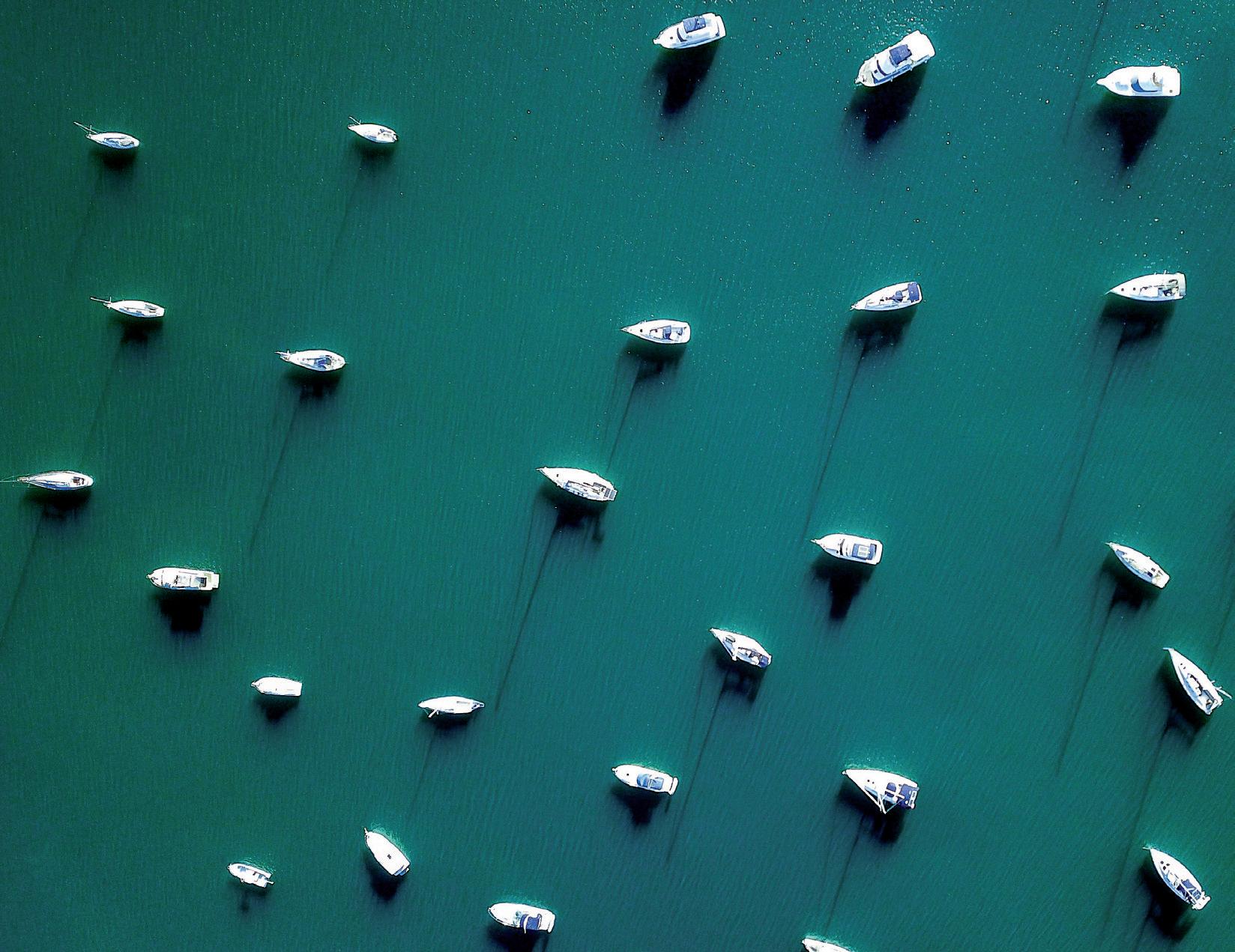
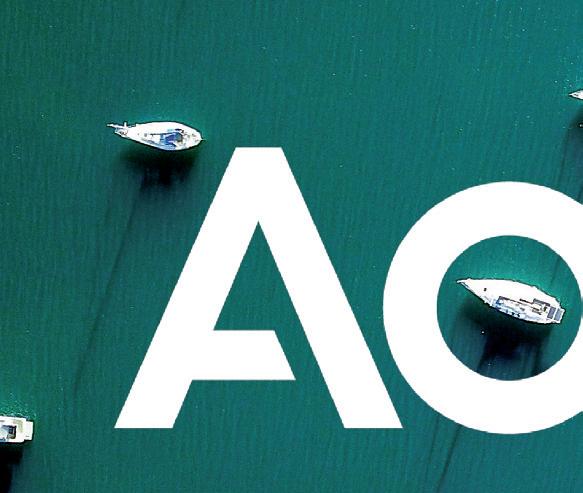

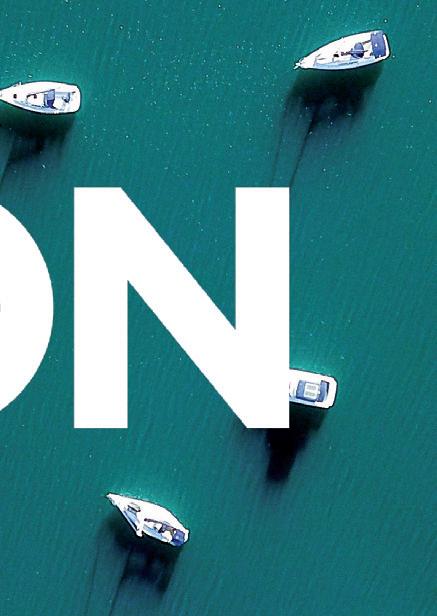
Per approfondimenti contatta Paolo Mascino, Yacht Unit Director di Aon, all’indirizzo e-mail: paolo.mascino@aon.it
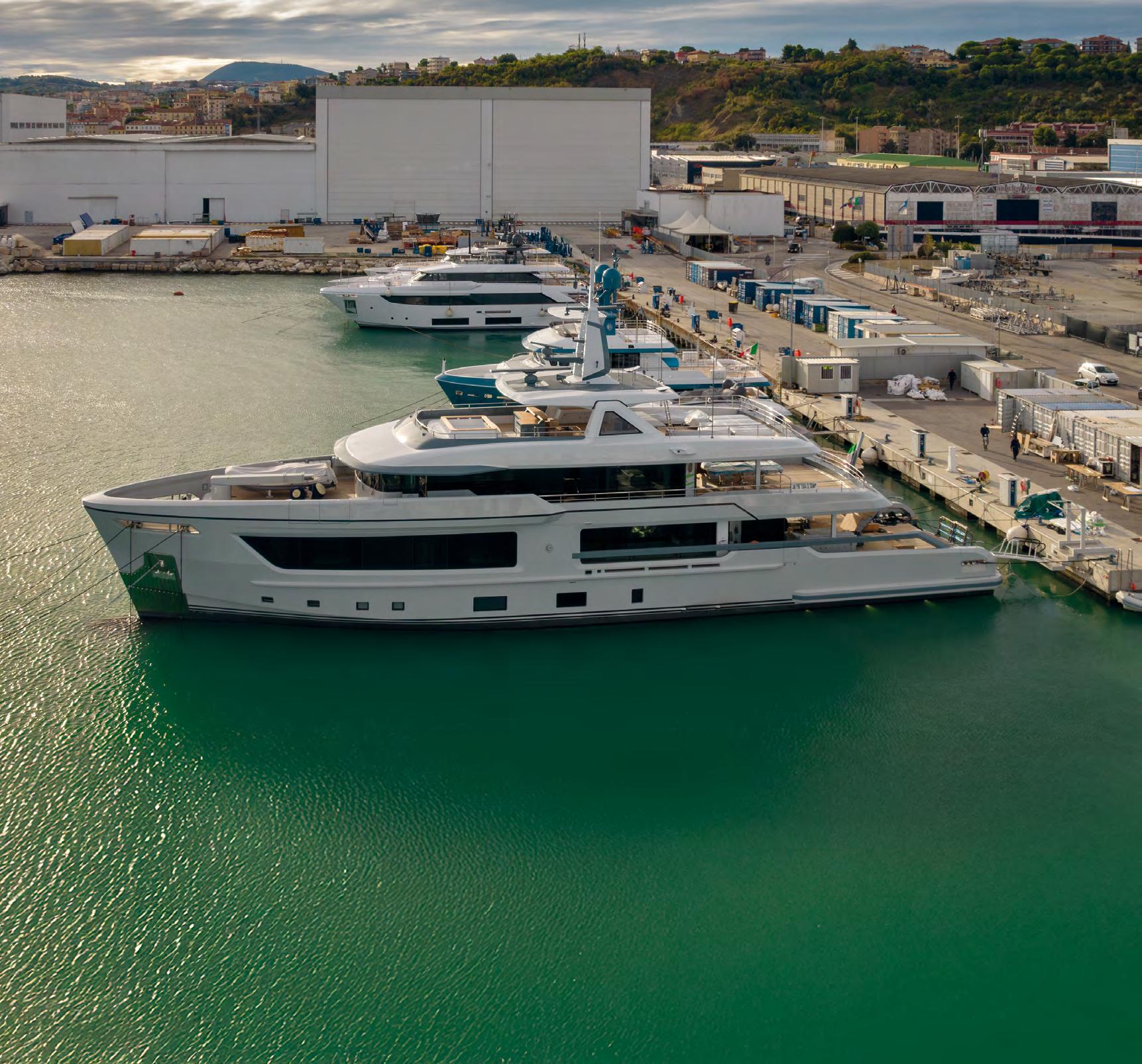
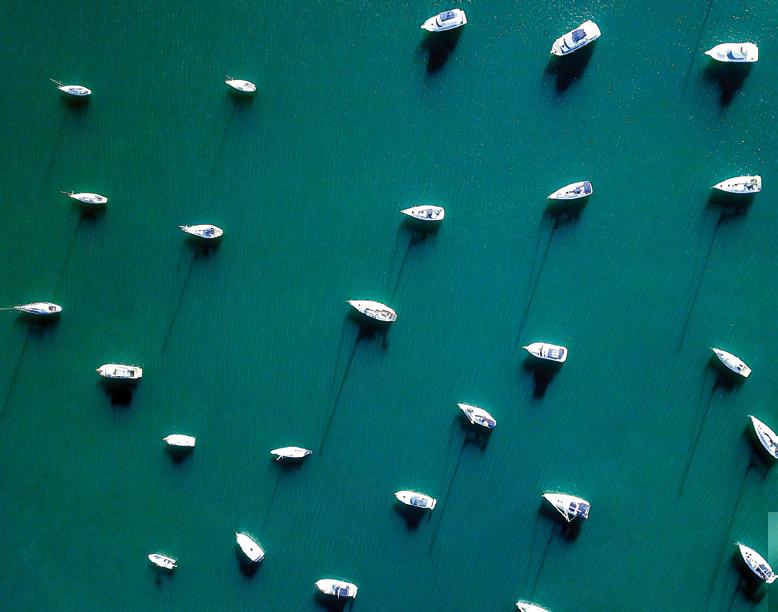

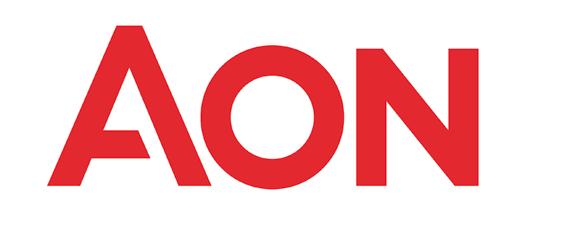
Nel cuore del Mare Adriatico Centrale, il porto di Ancona è un’eccellenza mondiale nella cantieristica di lusso che crea valore, occupazione e futuro.
Qui nascono yacht e megayacht iconici, frutto di maestria artigianale, design visionario e tecnologie all’avanguardia.
Sistema Portuale del Mare Adriatico Centrale: dove la bellezza prende forma per viaggiare lontano.
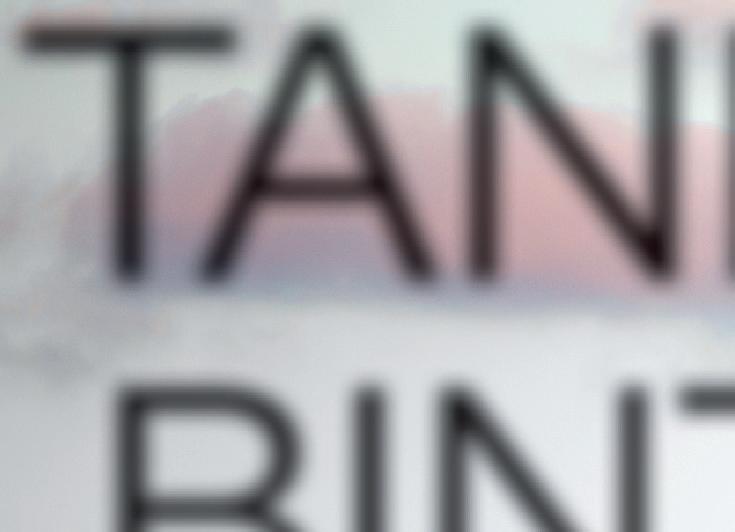

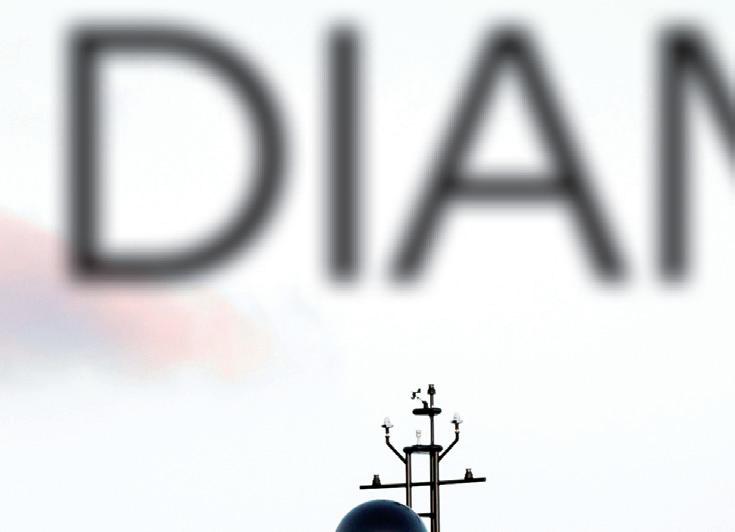

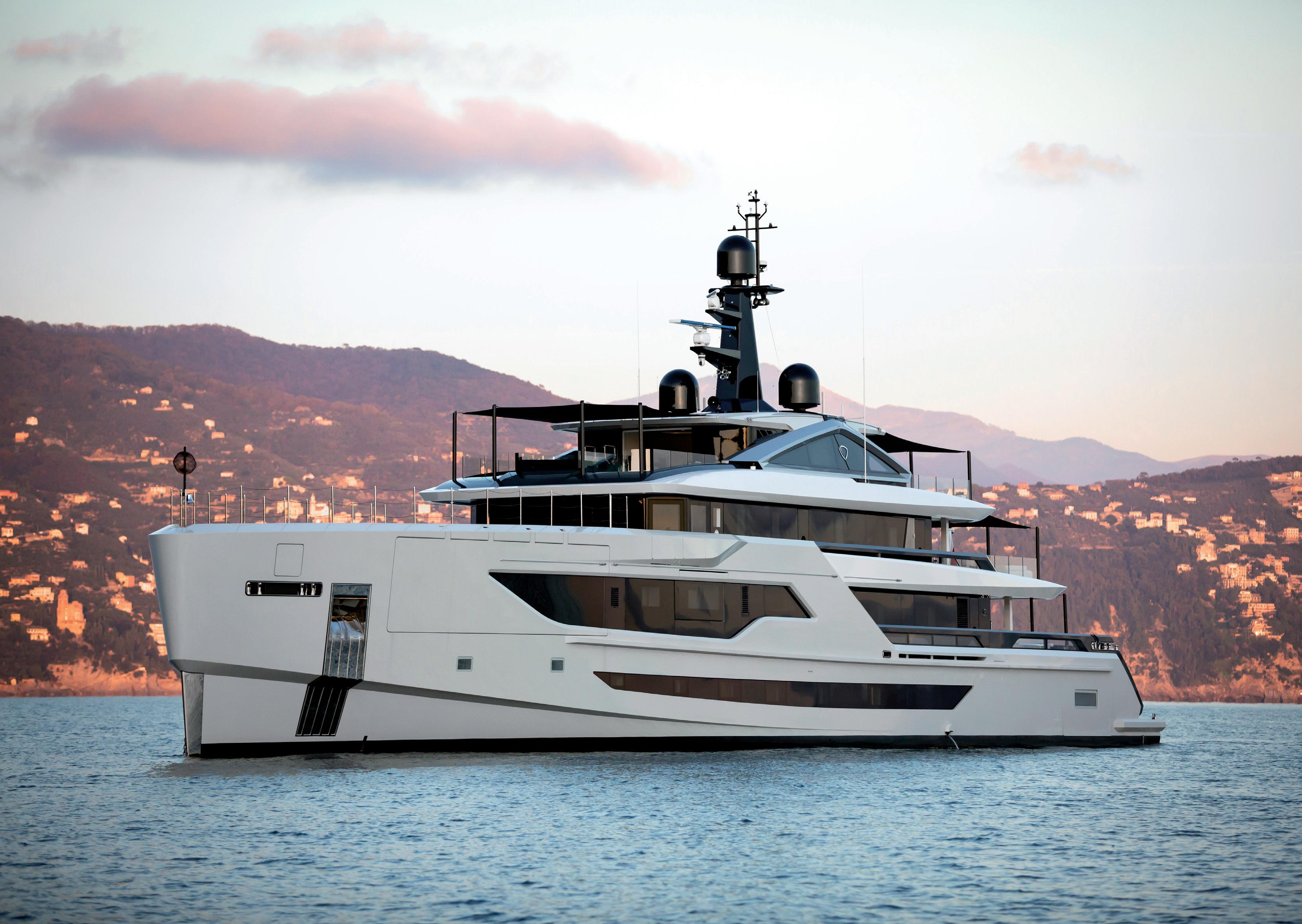
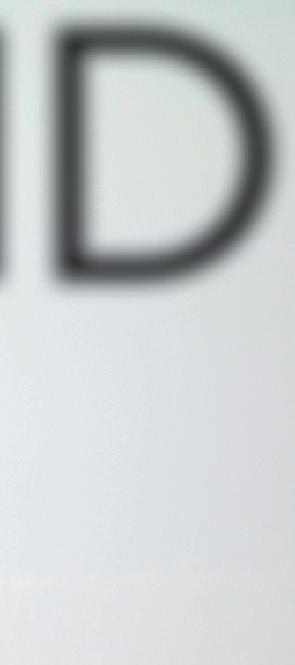
INTERVISTA AL PROJECT MANAGER DELLO YACHT PER ENTRARE NEI DETTAGLI TECNICI E COSTRUTTIVI DI QUESTO 58 METRI CHE VANTA UNA PERCENTUALE ELEVATISSIMA DI AZIENDE E FORNITORI ITALIANI E DEL TERRITORIO LIGURE
INTERVIEW WITH THE YACHT’S PROJECT MANAGER TO DELVE INTO THE TECHNICAL AND CONSTRUCTION DETAILS OF THIS 58-METRE SUPERYACHT, WHICH BOASTS AN EXCEPTIONALLY HIGH PERCENTAGE OF ITALIAN COMPANIES AND SUPPLIERS INVOLVED FROM THE LIGURIAN REGION
Consegnato nell’estate del 2024, Diamond Binta è uno yacht full custom creato per un cliente del cantiere che aveva già posseduto il 50 metri S501 Bintador. La visione era costruire uno yacht più grande, progettato per affrontare crociere a lungo raggio. Le linee sono di Francesco Paszkowski con la collaborazione di Margherita Casprini per gli interni. SUPER YACHT 24 ha intervistato il direttore generale della Tankoa Yachts SpA nonché project manager Edoardo Ratto che racconta alcuni importanti dettagli tecnici e costruttivi di questo 58 metri che si distingue anche per la percentuale elevata di aziende e fornitori italiani e del territorio ligure.
Quali sono state le principali sfide ingegneristiche nella progettazione e costruzione dello yacht?
“La prima è il corridoio che collega la zona ospiti alla beach area e che divide in due la sala macchine. Il corridoio è climatizzato, ha finiture luxury e permette di osservare motori e impianti, soluzione che ha comportato diverse complicazioni ingegneristiche riguardo al raffreddamento e alla ventilazione della sala macchine per rispettare i regolamenti, renderne confortevole l’attraversamento e dare al locale un impatto scenografico importante. Non penso siano tanti gli yacht che permettano di vedere una zona solitamente celata agli ospiti”. È stata una richiesta dell’armatore?
“Sì, ha voluto una beach area importante, dotata di balconi apribili che la trasformano in un grande salone al livello del mare e accessibile direttamente dalla zona ospiti senza troppi sali/scendi in giro per lo yacht”.
Delivered summer 2024, Diamond Binta is a fullcustom yacht built for a returning client of the shipyard, who previously owned the 50-meter S501 Bintador. The vision was to create a larger yacht designed for long-range cruising. The lines are by Francesco Paszkowski, with interior design by Margherita Casprini. SUPER YACHT 24 interviewed Edoardo Ratto, General Manager of Tankoa Yachts SpA and also the project manager, who shared key technical and construction details of this 58-metre vessel, which also stands out for its high percentage of Italian companies and suppliers from the Ligurian region.
What were the main engineering challenges in designing and building the yacht?
“The first was the corridor that
connects the guest area to the beach area, cutting right through the engine room. The corridor is air-conditioned, finished to luxury standards, and allows guests to view the engines and onboard systems. This layout led to several engineering challenges regarding the cooling and ventilation of the engine room - to comply with regulations, ensure a comfortable passage for guests, and give the space a strong scenic impact. I don’t think many yachts offer a view into an area usually hidden from guests”. Was it a request from the owner?
“Yes, he wanted a significant beach area with fold-out balconies that turn it into a large sealevel lounge, directly accessible from the guest area without the need to go up and down all over

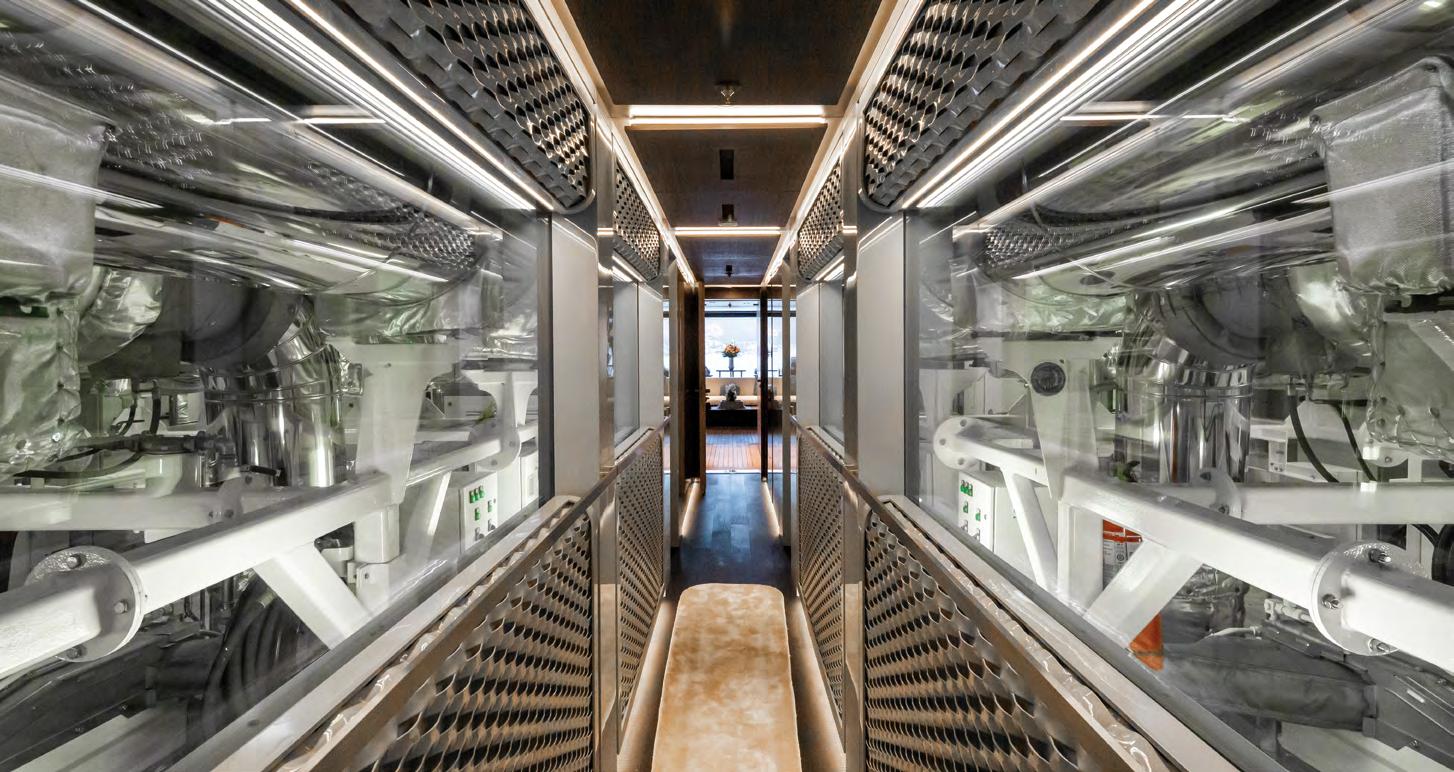
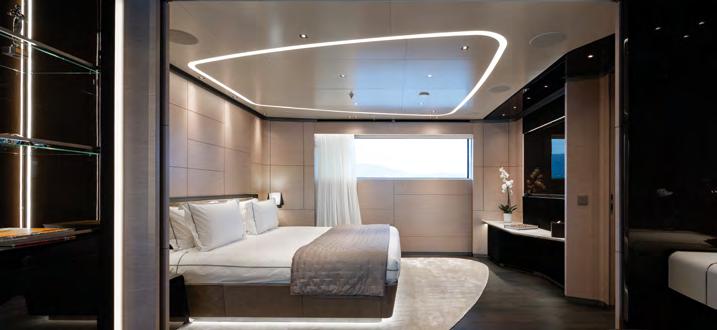
La componente più importante di questo locale?
“I vetri, li abbiamo studiati appositamente per svolgere soprattutto due funzioni: resistere a temperature elevate e abbattere il rumore. sono stati realizzati certificati a60 dalla pocadel. Le altre vetrature a bordo di questa unità sono state realizzate dalla maritan Glass che, insieme alla Viraver, sono le due aziende con le quali collaboriamo al momento”.
Quali materiali sono stati usati per la costruzione?
“Date le dimensioni, prestazioni e la forma di carena non abbiamo dovuto eccedere nella scelta di materiali super alleggeriti o particolari. Lo scafo è in acciaio navale ad alta resistenza mentre la sovrastruttura è in alluminio”.
Parliamo della certificazione.
“Lo yacht è certificato dal Lloyd’s register e ha ottenuto la certificazione 100 a1 ssC Yacht mono G6 Lmc, quindi la classe massima che si può avere per stazza al di sopra delle 500 tonnellate, è quindi full compliant all’utilizzo commerciale e lo yacht batte bandiera maltese. Con il Lloyd’s abbiamo curato tutti gli aspetti di sicurezza, classe, gestione e sorveglianza, siamo soddisfatti del lavoro svolto”.
Che tipo di propulsione ha lo yacht?
“È la seconda sfida tecnologica di Diamond Binta, che può navigare lasciando spenti i generatori ausiliari: yacht di questa dimensione navigano di solito con uno se non due generatori accesi. Diamond Binta è equipaggiato con due motori Caterpillar 3512 da 1.350 kW a 1.600 giri accoppiati a due motori elettrici per navigare in modalità ‘alternatore-asse’. Nelle lunghe navigazioni i motori principali alimentano quindi quelli elettrici e gli alternatori generano la potenza elettrica necessaria al funzionamento dei servizi hotel, lasciando così spenti i generatori. La propulsione è quindi sfruttata sia per spingere la barca sia per produrre energia di bordo. anche i generatori sono Caterpillar, due Cat 7.1 acer da 118 ekW più un Cat 4.4 da 86 ekW per l’emergenza. alternatori e motori elettrici sono invece fornita da Cgt e realizzati dall’azienda tedesca reintjes. Chi ha lavorato all’impianto elettrico?
Il Bacchetto, un artigiano elettrico della zona che collabora con noi da molti anni che si è coordinato con la Cgt (distributore italiano di Caterpillar), reintjes e Comap per la
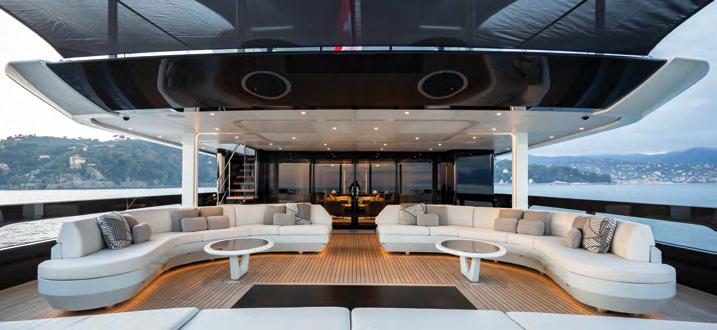
the yacht”. What’s the most important feature of that space?
“The glass. We specifically designed it to fulfill two key functions: withstanding high temperatures and reducing noise. It’s A60certified and was produced by Pocadel. The rest of the glazing on board was supplied by Maritan Glass which, along with Viraver, is one of the two companies we’re currently working with”. What materials were used in the construction?
“Given the yacht’s size, performance, and hull shape, we didn’t need to go overboard with ultralight or exotic materials. The hull is made of high-strength marine steel, while the superstructure is aluminum”.
Let’s talk about the certification.
“The yacht is certified by lloyd’s Register and has obtained the 100 A1 SSC yacht Mono G6 lmc notation, which is the highest classification available for vessels over 500 gross tons. This means it is fully compliant for commercial use, and the yacht sails under the Maltese flag. Together with lloyd’s, we oversaw every aspect related to safety, class, management, and monitoring, and we’re
very satisfied with the work done”. What about propulsion?
“ This is the second major technological challenge of Diamond Binta, which can sail with its auxiliary generators turned off. yachts of this size usually cruise with one, if not two, generators running. Diamond Binta is equipped with two Caterpillar 3512 engines producing 1,350 kW at 1,600 rpm, paired with two electric motors that allow for ‘shaft alternator’ mode. During long-range cruising, the main engines power the electric motors, and the alternators generate the electricity needed for hotel services - allowing the generators to remain off. So, propulsion is used not only to move the yacht but also to produce onboard energy. The generators are also from Caterpillar - two Cat 7.1 Acer units producing 118 ekW each, plus a Cat 4.4 unit delivering 86 ekW for emergencies. The alternators and electric motors were supplied by CGT and manufactured by the German company Reintjes”. Who worked on the electrical system?
“Il Bacchetto, an electrical craftsman from the area who’s been working with us for years, coordinated with CGT (the Italian Caterpillar distributor), Reintjes, and
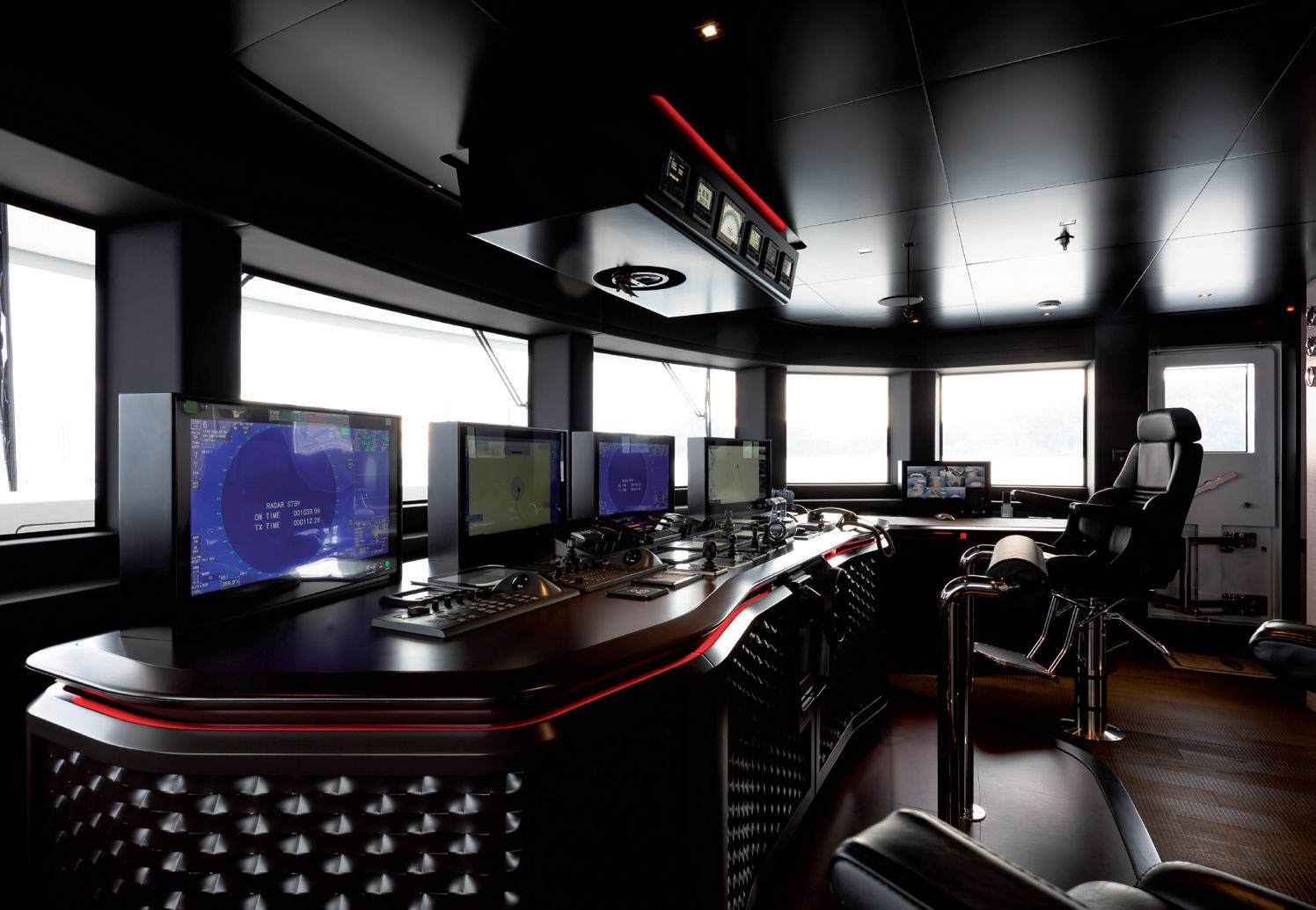
parte del controllo e della gestione delle sorgenti e dei carichi. Tutto si basa sulla gestione tramite due Ups piuttosto importanti, sono sistemi di immagazzinamento dell’energia che garantiscono l’erogazione della corrente e correggono eventuali disservizi. Inoltre il sistema Caterpillar/Reintjes ha permesso di contenere dimensioni e potenza dei due generatori ausiliari”. Passiamo ai principali impianti dello yacht.
“Per quanto riguarda stabilizzatori ed elica di prua abbiamo usato Naiad Dynamics, importati in Italia da Samos, azienda genovese che ha seguito anche i sistemi di tonneggio e la timoneria con il brand Opem Sistemi. Su altri progetti lavoriamo anche Cmc Marine e Quantum. Qui abbiamo installato quattro pinne elettriche zero speed”. Lo yacht ha tanti portelloni, chi li ha realizzati?
“Abbiamo un importante accordo con l’azienda Cosnav di La Spezia che si occupa di diversi aspetti: costruzione di carpenteria e saldatura di scafo e sovrastruttura, preallestimento di carpenteria, meccanica, linee d’asse, astucci e porta eliche. Realizza inoltre i portelloni, che su questo yacht hanno rappresentato una grande sfida: ce ne sono due enormi a prua nel garage che comprende anche il carroponte per il varo e alaggio di limotender e tender, poi quelli di poppa della beach area oltre a passerella e scala reale. Diamond Binta ha il ponte di prua chiuso e la zona di manovra è incassata, anche qui ha realizzato due portelloni che si aprono per dare visibilità sui salpancora”.
Lo yacht ha anche un ponte elicottero.
“Sì, è stato realizzato dall’azienda genovese Api che non solo ha applicato la resina della superficie, ma ha anche riprodotto il logo dell’armatore. Per la verniciatura, come tradizione Tankoa, abbiamo un ciclo misto con antivegetativa e stucchi Boero, finiture di International Yacht Paint o DuPont. Il ponte in teak è stato invece realizzato da un’azienda storica per Tankoa,
la Emmegi Marine di Vado Ligure mentre le porte scorrevoli della veranda sul fly e quelle laterali sono di Steel Works di Genova”. Altre importanti collaborazioni?
“Ne abbiamo diverse con anche qualche nome internazionale. Le più importanti sono quelle con la già citata Cosnav e con la Ve.Ga Yachts di Albissola per la verniciatura dello yacht. Per i sistemi di navigazione e entertainment lavoriamo con Faser di Varazze e Furuno per i principali strumenti elettronici. Su Diamond Binta abbiamo inoltre alcune collaborazioni storiche: Ocreni Project di La Spezia, che ha realizzato gran parte degli impianti idraulici, e Aquarius di La Spezia per la parte oleodinamica. Gli arredi luxury sono opera di Cantù Contract mentre la parte equipaggi è stata seguita dalla ditta Lisi Arredamenti di Genova. Per quanto riguarda i dissalatori lavoriamo da sempre con Idromar di San Giuliano Milanese. Per le eliche lavoriamo con Detra, azienda genovese al 100% mentre le luci di via sono 4C del gruppo Cantalupi. Montiamo da sempre i tergicristalli Speich di Genova e per le trombe lavoriamo con il brand storico Kahlenberg. Per l’arredo abbiamo nomi del calibro di Minotti, Zunino Marmi, Altraluce per l’illuminazione, Poltrona Frau, Talenti, Roda, Yachtica, Varaschin, TechnoGym e su questo yacht anche Giobagnara. Tutti i tendali sono Multiplex, un’azienda tedesca che riteniamo al top per questo accessorio. Dariel, cantiere di Palazzolo sull’Oglio (BS), ha invece realizzato i mezzi di supporto: un limotender di circa 9 metri con gli stessi colori e finiture dello yacht e un tender classico di 7,5 metri”.
Chiudiamo con un accenno alle prestazioni dello yacht.
“Diamon Binta tocca la velocità massima di 17, ha una velocità economica di 12.5 nodi e un range di oltre 5.400 miglia nautiche, quindi ha un’ottima autonomia grazie anche al risparmio di ore di moto sui generatori”.
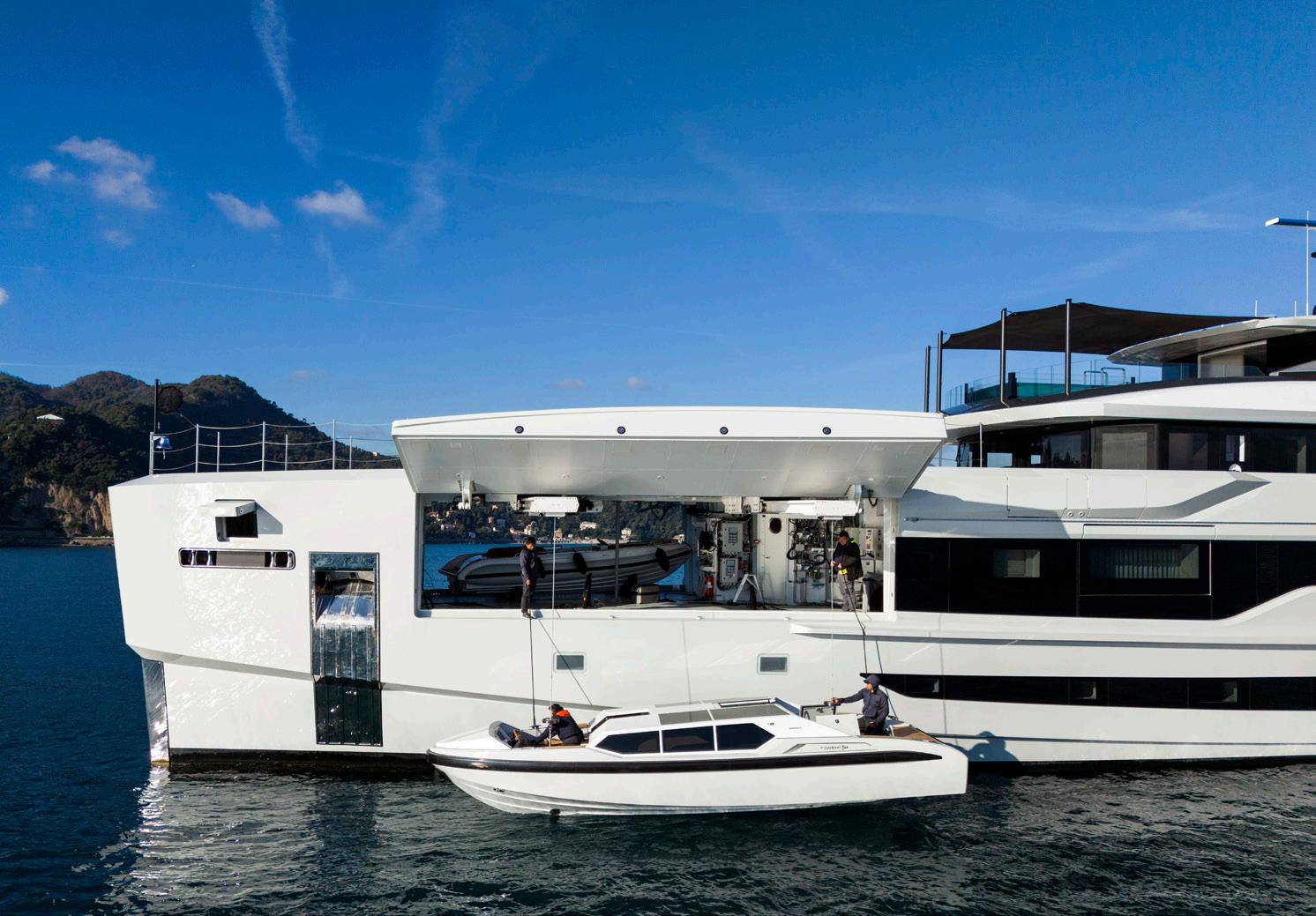
Comap for the control and power management systems. Everything is managed through two significant uPS units - these are energy storage systems that ensure power delivery and correct any faults or interruptions. Moreover, the Caterpillar/Reintjes setup allowed us to reduce the size and power of the two auxiliary generators”. Let’s move on to the yacht’s main systems.
“For the stabilizers and bow thruster, we used Naiad Dynamics, imported into Italy by Samos, a Genoa-based company that also handled the mooring systems and steering gear through the Opem Sistemi brand. On other projects we also work with CMC Marine and Quantum. For this yacht, we installed four electric zero-speed fins”.
The yacht has several hatches - who built them?
“We have a key partnership with Cosnav, a company based in la Spezia, which handles various aspects: hull and superstructure metalwork and welding, prefittings for structural components, mechanics, shaft lines, stern tubes, and propeller supports. They also build the hatches, which were a major challenge on this yacht. There are two huge hatches forward in the garage, which also houses the overhead crane for launching and retrieving the limo tender and tender, plus the ones aft in the beach area, along with the passerelle and main stairway.
Diamond Binta has an enclosed foredeck, and the mooring area is recessed - here too, Cosnav made two hatches that open to give access to the anchor windlasses”.
The yacht also features a helideck, doesn’t it?
“yes, it was built by the Genoabased company Api, which not only applied the resin surface but also reproduced the owner’s logo. As is customary at Tankoa, the paintwork involves a mixed system using Boero antifouling and fillers, with final finishes by either International yacht Paint or DuPont.
The teak decking was laid by Emmegi Marine, a long-time Tankoa partner from Vado ligure, while
the sliding doors on the flybridge veranda and the side doors were supplied by Steel Works in Genoa”.
Other major collaborations?
“We work with several companies, including a few international names. The most important partnerships are with the already mentioned Cosnav and with Ve.Ga yachts in Albissola for the yacht’s painting. For navigation and entertainment systems, we collaborate with Faser in Varazze and Furuno for the main electronic instruments. Diamond Binta also features some long-standing partnerships: Ocreni Project in la Spezia handled most of the hydraulic systems, while Aquarius, also in la Spezia, was responsible for the hydraulic power systems, The luxury furnishings were crafted by Cantù Contract, while the crew areas were outfitted by lisi Arredamenti in Genoa. We’ve always worked with Idromar in San Giuliano Milanese for the watermakers. The propellers come from Detra, a 100% Genoese company, while the navigation lights are by 4C from the Cantalui Group. We’ve always installed Speich wipers from Genoa and use the historic Kahlenberg brand for the horns.
In terms of furniture and decor, we’ve included top names like Minotti, Zunino Marmi, Altraluce for lighting, Poltrona Frau, Talenti, Roda, yachtica, Varaschin, TechnoGym, and on this yacht also Giobagnara. All the awnings are by Multiplex, a German company we consider to be the best in this category. Dariel, a shipyard based in Palazzolo sull’Oglio (Brescia), built the support vessels: a limo tender of about 9 meters featuring the same colors and finishes as the yacht, and a classic 7.5-meter tender”.
Let’s wrap up with a few words on the yacht’s performance.
“Diamond Binta reaches a top speed of 17 knots, has an economical cruising speed of 12.5 knots, and a range of over 5,400 nautical miles - offering excellent autonomy, also thanks to the reduced generator running hours”.
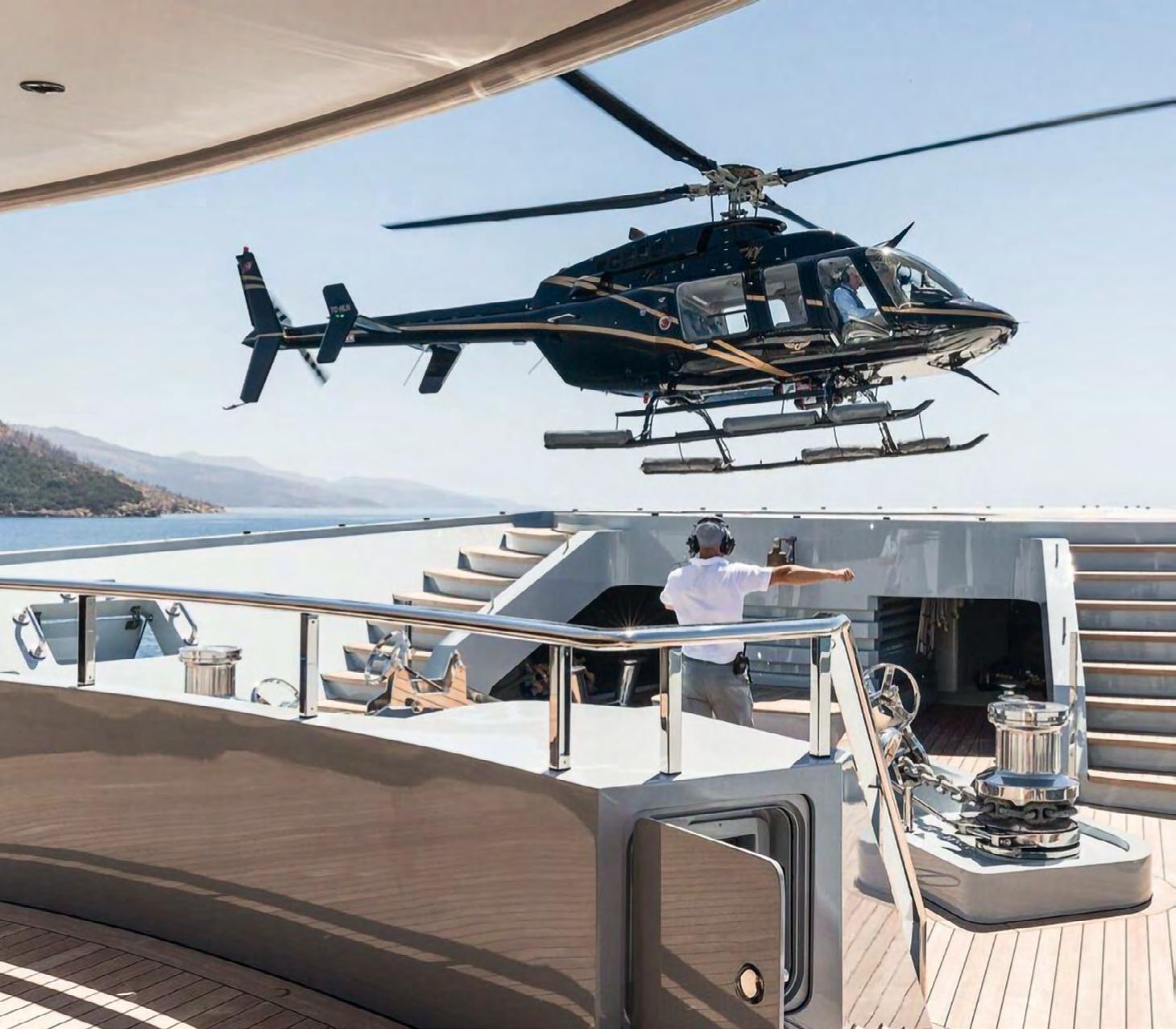
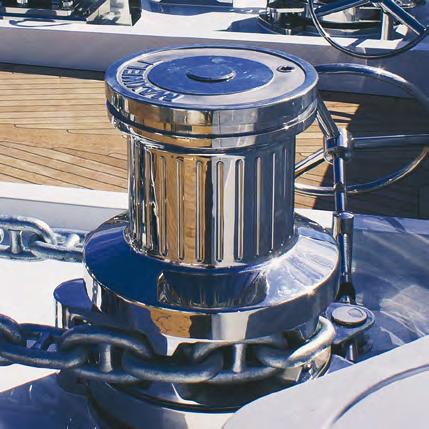
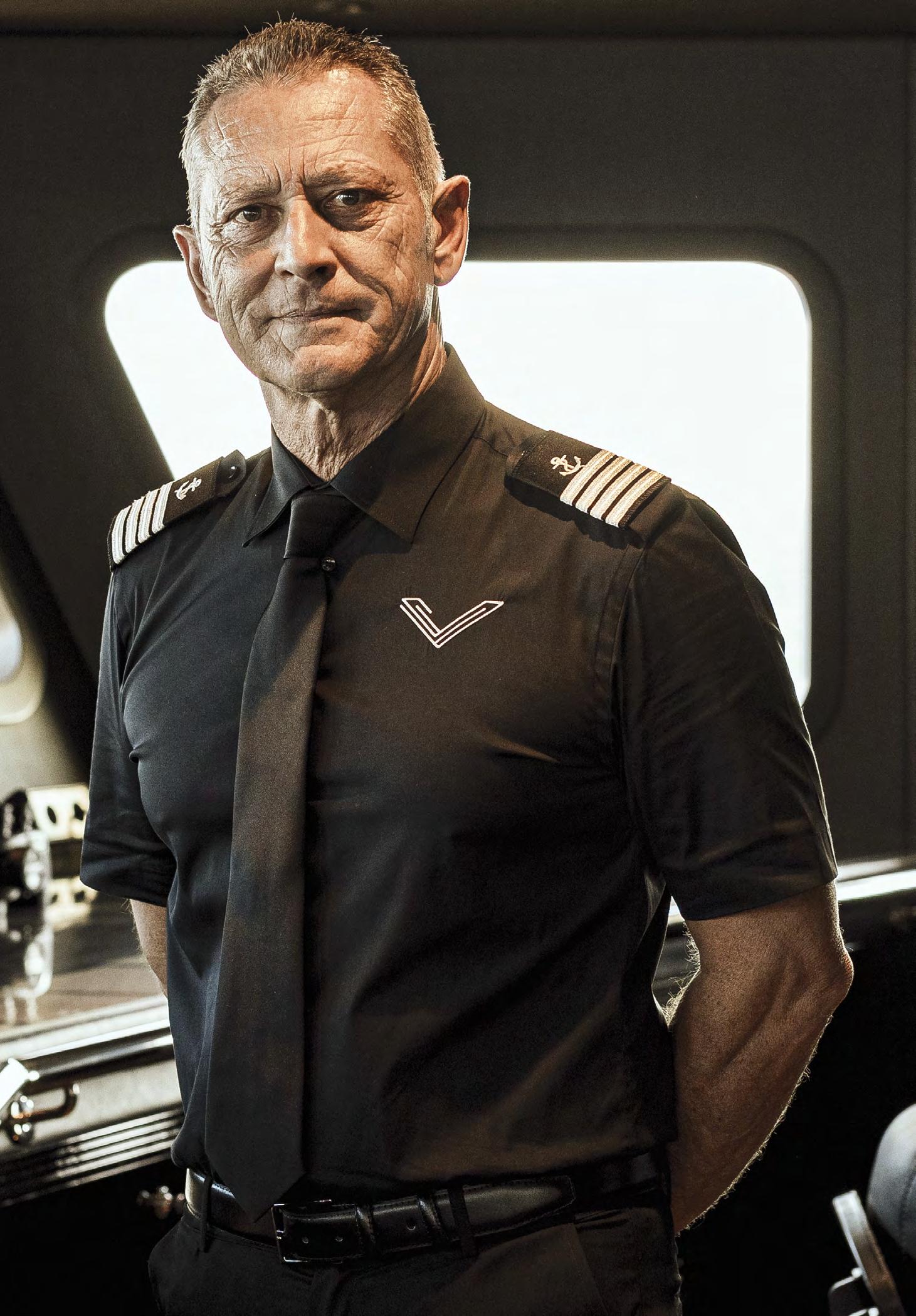
“a ca Ptain is Born, li V es, and dies alone”
lo racconta luca Mosca, coMandantE dEl 97 MEtri lürssEn carintHia vii, cHE Fa il Punto sullE dinaMicHE di Bordo E lE rEsPonsaBilità nElla GEstionE di uno yacHt durantE i Faticosi MEsi di sErvizio so saY s luca Mosca, caPtain oF the 97-Meter lürssen c arinthia Vii, as he reFlects on liFe on Board and the resP onsiBilities inVolVed in ManaGinG a Yacht durinG the deMandinG Months oF serVice
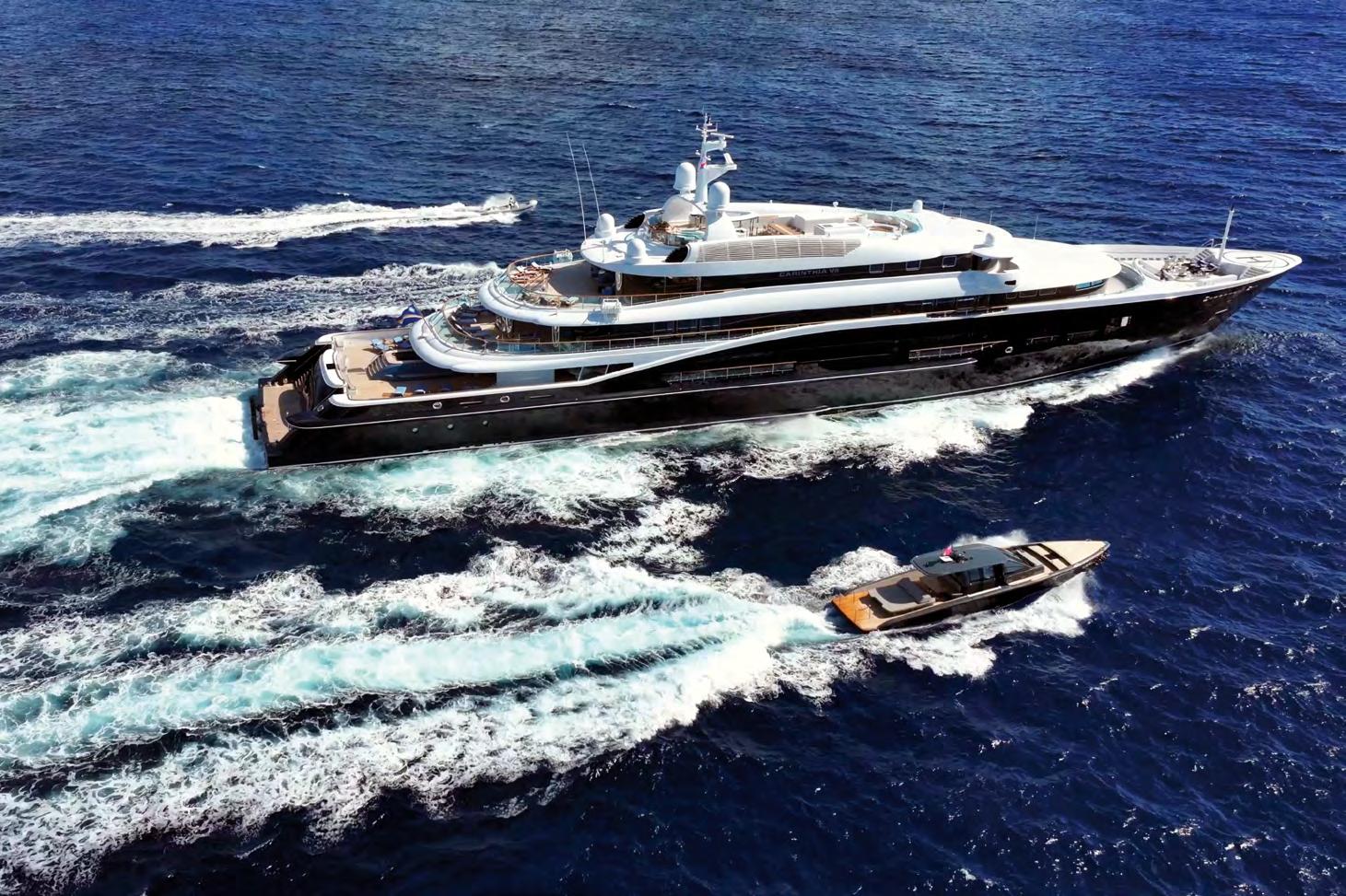
In occasione dell’edizione 2025 di s eaYou che si è svolto al marina aeroporto di Genova, super YaCH t 24 ha avuto la possibilità di incontrare Luca m osca, attuale comandante del 97 metri Lürssen Carinthia VII e di approfondire alcuni temi importanti legati alle dinamiche di bordo di cui aveva parlato come relatore durante il convegno Navigating the truth moderato dalla comandante Kelly Gordon insieme a e mma Kate ross, direttrice e co-fondatrice di s eas the m ind per la salute mentale a bordo. L’argomento del convegno era il confronto tra finzione, spinta dai social e reality show come Below Deck, e realtà nel mondo dello yachting. Comandante qual è la sua opinione su questo genere di programmi?
“Il problema maggiore è gestire le aspettative degli equipaggi, specialmente le nuove generazioni, ragazzi di 20 anni che a volte arrivano a bordo ispirati da programmi come Below Deck di cui, ammetto, non sono un grande fan. Lo yachting è un’industria, una carriera e una professione seria. Non voglio dire che Below Deck abbia avuto un impatto negativo al 100%, parlare di yachting e charter è sempre positivo ed è una grande pubblicità per la nostra industria. ma ripeto, dobbiamo gestire le aspettative di chi sceglie questo tipo di lavoro e si aspetta poi le quelle stesse dinamiche”.
Può farci un esempio?
“Di recente ho ricevuto forti pressioni da un equipaggio a causa del lungo tempo necessario a incassare e distribuire la mancia avuta dopo un charter. s ono serviti mesi di lavoro con la difficoltà di elementi come norme valutarie e antiriciclaggio, trasparenza bancaria, bonifici dall’estero, con 40 persone che tutti i giorni mi chiedevano dove fosse finita la loro mancia, pensando addirittura che comandante e management fossero d’accordo per intascarsela. u n grande stress mentale; alcuni si aspettano alla fine di un charter che tu dia loro 10mila euro in contanti, come magari hanno visto proprio in qualche episodio di Below Deck o letto su qualche post di Facebook, senza conoscere e capire tutte le problematiche connesse”.
Nel convegno si è parlato anche di problemi di carattere sessuale o legati all’abuso di alcol.
“L’alcol è un grande problema e recentemente abbiamo visto le conseguenze del suo abuso con l’incidente accaduto al tender del motoryacht Loon lo scorso dicembre. Lo stesso vale per il sexual harassment a bordo, che a volte è proprio una conseguenza dell’abuso di alcol. per questo e altri motivi e per mia scelta, tutti gli yacht al mio comando sono ‘dry ship’”.
Come si affrontano situazioni del genere?
“Come tutti i problemi bisogna
At the 2025 edition of Sea you, held at the Marina Aeroporto in Genoa, SUPER YACHT 24 had the opportunity to meet luca Mosca, current captain of the 97-meter lürssen Carinthia VII, and delve deeper into important topics related to life on board — issues he had addressed as a speaker during the panel “ Navigating the Truth” , moderated by Captain Kelly Gordon alongside Emma Kate Ross, director and co-founder of Seas the Mind, an organization focused on mental health on board. The panel’s theme centered on the contrast between fiction — fueled by social media and reality shows like Below Deck — and the real world of yachting.
Captain, what is your opinion on these kinds of shows?
“The biggest issue is managing crew expectations, especially among the younger generation — 20-year-olds who sometimes come on board inspired by shows like Below Deck, which, I admit, I’m not a big fan of. yachting is an industry, a career, and a serious profession. I’m not saying that Below Deck has had a 100% negative impact — talking about yachting and chartering is always a good thing, and it’s great publicity for our industry. But again, we must manage the expectations of those who choose this line of work and then expect the same dynamics they’ve seen on screen”.
Can you give us an example?
“Recently, I was under heavy pressure from the crew due to the long time it took to receive and distribute the tip from a charter. It took months of work, dealing with challenges like currency regulations, anti-money laundering laws, banking transparency, and international wire transfers — all while 40 people were asking me daily where their tip had gone, some even thinking that the captain and management were colluding to pocket it. It was a huge mental stress; some expect that at the end of a charter you’ll hand them €10,000 in cash — just like they may have seen in an episode of Below Deck or read in some Facebook post — without understanding all the issues involved”.
During the panel, topics like sexual misconduct and alcohol abuse were also discussed.
“Alcohol is a major issue, and we recently saw the consequences of its abuse with the tender accident involving the motor yacht loon last December. The same goes for sexual harassment on board, which is sometimes a direct result of alcohol abuse. For this reason, and as a personal choice, all yachts under my command are ‘dry ships’”.
How do you deal with situations like these?
“ l ike any problem, they must be handled with common sense.
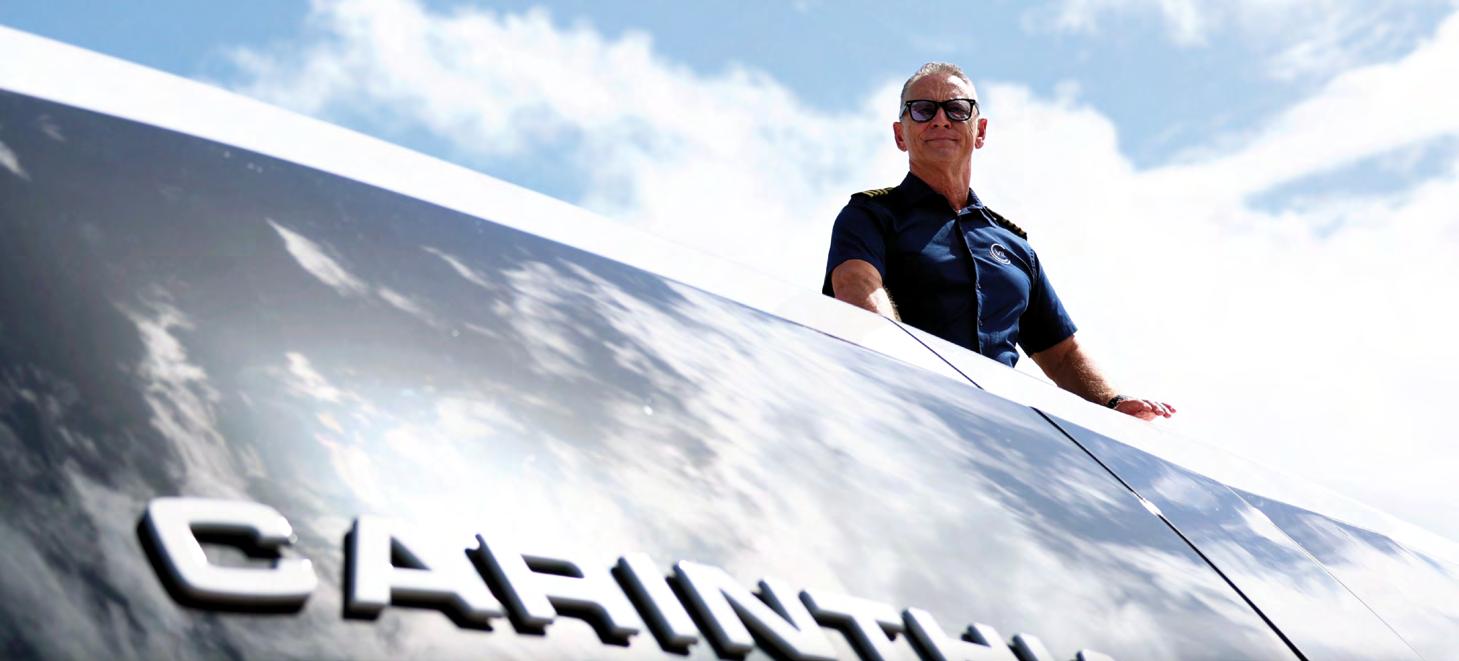
affrontarli con il buon senso, non importa quale training tu abbia fatto, alla fine è l’esperienza a ispirare le tue decisioni ed azioni. s i parla spesso di mental health a bordo, io dico all’equipaggio che la mia porta è sempre aperta e sono sempre disponibile ad ascoltare e, nel limite delle mie conoscenze e capacità, consigliare tutti, ma devono essere argomenti seri e importanti, non lamentele sul gusto degli yogurt o l’assortimento dei cereali a bordo “.
Siete quindi anche un po’ psicologi.
“Certamente, fa parte del ruolo del comandante essere anche psicologo e capire quando l’equipaggio è troppo stressato, quando allentare la pressione o quando concedere qualcosa per gestire lo salute mentale dell’equipaggio”. Gli armatori sono aperti a comprendere eventuali situazioni di stanchezza?
“Non tutti, qualcuno a volte capisce e nel corso di lunghi periodi di permanenza a bordo si riesce, a rotazione, a portare a terra l’equipaggio. ma non è comune, ci sono armatori che non comprendono certe dinamiche, ed è quindi dovere del comandante a volte schierarsi dalla parte dell’equipaggio e difenderne i diritti, con saggezza e imparzialità, e valutare quali sono le reali condizioni di lavoro. Il management dovrebbe essere il supporto con cui fare team per portare questi argomenti all’armatore, ma spesso il suo tempo libero è più importante di tutto; quindi, bisogna scendere a compromessi e organizzare tutte le attività in modo da non far soffrire né penalizzare troppo qualcuno, gestendo bene inoltre la normativa sulle ‘hours of rest’ che spettano all’equipaggio”.
A proposito, come funziona il meccanismo del giorno di riposo?
“I nostri contratti prevedono 7 giorni lavorativi su 7 per 365 giorni all’anno, con ovviamente un periodo o più di ferie. s pesso le nuove leve non capiscono che il giorno di risposo non è un diritto ma una gentile concessione del comandante, dell’armatore o del management. s e in estate non si riesce ad averlo, nella stagione invernale o durante i periodi di manutenzione, quando è più semplice, si cerca di compensare, e si recupera il lavoro extra. s u yacht delle dimensioni di Carinthia VII capita di rimanere all’ancora per mesi di fila, un grande disagio per l’equipaggio, che a volte ha bisogno di staccare, sia fisicamente che, soprattutto, mentalmente. per questo dico che è importante essere vigile e non arrivare mai al punto di rottura. Come già detto, Carinthia VII è una ‘dry ship’, cioè l’equipaggio non può bere alcolici a bordo, ma in determinate e limitate occasioni, come un compleanno o certe festività e comunque sempre senza ospiti a bordo, possono esserci delle eccezioni, sempre nei limiti e rispettando ogni canone di sicurezza. Nei periodi di ‘stanca’, inoltre, vengono organizzate varie attività per l’equipaggio, a bordo o fuori bordo, come cene, paintball, escursioni, go kart, eventi sportivi, o semplicemente serate cinema o giochi di società, che sono utili a rinsaldare il team”.
Cosa consiglia al riguardo?
“Durante la selezione dei membri dell’equipaggio e nei colloqui bisogna sempre dire la verità ed essere onesti, specificare cosa possono aspettarsi e cosa no, come la possibile mancanza di giorni di riposo per la maggior parte dell’estate, turni di lavoro faticosi e lunghi periodi trascorsi all’àncora e non sulla terraferma. L’equipaggio deve essere informato e sapere a cosa va incontro, nel bene e nel
It doesn’t matter what training you’ve done — in the end, it’s experience that guides your decisions and actions. People often talk about mental health on board, and I always tell the crew that my door is open, that I’m always available to listen and, within the limits of my knowledge and abilities, offer advice. But the issues brought up need to be serious and meaningful — not complaints about the flavor of the yogurt or the variety of cereals on board”.
So, in a way, you also act as psychologists.
“Absolutely. It’s part of the captain’s role to also be a psychologist — to recognize when the crew is under too much stress, when to ease the pressure, or when to grant something in order to manage the crew’s mental health”.
Are owners open to understanding situations of fatigue?
“Not all of them. Some do understand, and during long stays on board, we’re sometimes able to rotate the crew ashore. But it’s not common. There are owners who don’t grasp these dynamics, and so it becomes the captain’s duty to sometimes stand by the crew and defend their rights — with wisdom and impartiality — and assess the real working conditions. The management should be the support system that helps bring these issues to the owner, forming a team to address them. But often, their own free time takes priority over everything else. So compromises must be made, and all activities must be organized in a way that avoids causing undue suffering or penalizing anyone too much, while also properly managing the ‘hours of rest’ regulations that the crew is entitled to”.
In this regard, how does the
day-off system work?
“Our contracts state that we work seven days a week, 365 days a year, with of course one or more vacation periods. Often, newcomers don’t understand that a day off is not a right but a courtesy granted by the captain, the owner, or the management. If it’s not possible to take days off during the summer, we try to compensate in the winter season or during maintenance periods, when things are more relaxed, and make up for the extra work. On yachts the size of Carinthia VII, it’s not uncommon to remain at anchor for months on end — a big challenge for the crew, who sometimes need a break, both physically and, above all, mentally. That’s why I say it’s important to stay alert and never let things reach a breaking point. As I’ve already mentioned, Carinthia VII is a ‘dry ship,’ meaning the crew isn’t allowed to consume alcohol on board. However, on specific and limited occasions — like a birthday or certain holidays, and only when there are no guests on board — exceptions can be made, always within strict limits and in full compliance with safety protocols. During quieter periods, we organize various activities for the crew, both on and off the yacht, such as dinners, paintball, excursions, go-karting, sports events, or simply movie nights and board games, which help strengthen the team”. What advice would you give on this topic?
“During the recruitment process and interviews, you must always tell the truth and be honest — explain clearly what they can expect and what they can’t. Things like the potential lack of days off during most of the summer, exhausting work shifts, and long periods spent at anchor instead of on land. The crew needs to be
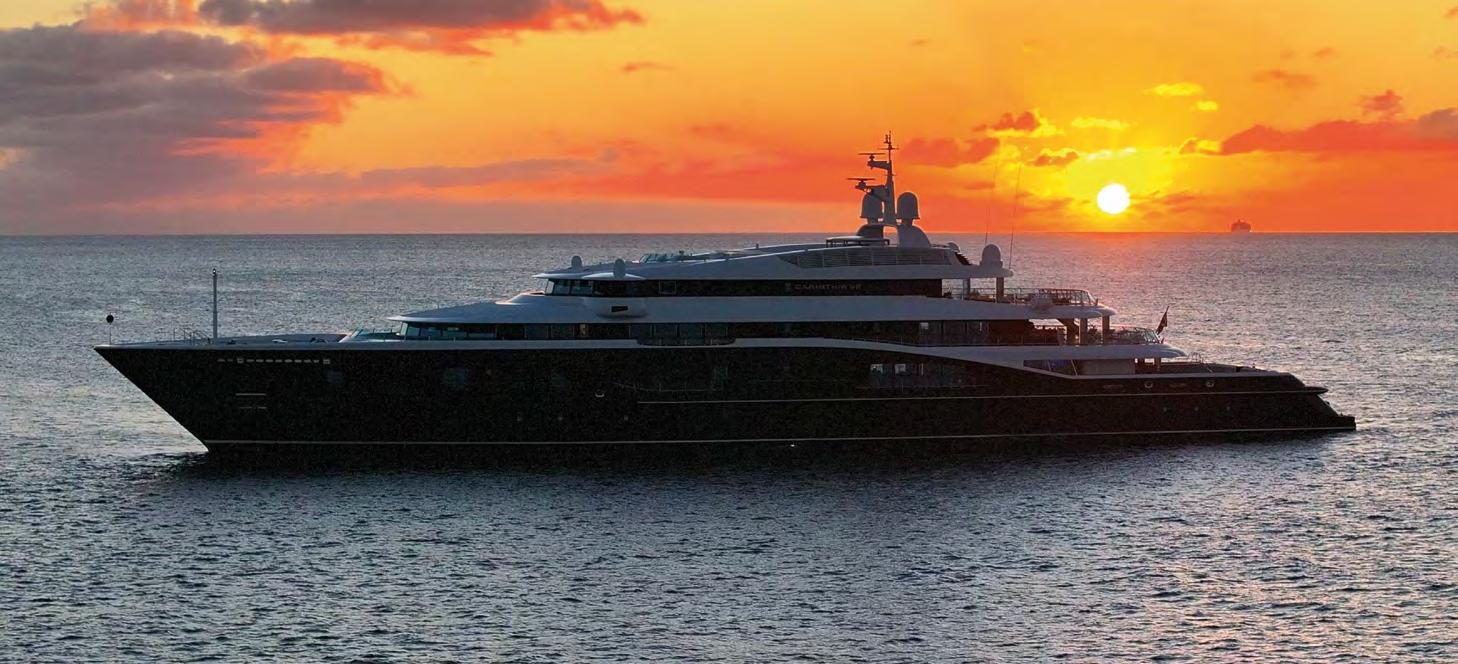
male, non si può mentire”.
Quello del comandante è un ruolo solitario?
“a ssolutamente sì, secondo la mia esperienza il comandante nasce, vive e muore solo. Non può mischiarsi troppo, e non è solo una questione di autorevolezza, ego o riverenza. Io non esco quasi mai con il mio equipaggio, la mia presenza sarebbe ingombrante e impedirebbe, a mio avviso, di essere spontanei e rilassati. Bisogna abituarsi a stare soli, relazionarsi con i propri affetti e con gli amici a casa, anche se poi a bordo c’è sempre qualcuno con cui leghi di più per fare due passi o scambiare qualche parola”.
A Genova si è accennato anche al recente suicidio di un collega. Cosa ne pensa?
“ p rima di arrivare a quel punto bisogna avere la forza di parlare con qualcuno, e soprattutto chi ti è intorno dovrebbe realizzare che sei in pericolo ed hai bisogno di aiuto. s ono casi complicati e che secondo me non vengono solo da un carico di lavoro eccessivo, ma anche da agenti esterni. u n’azione del genere può nascere in qualsiasi ambiente, e quindi anche a bordo, ma concordo sul fatto che non è facile essere parte di un equipaggio”.
Quali sono le maggiori sfide in tal senso?
“Oggi si parla tanto, forse troppo, di mental health, ma la realtà è che questa non è una professione per tutti; non possiamo costruire il mondo perfetto e il training si ferma a un certo punto. È come in tutte le aziende, quando hai 10, 15, 30 o 40 membri d’equipaggio gestisci un’azienda con tutte le varie problematiche umane che comportano: problemi legati alla salute mentale, molestie sessuali, bullismo esistono ovunque, non solo nello yachting, ma vengono amplificati
da format come Below Deck e in generale dai social media che disegnano un mondo perfetto e di esagerazioni”.
Per le nuove generazioni è quindi un problema?
“ s ì, perché mediamente è una generazione che non legge, non si informa e basa tutta la sua conoscenza sui social, i maggiori responsabili del problema delle false aspettative e dei relativi danni allo yachting, e non solo. Ognuno si sente libero di scrivere quello che vuole, chiunque in via anonima può infamarti, magari per ignoranza, ma comunque mettere a rischio la tua carriera. a llo stesso tempo non bisogna generalizzare, ci sono anche giovani seri e determinati, magari fanno degli errori ma riesci a correggerli e a spiegare come invece devono funzionare le cose. ed è su questi elementi che bisogna investire, cercando di farli crescere trasferendo a loro le nostre esperienze e conoscenze”. Ha vissuto situazioni del genere a rischio?
“ u n anno e mezzo dopo essere sbarcato da uno yacht, durante un charter è accaduto un episodio di molestie sessuali da parte di un ospite nei confronti di un membro dell’equipaggio, e i membri di un gruppo Facebook hanno iniziato a scrivere che il comandante non aveva preso tutti i provvedimenti necessari, a chiedere chi fosse il comandante, a ipotizzare che fosse un italiano ed alla fine è stato associato il mio nome. Ho dovuto pubblicamente ribadire che io non ero più il comandante di quello yacht da un anno e mezzo, e che quindi non c’entravo nulla con quella faccenda. ma nel frattempo qualcuno avrà pensato male di me o dei comandanti italiani. pazienza, ci siamo abituati. a lla fine, l’importante è avere la coscienza a posto ed essere in pace con sé stessi”.
informed and know exactly what they’re getting into — for better or for worse. you can’t lie”. Is the role of captain a lonely one?
“Absolutely, in my experience, a captain is born, lives, and dies alone. you can’t get too involved — and it’s not just a matter of authority, ego, or reverence. I almost never go out with my crew; I feel my presence would be intrusive and would prevent them from being spontaneous and relaxed. you have to get used to being alone, to keeping in touch with loved ones and friends back home. That said, there’s always someone on board you connect with more, someone to take a walk with or have a chat”.
In Genoa, there was also mention of a recent suicide by a fellow captain. What are your thoughts?
“Before reaching that point, one must find the strength to speak to someone — and, more importantly, those around you need to realize that you’re in danger and need help. These are complex cases, and in my opinion, they don’t come solely from excessive workloads, but also from external factors. Such an act can happen in any environment — and therefore also on board — but I agree: it’s not easy being part of a crew”.
What are the biggest challenges in this regard?
“Today, there’s a lot of talk — maybe too much — about mental health, but the truth is that this profession is not for everyone. We can’t build a perfect world, and training only goes so far.
l ike in any company, when you’re managing a crew of 10, 15, 30, or 40 people, you’re managing a business with all the human issues that come with it: mental health problems, sexual harassment, bullying — these exist everywhere, not just in
yachting. But they’re amplified by formats like Below Deck and by social media in general, which portray an exaggerated and idealized world”.
So, is it a problem for the younger generations?
“ yes, because on average, it’s a generation that doesn’t read, doesn’t seek out information, and bases all of its knowledge on social media — which are the main culprits behind false expectations and the damage they cause, not just in yachting. Everyone feels free to write whatever they want, and anyone — even anonymously — can tarnish your reputation, perhaps out of ignorance, but still putting your career at risk. At the same time, we shouldn’t generalize. There are also serious and determined young people — they may make mistakes, but you can correct them and explain how things really work. These are the individuals we should invest in, helping them grow by passing on our experience and knowledge”. Have you ever experienced similar situations?
“A year and a half after leaving a yacht, there was a case during a charter where a guest sexually harassed a crew member. People in a Facebook group started writing that the captain hadn’t taken the necessary actions, asking who the captain was, speculating that he was Italian — and eventually, my name was associated with the incident. I had to publicly clarify that I had not been the captain of that yacht for a year and a half, and that I had nothing to do with the matter. But in the meantime, some people might have thought poorly of me, or of Italian captains in general. Oh well, we’re used to it. In the end, what matters is having a clear conscience and being at peace with yourself”.
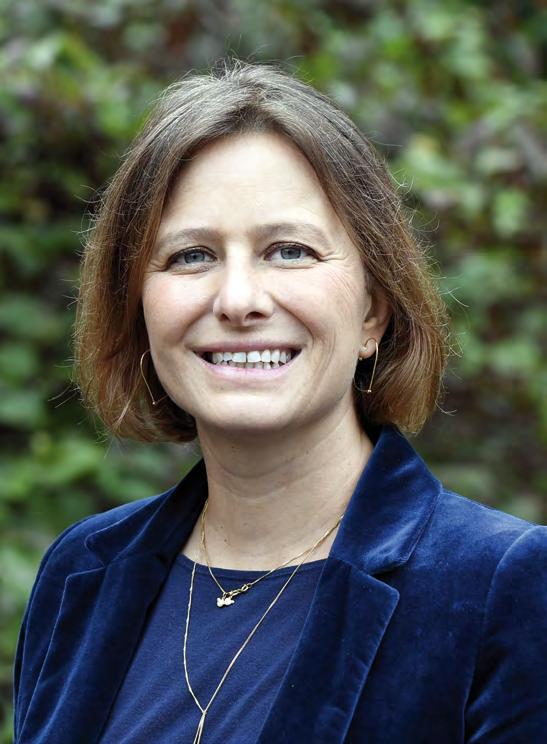
Diventata famosa in tutto il mondo per i prodotti dedicati all’edilizia, la multinazionale italiana mapei ha oltre 20 linee di prodotto con una presenza nell’industria navale, dai traghetti alle navi da trasporto fino a quelle da crociera e al mondo superyacht. Dopo l’esperienza del Class40, mapei ha deciso di continuare a supportare il navigatore ambrogio Beccaria come main sponsor del nuovo progetto allagrande mapei racing che ha come obiettivo il Vendée Globe 2028, il giro del mondo in solitario e senza scalo. simona Giorgetta, membro del consiglio d’amministrazione di mapei, ha raccontato a super YaCHt 24 che “avevamo già lavorato insieme ad ambrogio con tante soddisfazioni, sia per i risultati sportivi sia per l’esperienza umana e anche rispetto alle nostre consociate in giro per il mondo (sono 96 distribuite in 57 paesi, n.d.r.). mapei entra nel vivo dei progetti, non si limita a dare supporto economico sarà quindi l’occasione per organizzare una serie di eventi nei paesi toccati dalle regate a cui parteciperà ambrogio e dove siamo presenti”.
Dal Class40 all’Imoca60 è un grande salto a livello di budget. “È un salto importante che abbiamo accettato con entusiasmo e che avrà lo stesso forte coinvolgimento delle nostre consociate durante le regate. siamo orgogliosi di portare il marchio mapei in giro per gli oceani, anche perché abbiamo investito ambrogio del ruolo di sustainability ambassador. mapei da sempre lavora sui temi dell’attenzione all’ambiente: non solo sosterremo i suoi progetti, ma sarà
“ strenGtheninG our teaM and Products. a new line For YachtinG to
dai PaviMEnti in rEsina allE suPErFici PEr i Ponti
ElicottEri, l’aziEnda aMPlia il PortFolio dEdicato allo yacHtinG con soluzioni innovativE E sviluPPi attEsi al ProssiMo salonE FrancEsE
FroM resin FloorinG to helicoPter deck surFaces, the coMPanY is exPandinG its YachtinG P ortFolio with innoVatiVe solutions and de VeloPMents set to Be unVeiled at the next French Boat show
un’opportunità per parlare anche del nostro modo di fare impresa rispetto a questo tema. Investiamo una parte importante del nostro fatturato in ricerca e sviluppo e avere un atleta con una barca da regata competitiva e disponibile a collaborare sulla sperimentazione è un vantaggio”.
La sponsorizzazione faciliterà lo sviluppo di nuovi prodotti per lo yachting o di un’apposita business unit?
“Non mi sento di escluderlo a priori, anche se faremo le cose passo dopo passo. sicuramente potremo avere un feedback diretto sia del cantiere, che è parte del team, sia dalla navigazione e questa triangolazione è un banco di sperimentazione potente, anche perché viene fatto durante competizioni oceaniche dove tutto è spinto al limite. Inoltre stiamo collaborando con il cantiere Zar Formenti per lo sviluppo di un protettivo e lucidante per i tubolari e al prossimo Cannes Yachting Festival presenteremo una nuova linea di prodotti dedicati alla nautica”. Parliamo dei prodotti dedicati alla nautica.
“Qui serve un breve premessa: mapei s.p.a. sviluppa e produce materiali chimici per l’edilizia, tra le varie linee ne esiste una dedicata alla nautica. mapei marine srl è invece la società del gruppo guidata da andrea Gerardini e dedicata a offrire un servizio che comprende l’assistenza e l’applicazione del prodotto ed è pensato per la grande cantieristica commerciale”.
Esistono punti di contatto tra vela oceanica e mondo superyacht?
“sì, sul Class40 abbiamo usato sigil-
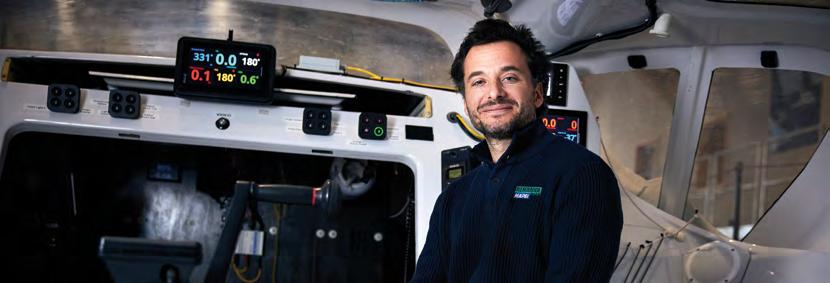
Famous worldwide for its construction products, the Italian multinational Mapei offers over 20 product lines and has an established presence in the maritime industry - from ferries and cargo ships to cruise liners and superyachts. Following its involvement in the Class40 project, Mapei has decided to continue supporting sailor Ambrogio Beccaria as the main sponsor of the new Allagrande Mapei Racing venture, aimed at the 2028 Vendée Globe: the solo, nonstop round-the-world race. Simona Giorgetta, a member of Mapei’s board of directors, told SuPER yACHT 24: “We had already worked with Ambrogio with great satisfaction, not only for the sporting results but also for the human experience and the involvement of our subsidiaries around the world (we have 96 across 57 countries, editor’s note). Mapei gets fully involved in its projects - we don’t just provide financial support. This will also be an opportunity to organize a series of events in the countries visited by the regattas Ambrogio will be competing in, where we also have a presence”.
From the Class40 to the Imoca60 is a major leap in terms of budget.
“It’s a significant step, which we’ve embraced with enthusiasm, and it will involve the same strong engagement from our subsidiaries during the regattas. We’re proud to carry the Mapei brand across the oceans - especially since we’ve appointed Ambrogio as our Sustainability Ambassador. Mapei has always focused on environmental responsibility: we won’t just be supporting his projects, but we’ll also use this opportunity to highlight our own sustainable business practices. We invest a substantial portion of our revenue in research and development, and having an athlete with a competitive racing yacht who’s open to collaboration on experimentation is a real asset.”
Will the sponsorship lead to the development of new products for the yachting sector or even a dedicated business unit?
“I wouldn’t rule it out, although we’ll take things step by step. What’s certain is that we’ll receive direct feedback from the shipyard, which is part of the team, as well as from the sailing experience itself. That triangulation is a powerful testing ground, especially since it all happens in the context of offshore racing, where everything is

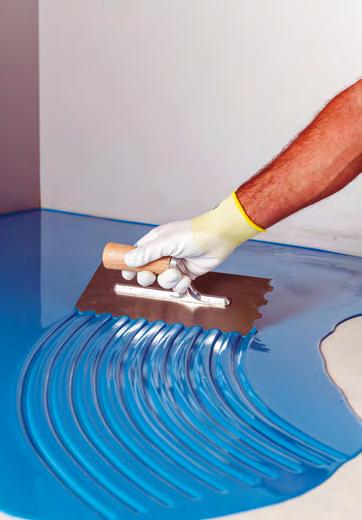
lanti che vengono applicati anche su yacht e navi. altri prodotti sono invece specifici soprattutto per lo yachting e non hanno un utilizzo su una barca da regata. Da un punto di vista tecnico la possibilità di testare alcuni prodotti su un mezzo di quel tipo, con sollecitazioni e sforzi importanti, e vedere che funzionano bene è un riscontro importante”.
Come sono divisi i prodotti dedicati allo yachting?
“abbiamo prodotti per traghetti e navi commerciali da trasporto, navi commerciali da crociera, mezzi militari e superyacht. La gamma è divisa in prodotti per interni ed esterni. per gli interni ci sono i prodotti destinati alle zone per gli equipaggi e alle aree tecniche e quelli per le aree aperte al pubblico, come pavimenti in resina o effetto terrazzo. per gli esterni esistono applicativi per tutte le zone ponte e le aree pubbliche, le aree destinate allo sport come le piste da corsa sulle navi da crociera, le aree gioco dei bambini, le pavimentazioni per water park e piscine e prodotti più specifici per l’atterraggio degli elicotteri, usati spesso anche nei superyacht”. Come funziona il rapporto con i cantieri?
“a seconda del tipo di prodotto, il rapporto può essere gestito da mapei o da mapei marine. Nelle pavimentazioni, ad esempio, quando lavoriamo con cantieri come sanlorenzo, Benetti o Italian sea Group la fornitura viene fatta da mapei marine, quindi applichiamo anche il prodotto. altre richieste vengono invece fatte a mapei s.p.a. che fornisce solo i prodotti, tipicamente quelli per incollaggio e calafataggio del teak, l’impermeabilizzazione di tutte le aree umide, adesivi di vario genere. alcuni cantieri fanno accordi con noi per vedere assicurato da parte dei loro terzisti l’utilizzo dei nostri materiali. Così facendo sono certi della qualità del prodotto e hanno la garanzia di un’azienda come mapei”.
Avete altre collaborazioni?
“Nel mondo superyacht lavoriamo con Lürssen Yachts per i ponti elicottero, passeggiate, aree tecniche e tender garage. Di recente abbiamo aggiunto una persona nel team di mapei marine srl che si occuperà del mondo su-

peryacht per i cantieri del Nord europa. stiamo rafforzando sia la squadra sia i prodotti”.
Quali sono i punti di forza dei vostri prodotti?
“aver creato la divisione mapei marine che grazie ai suoi tecnici arriva al cuore del cantiere, ne raccoglie i feedback e ascolta le esigenze del cliente per migliorare il prodotto. Inoltre abbiamo un’esperienza di quasi 90 anni nello sviluppo di prodotti che contengono meno sostanze volatili possibile, in favore sia degli applicatori sia di chi vivrà in quegli ambienti. Questa attenzione è parte della storia e del nostro modo di lavorare. Il reparto sostenibilità in mapei non afferisce al marketing, ma dipende dal dipartimento ricerca e sviluppo (con 36 laboratori nel mondo, n.d.r.), e questo la dice lunga sul nostro approccio: non si tratta solo di comunicare, un modo di lavorare”.
Come giudica il momento dell’industria italiana?
“sicuramente si legge fermento, anche grazie all’ingegno italiano e al fatto di essere leader riconosciuti nel design, nella capacità di progettare e inventare e questo ha avuto un riflesso anche sulla nautica. L’Italia è un paese che ha più costa che terra, i numeri sono interessanti e promettenti”.
Quali sono invece gli aspetti da migliorare?
“Faccio un discorso più generale ma che forse può essere declinato anche alla nautica: la burocrazia non aiuta il settore industriale, si potrebbe fare molto di più. Il discorso vale anche per la formazione, l’Italia è un paese che, purtroppo, investe sempre di meno in istruzione e dunque nel suo stesso futuro”.
Qual è il valore aggiunto di essere parte dell’associazione Together We Boat con Mapei Marine?
“Lavoriamo in sinergia in una squadra di cui fanno parte aziende come Besenzoni, Feit e Hp Watermakers condividendo contatti e informazioni. La forza è avere una visibilità comune e presentarsi ai cantieri come gruppo, benché ognuno con le proprie specificità, aiuta il business visto che sono tanti e diversi gli elementi da mettere insieme per costruire uno yacht”.
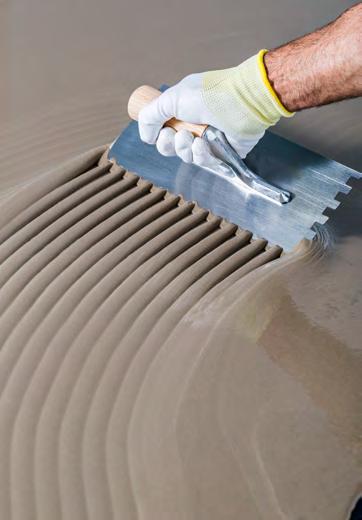
pushed to the limit. We’re also working with the shipyard Zar Formenti on the development of a protective and polishing product for inflatable tubes, and at the upcoming Cannes yachting Festival we’ll be unveiling a new line of products specifically for the boating industry”.
Let’s talk about the products designed for the yachting sector.
“Here’s a quick introduction: Mapei S.p.A. develops and produces chemical products for the construction industry, and among its various lines, there’s one dedicated to the nautical sector. Mapei Marine srl, on the other hand, is the group company led by Andrea Gerardini, focused on providing services that include product assistance and application, specifically designed for large-scale commercial shipbuilding”. Are there any connections between ocean sailing and the superyacht world?
“yes, on the Class40 we used sealants that are also applied on yachts and ships. Other products, however, are mainly specific to yachting and wouldn’t be used on a racing boat. From a technical standpoint, the ability to test certain products on a vessel like that - subject to intense stress and strain - and see that they perform well is very valuable feedback”.
How are the products dedicated to yachting divided?
“We have products for ferries and commercial transport ships, commercial cruise ships, military vessels, and superyachts. The range is divided into interior and exterior products. For interiors, we offer products intended for crew areas and technical zones, as well as those for public areas, such as resin or terrazzo-effect flooring. For exteriors, there are solutions for all deck zones and public spaces, including sports areas like running tracks on cruise ships, children’s play areas, flooring for water parks and pools, and more specific products for helicopter landing pads, which are also commonly used on superyachts”.
How does the relationship with shipyards work?
“Depending on the type of product, the relationship may be handled by Mapei or Mapei Marine. For flooring, for example, when we work with shipyards like Sanlorenzo, Benetti,
or Italian Sea Group, the supply is managed by Mapei Marine, which also applies the product. Other requests are handled by Mapei S.p.A., which only supplies the products - typically those for bonding and caulking teak, waterproofing all wet areas, and various types of adhesives. Some shipyards make agreements with us to ensure that their subcontractors use our materials. This way, they are guaranteed the quality of the product and the reliability of a company like Mapei”. Do you have any other partnerships?
“In the superyacht sector, we work with lürssen yachts on helicopter decks, walkways, technical areas, and tender garages. Recently, we added a new team member at Mapei Marine Srl who will be dedicated to the superyacht segment for Northern European shipyards. We are strengthening both the team and the product line”. What are the main strengths of your products?
“Creating the Mapei Marine division has been a key factor. Thanks to its technicians, it gets to the heart of the shipyard, gathers feedback, and listens to customer needs to improve the product. In addition, we have nearly 90 years of experience developing products with the lowest possible volatile content, benefiting both the applicators and the people who will live in those environments. This attention to health and safety is part of our history and work ethic. At Mapei, the sustainability department doesn’t report to marketing but to the Research and Development department (which includes 36 laboratories worldwide), and that says a lot about our approach - it’s not just about communication, it’s a way of working”.
How would you assess the current state of Italian industry?
“There’s definitely a sense of dynamism, driven by Italian ingenuity and our recognized leadership in design, planning, and innovation - and this has extended into the nautical sector. Italy is a country with more coastline than land, and the figures are both interesting and promising”.
What are the areas that need improvement?
“I’m speaking more generally, though it could also apply to the nautical sector: bureaucracy does not support the industrial sector - it’s an area where much more could be done. The same goes for education; unfortunately, Italy is a country that’s investing less and less in education, and therefore in its own future”.
What is the added value of being part of the Together We Boat association with Mapei Marine?
“We work in synergy as a team that includes companies like Besenzoni, Feit, and HP Watermakers, sharing contacts and information. The strength lies in having shared visibility and presenting ourselves to shipyards as a group. Even though each company has its own expertise, it helps the business - there are many different elements that need to come together to build a yacht”.
intErvista ad alEssandro rossi, cHiEF Product oFFicEr aziMut|BEnEtti GrouP, cHE PrEsEnta il lavoro di ricErca a Bordo di aziMut sEadEck 7, ProGEtto Pilota cHE tEstiMonia l’EccEllEnza dEl GruPPo nEll’innovazionE E nEll’r&d
interView with alessandro rossi, chieF Product oFFicer oF the a ziMut|Benetti GrouP, who Presents the research work carried out on Board the a ziMut seadeck 7 - a Pilot Project that showcases the GrouP’s excellence in innoVation and r&d
“Ecco
“here is the a ziMut hYBrid in Four Versions”
seadeck 7 è la prima unità full hybrid di a zimut a montare la nuova propulsione Volvo penta in grado di esprimere quattro diverse modalità di funzionamento e offrire una riduzione dei consumi e delle emissioni fino al 40% in uno anno di uso medio. per alessandro rossi, responsabile sviluppo prodotto del Gruppo azimut|Benetti “Questo motore è nato principalmente grazie alla lunga collaborazione che abbiamo da oltre quindici anni con Volvo penta per lo sviluppo di sistemi propulsivi e di gestione innovativi. abbiamo entrambi una visione allineata su prodotto e sostenibilità, da ricercarsi con azioni concrete, con tecnologie che non guardano solo a cosa accadrà nei prossimi 30 anni ma a cosa deve succedere entro i prossimi cinque e con obiettivi raggiungibili soprattutto attraverso l’efficienza, che è correlata alla sostenibilità e a cui bisogna arrivare attraverso la tecnologia, ma anche con un’esperienza di utilizzo migliore. Oltre dieci anni fa, a zimut ha introdotto il primo ibrido, mentre Volvo penta stava sviluppando soluzioni ibride per la navigazione commerciale. Così abbiamo condiviso le esperienze, noi sul ramo yachting e loro sulle propulsioni integrate. Da qui è partito un tavolo di lavoro, quasi due anni fa, e si è creata un’organizzazione ad hoc nelle nostre due aziende per sviluppare questo progetto, ‘project Hybrid’. Volvo penta è sempre stata abituata ad essere un fornitore di soluzioni, quindi sviluppa una soluzione in house, la testa e poi la vende. Noi siamo da sempre sia degli sviluppatori sia degli integratori di sistemi, quindi sviluppiamo una carena e poi selezioniamo un fornitore per la propulsione. Il sistema per seadeck 7 è stato definito e progettato assieme; abbiamo organizzato 100-150 meeting bisettimanali sul
3D virtuale e poi a bordo per arrivare alla soluzione finale. Il sistema è stato disegnato sulle esigenze dello yachting, non è un adattamento di qualcos’altro”.
Quali sono state le sfide progettuali in termini di spazi e pesi?
“È stato un grande sforzo di design e integrazione. In questa partnership abbiamo avuto un altro grande aiuto, il rina, per tutta la parte di risk assesment, perché vogliamo un sistema facile da usare ma anche sicuro. Nell’ottica del packaging c’è stato un grande lavoro di studio, ricerca di componenti, di posizionamento in termini di peso, di installazione e manutenzione. stiamo ancora lavorando con Volvo penta, questa barca è in fase di test e c’è una gemella in svezia che Volvo penta sta facendo operare a ciclo continuo per la durabilità del sistema. Insieme vogliamo lanciare sul mercato nel 2026 un sistema che sia completamente testato”. Manca ancora la quarta modalità. In cosa consiste?
“È la modalità crossover, richiesta che arriva dai ritorni del mercato sulle nostre precedenti applicazioni. abbiamo introdotto questa modalità due anni fa sugli ibridi di Benetti, con la possibilità di navigare in ‘alternata motori’, quindi un motore principale spento e l’altro che fa da propulsione per il suo asse, con il suo motore elettrico che genera energia per far funzionare l’altro motore elettrico. sarà un solo motore diesel che sopporta tutti i carichi, sia propulsivi che di hotel, coadiuvato dalle batterie, e che lavorando a un carico ottimizzato, risulta anche più efficiente di tre motori endotermici che lavorano a carichi più bassi riducendo anche le ore totali di funzionamento e allungando gli interventi dei service”. In futuro la propulsione offrirà così tanta scelta oppure si andrà verso l’individuazione della
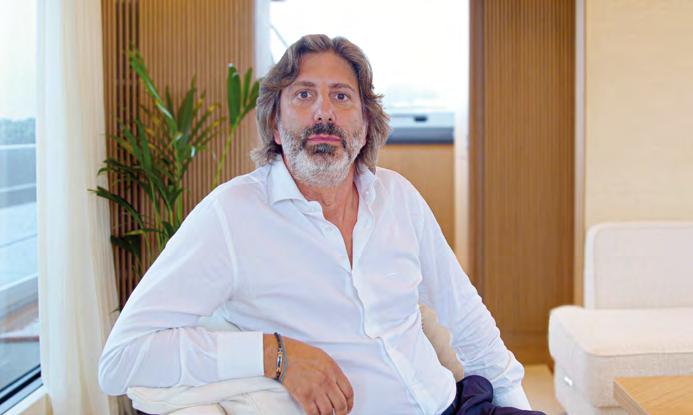
The Seadeck 7 is Azimut’s first fully hybrid unit to be equipped with the new Volvo Penta propulsion system, capable of operating in four different modes and reducing fuel consumption and emissions by up to 40% over a year of average use. According to Alessandro Rossi, Head of Product Development at the Azimut|Benetti Group, “This engine was developed primarily thanks to the long-standing collaboration we’ve had with Volvo Penta for over fifteen years, working together on innovative propulsion and management systems. We share a common vision when it comes to product and sustainability - one that’s pursued through concrete actions and technologies that don’t just look 30 years ahead, but also focus on what needs to happen in the next five. Achieving this means setting realistic goals, especially through efficiency, which is closely linked to sustainability and must be pursued not only through technology but also by offering a better user experience. Over ten years ago, Azimut introduced its first hybrid model, while Volvo Penta was developing hybrid solutions for commercial navigation. That’s when we began sharing our experiences - ours in the yachting sector, theirs in integrated propulsion systems. This led to the launch of a joint working group nearly two years ago, and both companies created dedicated teams to develop what became known as ‘Project Hybrid’. Volvo Penta has always operated as a solutions provider, developing systems in-house - from concept to final product - and then selling them. In contrast, we’ve always been both developers and system integrators: we design a hull and then select a propulsion partner. For the Seadeck 7, the system was defined and designed together. We held between 100 and 150 bi-weekly meetings, first in a virtual 3D environment and then on board, to reach the final solution. This system was designed specifically for yachting needs - it’s not an adaptation of something else”. What were the design challenges in
terms of space and weight?
“It was a major effort in both design and integration. In this partnership, we also had valuable support from RINA, especially for the entire risk assessment process, because we want a system that’s not only easy to use but also safe. From a packaging perspective, there was extensive work involving component selection, weight distribution, installation, and maintenance. We’re still working closely with Volvo Penta - this yacht is currently in the testing phase, and there’s a twin unit in Sweden that Volvo Penta is running continuously to test the system’s durability. Together, we aim to launch a fully tested system on the market by 2026”.
The fourth mode is still missing. What does it involve?
“It’s the crossover mode, which was developed in response to market feedback from our previous hybrid applications. We first introduced this mode two years ago on Benetti hybrids, allowing for what we call ‘alternating engine’ operationessentially, one main engine is turned off, while the other powers its own shaft and simultaneously uses its electric motor to generate energy for the other electric motor. In this setup, only one diesel engine handles all loads - both propulsion and hotel services - supported by the batteries. By operating at an optimized load, it’s actually more efficient than running three combustion engines at low loads. It also reduces total operating hours and extends the intervals between service interventions”. In the future, will propulsion offer this much choice, or will the focus shift to identifying the single best mode?
We have a program based on four levels of electrification. The first, Zero Emission Hotel Mode, is already available on some models in the Magellano and Grande collections. The second level, Mild Hybrid, is in operation on the Seadeck 6, while Mild Hybrid Plus will be launched alongside Azimut’s new flagship, the Grande 44M. In the Full Hybrid version, all operating modes will
modalità migliore?
“Noi abbiamo un programma basato su quattro livelli di elettrificazione. Il primo, lo Zero emission hotel mode, è già disponibile su alcuni modelli delle collezioni magellano e Grande. Il secondo, mild hybrid, è operativo sul seadeck 6, mentre il mild hybrid plus sarà lanciato insieme alla nuova ammiraglia di a zimut, Grande 44m. Nella versione full hybrid tutte le modalità saranno rese disponibili perché ognuna delle funzioni ha una ragione di essere e dà un beneficio. Vogliamo un sistema facile, dove l’intelligenza del sistema decida e supporti l’armatore o l’equipaggio nel passaggio da una modalità all’altra. se parliamo di uno yacht Benetti, normalmente c’è un comandante, un chief engineer, preparati per gestire la complessità del sistema. In uno yacht sotto ai 24 metri non si può pensare che questa architettura venga gestita da un armatore. Il sistema sceglierà la modalità migliore con l’opportunità di forzare una modalità, ad esempio andare in full electric perché sono in una zona protetta. scendendo di dimensioni esistono soluzioni ibride o di elettrificazione che riguardano solo alcune funzioni della barca. La prima funzione che pensiamo di sostituire è quella del generatore, recuperando energia dai motori propulsivi e immagazzinandola in batterie. ritengo che sia necessaria una scalatura, basata sulla complessità architetturale del sistema a seconda dell’imbarcazione, offrendo in funzione della taglia di imbarcazione livelli di elettrificazione crescenti”.
Qual è il suo giudizio sulle infrastrutture in Italia per la ricarica elettrica rapida?
“Credo che sia necessario un grande cambiamento generazionale, anche nelle marine, come sta succedendo nei centri città, dove oggi è preferenziale che le auto siano elettriche o ibride. anche i porti devono pensare a questo: quando
durante la stagione estiva centinaia di motori diesel si accendono in porto, non è sempre così piacevole, specialmente se i diesel sono di vecchia generazione. Io credo che il primo passaggio sia capire quando le marine inizieranno a interessarsi ad avere lo stazionamento e l’entrata e l’uscita dal porto ad emissioni ridotte; questo sarà il primo grande cambiamento. per raggiungerlo, dovranno fare la loro parte come infrastrutture”.
Qual è, secondo lei, la propulsione del futuro?
“Futuro è una parola molto generica nel senso che, se pensiamo ai prossimi dieci anni, credo che non ci sia alcuna possibilità di abbandonare l’endotermico. Dobbiamo essere onesti e dobbiamo essere dei tecnici che non raccontano fantascienza. Questo non vuol dire non fare niente oggi o domani, noi abbiamo fatto un grande lavoro con eni e con il rina per rendere tutte le nostre imbarcazioni compatibili Hvo e sappiamo che ci sono carburanti alternativi in arrivo. Non penso che a livello infrastrutturale riusciremo ad avere altri carburanti con disponibilità adeguata, ad eccezione dei bio-diesel di ultima generazione, prima del 2040. Vedo ancora un po’ più lontana la fuel cell. Non vedo come soluzione l’idrogeno per complessità, sicurezza a bordo e disponibilità. abbiamo un piano ben chiaro da qui al 2035, messo a terra con risultati tangibili. Non credo, però, che possiamo usare i nostri clienti come tester, ma vogliamo procedere come con il seadeck 7 ‘project Hybrid’, sviluppando insieme ai migliori partner soluzioni innovative da rendere poi disponibili sul mercato. Dobbiamo spingere tutto il sistema ad evolvere, però in modo cosciente. L’r&D guarda al 2050, lo sviluppo prodotto guarda al 2035, quindi sono due orizzonti temporali che, secondo me, le grosse aziende devono essere in grado di sincronizzare”


be available, because each one has a specific purpose and brings its own benefit. Our goal is to have a user-friendly system where the intelligence of the system itself determines and supports the owner or crew in transitioning from one mode to another. When we’re talking about a Benetti yacht, there’s usually a captain and a chief engineer on board, fully qualified to manage the complexity of such a system. On a yacht under 24 meters, you can’t expect the owner to handle that level of complexity. That’s why the system will automatically select the most appropriate mode, while still allowing the user to override it - for example, switching to full electric when navigating in a protected area. As yacht sizes decrease, there are hybrid or electrified solutions that cover only certain functions on board. The first function we aim to replace is the generator - by recovering energy from the propulsion engines and storing it in batteries. I believe we need a scalable approach, where the system architecture’s complexity matches the size of the vessel, offering increasing levels of electrification based on the boat’s dimensions
What’s your view on Italy’s infrastructure for fast electric charging?
“I believe a major generational shift is needed, even in marinas - just as we’ve seen in city centers, where electric or hybrid cars are now often preferred. Ports need to start thinking the same way. During the summer season, when hundreds of diesel engines start up in the marina, it’s not always pleasantespecially if they’re older engines. I think the first real step will be when marinas begin to take an interest in enabling low-
emission docking, arrivals, and departures. That will be the first major shift. To make it happen, they’ll need to play their part by investing in the necessary infrastructure”.
In your opinion, what is the propulsion system of the future?
“Future” is a very broad term - if we’re talking about the next ten years, I don’t believe there’s any realistic chance of abandoning internal combustion. We have to be honest, and we have to be technicians, not storytellers of science fiction. That doesn’t mean we should sit back and do nothing today or tomorrow. In fact, we’ve done significant work with Eni and RINA to make all our boats compatible with HVO, and we’re aware that alternative fuels are on the way. However, I don’t think we’ll see any other fuels available at scale - apart from next-generation bio-diesels - before 2040, from an infrastructure standpoint. I see fuel cells as still a bit further off. I don’t see hydrogen as a viable solution due to the complexity, onboard safety concerns, and limited availability. We have a clear roadmap to 2035, backed by tangible results. That said, I don’t believe we should use our customers as test subjects. Instead, we want to do what we did with the Seadeck 7 ‘Project Hybrid’: develop innovative solutions together with the best partners and then bring them to market. We need to push the entire system to evolve - but do so responsibly. R&D should look to 2050, while product development should focus on 2035. These are two different time horizons that, in my view, large companies must be capable of synchronizing”.
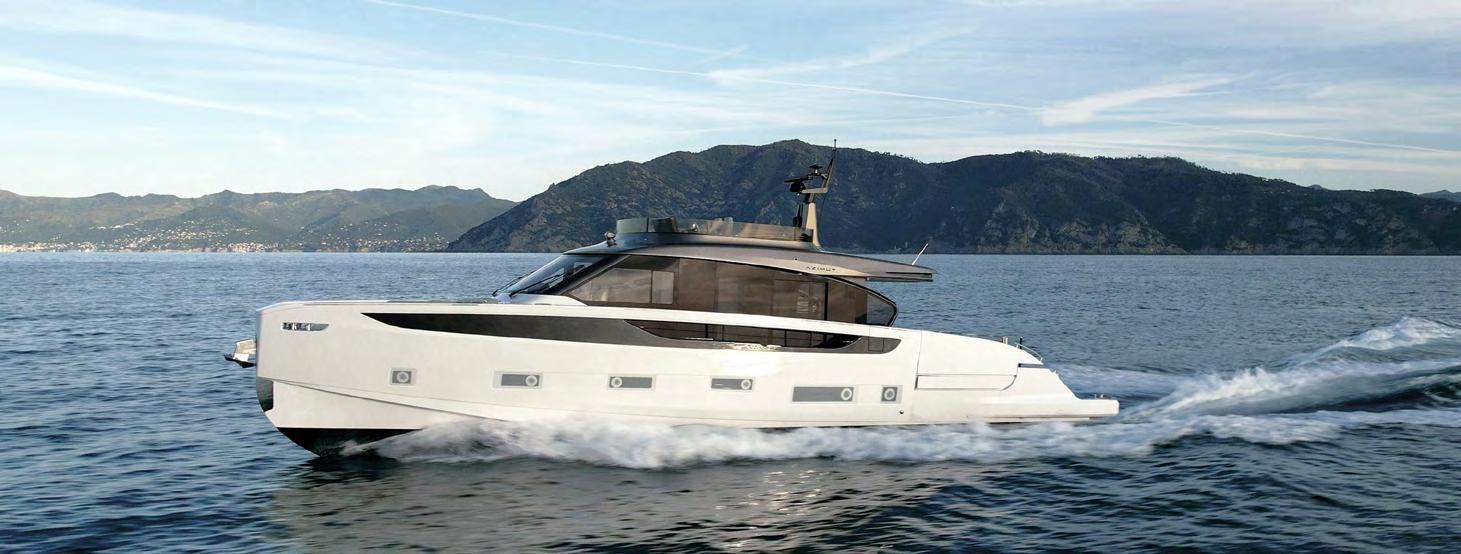
di
con duE unità ElEttricHE installatE tra i ProPulsori volvo PEnta E Gli iPs
suPer Yacht 24 tested the new Model FroM the seadeck ranGe, the shiPYard’s First equiPPed with a hYBrid sYsteM FeaturinG two electric units installed Between the VolVo Penta enGines and the iPs driVes
Barcellona (spagna) - azimut seadeck 7 è il primo yacht al mondo a combinare la propulsione Volvo penta Ips con un sistema ibrido diesel-elettrico. Frutto della collaborazione tra il cantiere piemontese e il costruttore svedese di motori, questo progetto segna un passo concreto nella transizione energetica per le imbarcazioni plananti sotto ai 24 metri.
Il seadeck 7 è lungo 21,88 metri, fa parte della nuova serie ibrida di azimut e sarà disponibile dal 2026. In sala macchine è installato il pack Volvo penta Hybrid-electric, una soluzione “helm-to-propeller” che integra motori diesel, elettrici e un pacco batterie da 385 kW/h in un sistema gestito dall’elettronica Volvo penta evc (electronic Vessel Control). Il cuore dell’installazione è rappresentato da una coppia di motori D13 Ips1350 Hybrid, ciascuno abbinato a un motore elettrico da 160 kW. Le trasmissioni Ips garantiscono efficienza idrodinamica e manovrabilità, mentre la gestione della potenza è affidata a una logica di controllo che permette il passaggio automatico tra le varie modalità operative. Il sistema propone quattro modalità di utilizzo, studiate per ottimizzare prestazioni, consumi ed emissioni a seconda delle condizioni operative. La prima è la pure electric mode, che permette navigazione a zero emissioni fino a 11 nodi. In questa configurazione i motori diesel rimangono spenti e l’intera propulsione è affidata ai motori elettrici alimentati dalle batterie di bordo. Ideale per l’accesso alle aree a emissioni limitate e per la crociera in rada o in zone marine protette. L’Hybrid standard mode è la modalità predefinita durante la navigazione a velocità variabile. Il sistema passa automaticamente dall’elettrico al diesel in funzione della velocità e della richiesta di potenza. a basse
velocità viene privilegiata la propulsione elettrica, mentre sopra una certa soglia entrano in funzione i motori termici.
La variante Hybrid Boost mode è pensata per offrire un’accelerazione più pronta o per situazioni che richiedano maggiore spunto. In questo caso, motori diesel ed elettrici lavorano insieme, garantendo una spinta supplementare durante la planata o nelle manovre critiche. Il Crossover mode, ancora in fase di sviluppo, sarà una modalità a funzionamento misto, con possibilità di gestire contemporaneamente diverse fonti di energia in funzione dei profili operativi e delle preferenze dell’armatore. In aggiunta, è disponibile la modalità Hotel mode, nella quale i servizi di bordo vengono alimentati solo dalle batterie fino a 12 ore, senza necessità di accendere i generatori. un’opzione che consente di sostare in rada in totale silenzio e senza emissioni.
tutti i componenti, dai motori alle batterie, dai joystick alle trasmissioni sono integrati e governati dal sistema evc, che coordina le modalità operative, il bilanciamento energetico e i sistemi di sicurezza. Il sistema prevede il Glass cockpit system, che visualizza in tempo reale lo stato delle batterie, le modalità di funzionamento e i parametri di navigazione.
Le funzioni Joystick docking e Joystick steering sono attive sia in modalità pure electric che Hybrid, così come il Dynamic positioning system (Dps), che mantiene automaticamente la posizione e l’assetto dell’imbarcazione anche in presenza di corrente o vento. La ricarica delle batterie avviene in navigazione tramite i motori diesel oppure da banchina con interfaccia Ccs2 standard. La gestione dei cicli di carica è automatizzata, con possibilità di pro-
Barcelona (Spain) - Azimut Seadeck 7 is the world’s first yacht to combine Volvo Penta IPS propulsion with a hybrid diesel-electric system. The result of a collaboration between the Italian shipyard and the Swedish engine manufacturer, this project marks a concrete step forward in the energy transition for planing boats under 24 meters. Measuring 21.88 meters in length, the Seadeck 7 is part of Azimut’s new hybrid series and will be available starting in 2026. The engine room houses the Volvo Penta Hybrid-Electric pack, a “helm-topropeller” solution that integrates diesel engines, electric motors, and a 385 kWh battery pack into a system managed by Volvo Penta’s EVC (Electronic Vessel Control) system. At the heart of the installation is a pair of D13 IPS1350 Hybrid engines, each paired with a 160 kW electric motor. The IPS drives ensure hydrodynamic efficiency and maneuverability, while power management is handled by a control logic that allows for automatic switching between the different operating modes.
The system offers four operating modes, designed to optimize performance, fuel consumption, and emissions based on different operating conditions. The first is Pure Electric Mode, which enables zero-emission cruising at speeds of up to 11 knots. In this configuration, the diesel engines remain off, and propulsion is entirely handled by the electric motors powered by the onboard batteries. This mode is ideal for accessing low-emission zones and for cruising in anchorages or marine protected areas. Hybrid Standard Mode is the default setting during variable-speed navigation. The system automatically switches between electric and diesel propulsion based on speed and power demand. At lower speeds,
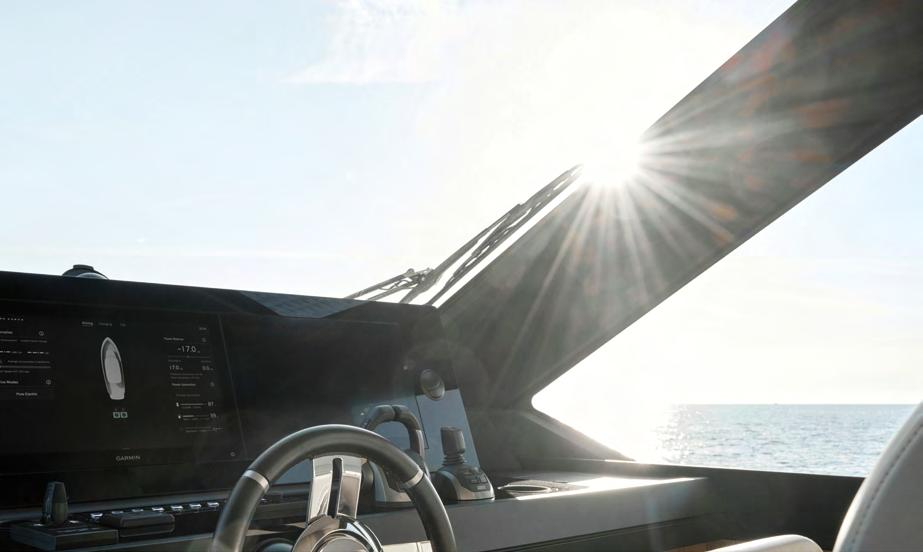
electric propulsion is prioritized, while above a certain threshold, the combustion engines take over. The Hybrid Boost Mode is designed to deliver quicker acceleration or provide extra thrust when needed. In this configuration, the diesel and electric motors work together, offering additional power during planing or in critical maneuvering situations. The Crossover Mode, still under development, will be a mixed-operation setting, allowing for simultaneous management of different energy sources based on operational profiles and the owner’s preferences. Additionally, the Hotel Mode allows onboard services to be powered exclusively by the batteries for up to 12 hours, without needing to start the generators. This option enables silent, emission-free anchoring, ensuring maximum comfort and minimal environmental impact. All components—from the engines and batteries to the joysticks and transmissions—are fully integrated and controlled by the EVC (Electronic Vessel Control) system, which manages operational modes, energy balancing, and safety systems. The system includes a Glass Cockpit System that displays real-time information on battery status, operating modes, and navigation parameters.
The Joystick Docking and Joystick Steering functions are available in both Pure Electric and Hybrid modes, as is the Dynamic Positioning System (DPS), which automatically maintains the boat’s position and heading, even in the presence of wind or current. Battery recharging occurs either while cruising, using the diesel engines, or via shore power using a standard CCS2 interface. The charging cycles are managed automatically, with the option to schedule them directly from the helm display. Thanks to the combination of the Volvo Penta hybrid package, the use of up to 40% car-

grammazione da display di plancia. Grazie alla combinazione tra il pacchetto ibrido Volvo penta, l’impiego di carbonio fino al 40% nella costruzione dello scafo, della coperta e della sovrastruttura e a un nuovo disegno di carena, il seadeck 7 è in grado di ridurre le emissioni di CO₂ fino al 40% rispetto a uno yacht planante tradizionale di pari dimensioni con linea d’asse. La carena ottimizzata e le trasmissioni Ips contribuiscono a incrementare l’efficienza idrodinamica e a ridurre i consumi, specie alle andature intermedie. In navigazione elettrica, il rumore percepito a bordo è drasticamente inferiore e la mancanza di vibrazioni migliora la qualità della vita a bordo. Lo abbiamo provato a Barcellona, dove azimut seadeck 7 si è rivelato molto reattivo alle manovre, con un
flybridge godibile anche a velocità sostenute, in cui dialogare protetti dal vento. abbiamo raggiunto la velocità massima di oltre 28 nodi, ma quella ideale di crociera è di 23 – 24 nodi. a poppa troviamo la “fun island”, con le murate abbattibili, per vivere a stretto contatto con il mare. azimut seadeck 7 ha ottenuto la certificazione rina Green plus platinum, il massimo riconoscimento in tema di sostenibilità ambientale per unità da diporto, a conferma del valore innovativo del progetto. La collaborazione tra Volvo penta e il dipartimento r\&D di azimut|Benetti mira a sviluppare ulteriormente le logiche di funzionamento, i sistemi di gestione energetica e l’interfaccia uomo-macchina, per rendere il passaggio tra le modalità di navigazione sempre più fluido e intuitivo.



bon fiber in the construction of the hull, deck, and superstructure, and a newly designed hull, the Seadeck 7 is capable of reducing CO₂ emissions by up to 40% compared to a traditional planing yacht of similar size with shaft-line propulsion. The optimized hull design and IPS drives contribute to improved hydrodynamic efficiency and reduced fuel consumption, especially at cruising speeds. under electric propulsion, onboard noise levels are drastically lower, and the absence of vibrations significantly enhances comfort and quality of life on board. We tested it in Barcelona, where the Azimut Seadeck 7 proved to be highly responsive during maneuvers, with a flybridge that remained enjoyable even at higher speeds, offering a protected space to converse out of
the wind. We reached a top speed of over 28 knots, though the ideal cruising speed is around 23–24 knots. At the stern, there’s the “Fun Island”, featuring drop-down bulwarks that create a seamless connection with the sea, offering an immersive experience close to the water. The Azimut Seadeck 7 has received the RINA Green Plus Platinum certification, the highest recognition for environmental sustainability in the yachting industry, confirming the project’s innovative value. The collaboration between Volvo Penta and the Azimut|Benetti R&D department aims to further refine the operational logic, energy management systems, and humanmachine interface, making transitions between navigation modes increasingly seamless and intuitive.
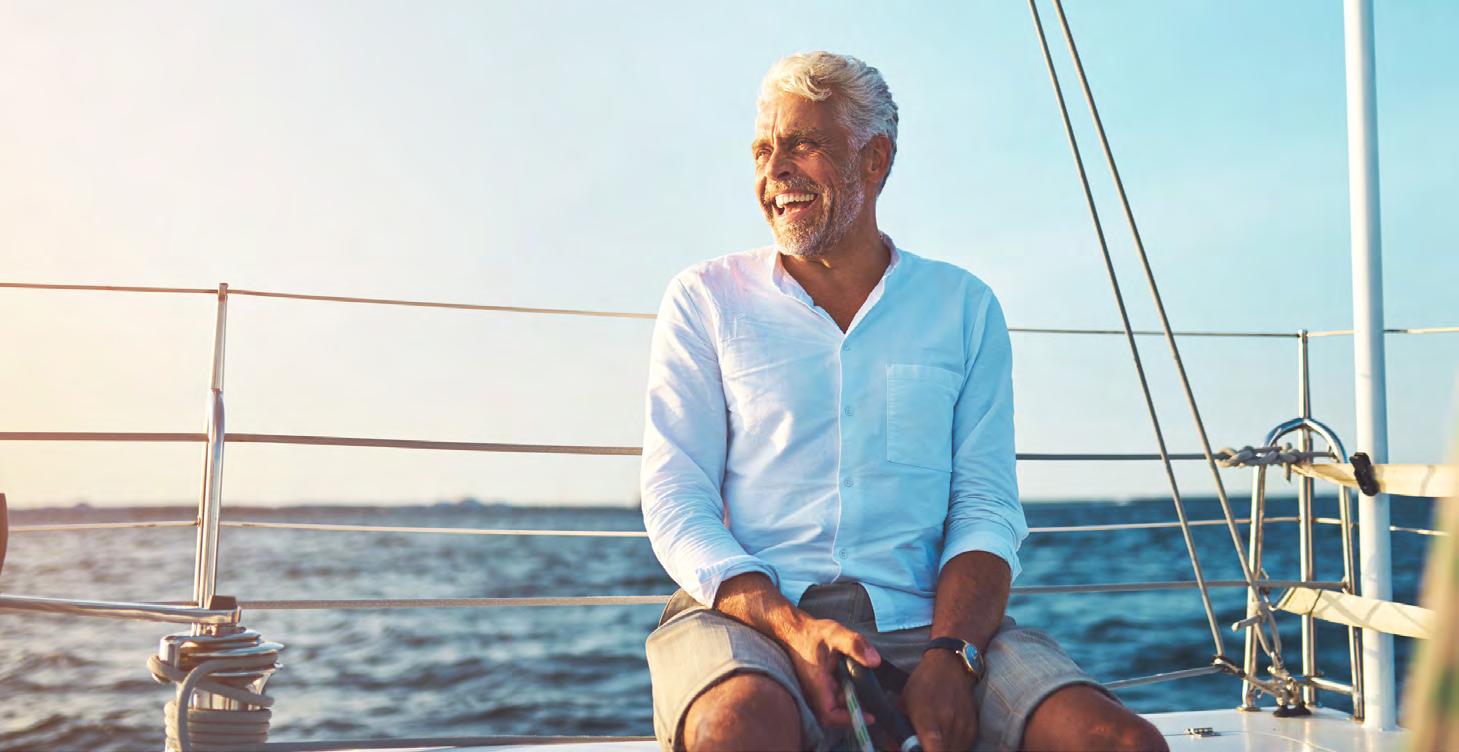
Complete range of flow solutions for yacht applications
At DESMI, we’re passionate about crafting flow solutions that elevate the yachting experience. Collaborating closely with yacht owners, operators, and shipyards, we deliver essential pumps, ballast water management systems, and supporting technologies that you can rely on for their performance and low total cost of ownership.
Together we can make a difference, whatever the future holds. Because we, like you, are here to make life flow.
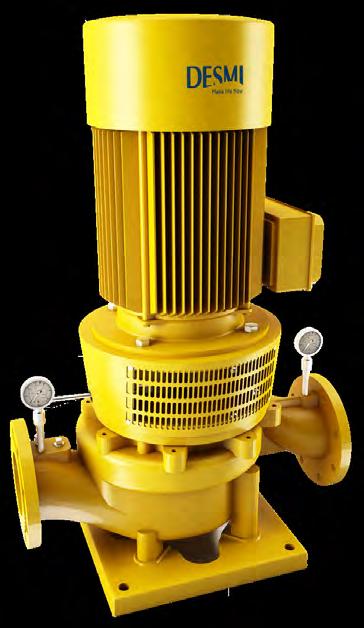
GiusEPPE orrù
PEr il salEs ManaGEr dEl cantiErE sono ancora PocHi Gli accuMulatori cErtiFicati PEr l’utilizzo Marino. il Futuro PotrEBBE EssErE nElla nuova tEcnoloGia a stato solido accordinG to the shiPYard’s sales ManaGer, there are still Few Batteries certiFied For Marine use. the Future MaY lie in new solid-state technoloGY
“ lE B att E ri E ? l’an E llo critico” “ Batteries? t he Y are the critical link”
Varato lo scorso gennaio, Istant è (disegnato da stefano Vafiadis per gli esterni e Leonardo santi per gli interni) è il primo Dom con propulsione ibrida di tipo interposto, il nuovo sistema propulsivo introdotto dal cantiere spezzino con componenti certificati dal Lloyd’s register. Il sistema è composto da due motori endotermici diesel – i Caterpillar C32 acert compatibili con biocarburanti Hvo – e due unità ibride ultracompatte dotate di motore elettrico interposto tra motore diesel e riduttore. La macchina elettrica svolge un doppio ruolo: funge da motore di propulsione in modalità elettrica
e come generatore d’asse, per ottimizzare i consumi durante le traversate, permettendo il risparmio di ore d’uso dei tradizionali gruppi elettrogeni. L’utilizzo di batterie a elevata densità energetica consente allo yacht in modalità full electric una permanenza all’ancora fino a 9 ore in completo silenzio e a zero emissioni. super YaCHt 24 ne ha parlato con il sales manager Fabio ermetto.
Cosa distingue il Baglietto Dom133 Instant dagli altri varati in passato?
“È il nostro primo yacht con propulsore elettrico interposto sull’asse invece che esterno e collegato alla
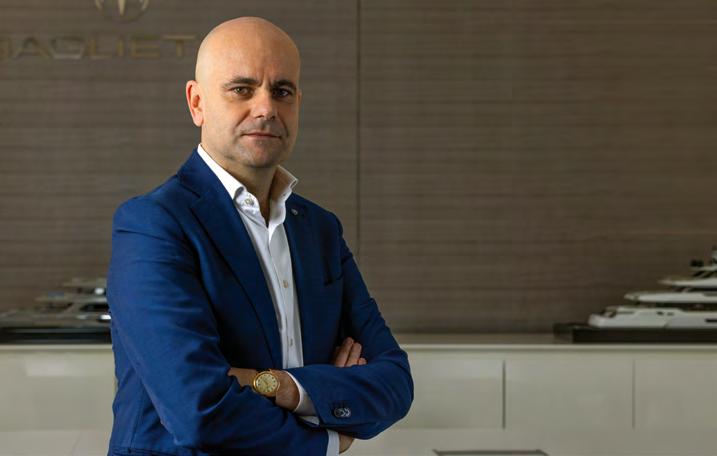
launched last January, Istant (with exterior design by Stefano Vafiadis and interior design by leonardo Santi) is the first Dom with an interposed hybrid propulsion system - the new propulsion setup introduced by the la Spezia-based shipyard, featuring components certified by lloyd’s Register. The system is composed of two internal combustion diesel engines - Caterpillar C32 Acert, compatible with Hvo biofuels - and two ultra-compact hybrid units equipped with an electric motor interposed between the diesel engine and the gearbox. The electric machine plays a dual
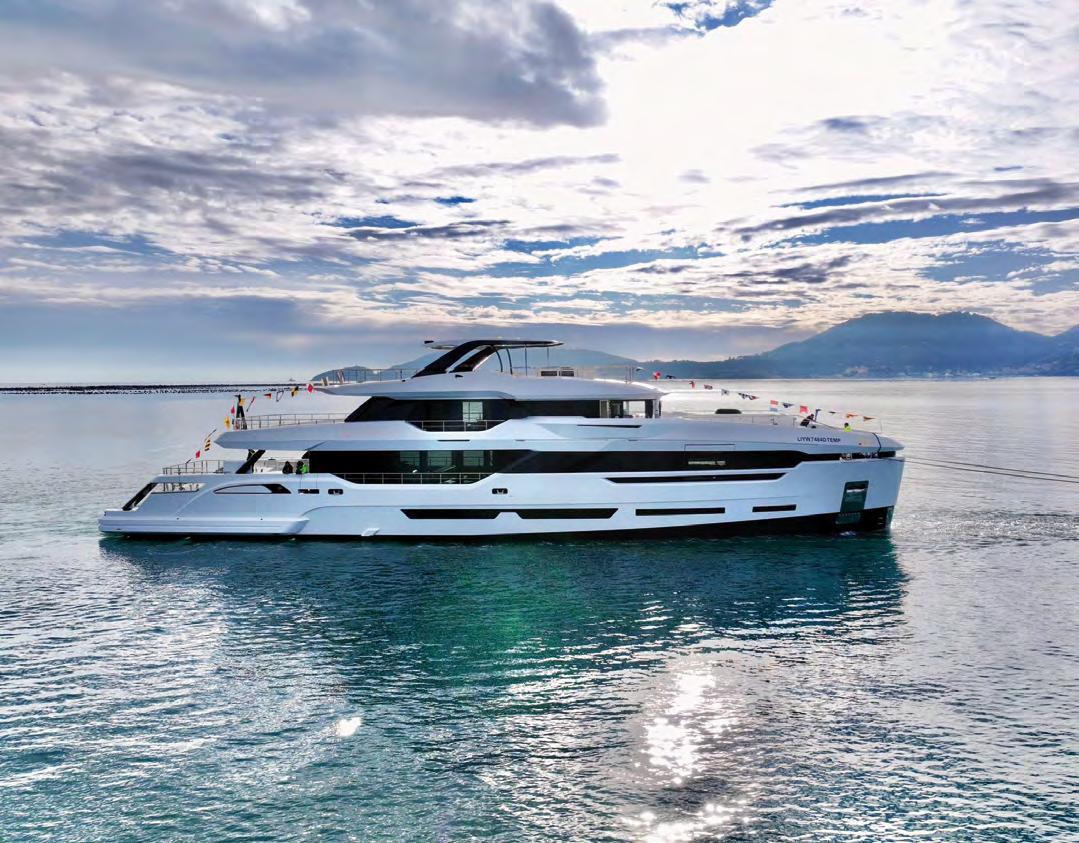
role: it functions both as a propulsion motor in electric mode and as a shaft generator, optimizing fuel consumption during crossings and saving usage hours of the traditional generators. The use of highenergy-density batteries allows the yacht, in full-electric mode, to remain at anchor for up to 9 hours in complete silence and with zero emissions. SuPER yACHT 24 spoke about it with sales manager Fabio Ermetto.
What sets the Baglietto Dom133 Instant apart from previous launches?
“It’s our first yacht with an electric motor interposed on the shaft rather than mounted externally and connected to the gearbox Pto. For a few years now, we’ve been pursuing the hybrid route together with Siemens, our main partner”.
What are its energy sources?
“The hybrid system currently includes three energy sources: combustion engines, generators, and batteries. Traditional engines are still on board and remain an important feature, especially for the yacht’s future resale value. As for the generators, we use variablespeed models, which are lighter and more compact than traditional ones. They power the electric motors and allow the yacht to cruise at limited speed without relying on combustion engines. Finally, there are the batteries. On the Dom133, we have significant battery capacity that not only enables electric cruising, but most importantly allows the yacht to remain at anchor for many hours with full hotel load - meaning kitchen, air conditioning, TV, and all onboard systems can operate at 100%”.
What are the challenges in building such systems?
“Batteries are the most critical aspect. There are very few suppliers that produce batteries certified for marine use, because








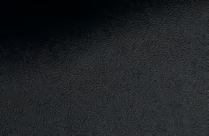






















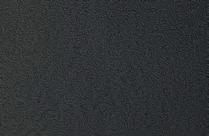






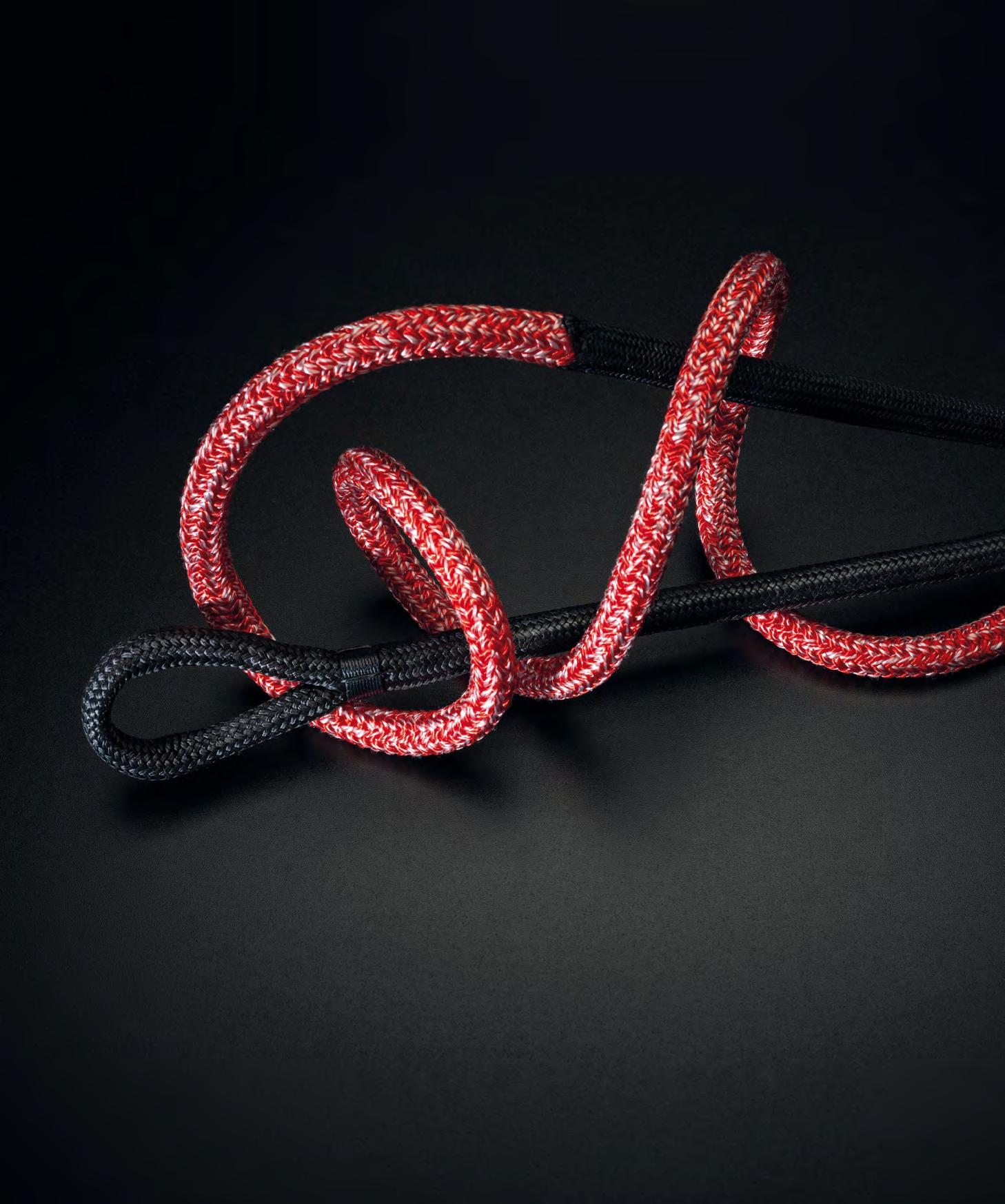

pto del cambio. Da qualche anno stiamo seguendo la strada dell’ibrido insieme a siemens, il nostro partner principale”.
Quali sono le sue fonti di energia?
“Il sistema ibrido prevede oggi tre fonti di energia: motori a combustione, generatori e batterie. I motori tradizionali rimangono a bordo e sono un aspetto importante anche per la rivendibilità futura dello yacht. Nel caso dei generatori usiamo modelli a giri variabili, più leggeri e compatti di quelli tradizionali, che alimentano i motori elettrici e permettono allo yacht di navigare a velocità limitata senza l’ausilio dei motori termici. Infine le batterie, sul Dom133 abbiamo una potenza importante che permette non solo di navigare in modalità elettrica, ma soprattutto di rimanere all’àncora per un elevato numero di ore con i servizi operativi al 100% in hotel load, quindi cucina, aria condizionata, tv e tutto quello che deve essere acceso”.
Quali sono le criticità nel realizzare sistemi del genere?
“Le batterie sono l’aspetto più critico, ci sono pochi fornitori che realizzano batterie certificate ad uso marino, poiché i numeri sono ancora oggi limitati e si preferiscono altri tipi di certificazione, per l’automotive ad esempio, che assicura numeri maggiori”.
Vede nuove tecnologie in arrivo?
“Ci sono diversi filoni di ricerca, il più importante è quello delle batterie allo stato solito. ad oggi continuiamo a produrre batterie a litio, e in ottica sostenibilità non sono il massimo perché prima o poi andranno smaltite. Vedo nelle batterie a stato solido un futuro interessante”.
Quanti yacht fate in ibrido e quali sono le limitazioni?
“Circa un 20% delle nostre imbarcazioni lo adottano. Le limitazioni sono sia di tipo economico sia di spazio, soprattutto per yacht di taglia inferiore, l’ibrido ha infatti bisogno di locali batterie e sistemi di sicurezza che sottraggono volume. Inoltre bisogna trovare un equipaggio con esperienza e professionalità, capace di usare i sistemi”. Continuate a investire?
“abbiamo sempre investito, siamo stati tra i pionieri e continueremo a farlo. Il progetto BZero a idrogeno prosegue bene e sarà la quarta fonte di energia in aggiunta alle tre viste prima, produrrà energia dall’acqua di mare tramite un processo sostenibile. L’impianto è certificato dal rina, il modello in cantiere è in scala 1 a 1 e abbiamo usato gli stessi componenti che andranno a bordo, sia per simulare condizioni reali di utilizzo sia per dimostrare ai nostri clienti che è un impianto reale e funzionante e aiutarli vincere le remore sulle novità tecnologiche”.
Quando vedremo il primo sistema BZero a bordo?
“Il sistema è pronto e funzionante
in banchina. stiamo lavorando per adattare il nostro 60 metri a ricevere l’impianto e potrebbe essere già dal prossimo modello, quindi nel 2028. s erve un armatore visionario che sia partner nell’avventura”.
Nel caso di questo Dom133 come è andata?
“Noi lo offriamo l’opzione ibrida su tutti i modelli ed è stato proprio uno dei motivi per cui il cliente si è avvicinato a Baglietto. Ha applicato la sua filosofia anche altri aspetti dello yacht, non solo alla propulsione, e negli interni lo abbiamo sostenuto in una lunga di ricerca di materiali. abbiamo sempre bisogno di armatori visionari e anche un po’ partner, come lo era stato la prima barca ibrida che abbiamo fatto ormai più di 10 anni fa, il Vanadis. all’epoca fu l’armatore a sostenerci nel realizzare l’ibrido e ancora oggi naviga con soddisfazione. È anche grazie ad armatori che hanno una visione se riusciamo a sviluppare tecnologie del genere. Vanadis è stato inoltre il primo yacht italiano certificato ibrido dal Lloyds ed è stato un importante punto di partenza, sia per il cantiere sia per il registro nello sviluppo dei regolamenti”.
Quali sono le motivazioni di chi sceglie questi sistemi?
“Le motivazioni sono sia etico-culturali, armatori che vogliono supportare i temi della sostenibilità, sia tecnologiche, soprattutto per yacht che verranno consegnati tra un paio di anni. Il progresso corre veloce e l’esigenza è non ritrovarsi con uno yacht poco aggiornato. Di base tutti gli armatori sono interessati, ma molti vengono scoraggiati dai costi o dalle complicazioni. sono convinto che più lavoreremo su questa tecnologia e più i costi si abbasseranno”.
Quanto incide l’opzione ibrida sul costo dello yacht?
“Dipende molto dal pacco batterie, ma in genere per uno yacht come il Dom133 si parte dal 10% del costo dello yacht, un impatto abbastanza importante”.
Le maggiori complicazioni?
“Noi siamo integratori di sistemi, non inventiamo nulla, compriamo componenti esistenti sul mercato, magari sviluppati per altre applicazioni. La difficoltà è proprio nell’integrarli a bordo di uno yacht in ambiente marino”.
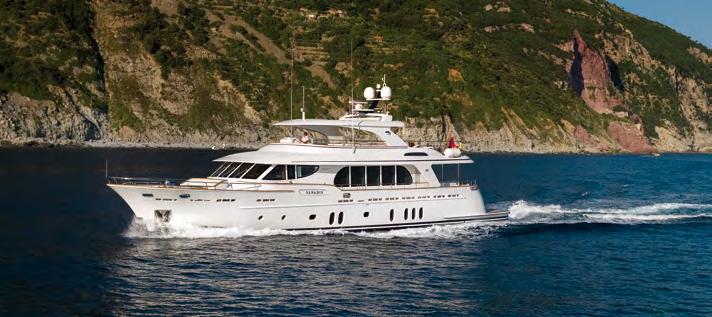
production volumes are still limited and other types of certification - for the automotive sector, for example - are preferred, since they involve higher numbers”.
Do you see new technologies on the horizon?
“There are several research avenues, but the most important is that of solid-state batteries. Today, we’re still producing lithium batteries, which, from a sustainability perspective, aren’t ideal since they will eventually need to be disposed of. I see solid-state batteries as having an interesting future”. How many of your yachts are hybrid, and what are the limitations?
“About 20% of our vessels use hybrid systems. The limitations are both economic and spatial. Especially on smaller yachts, hybrid propulsion requires battery compartments and safety systems that take up valuable space. There’s also the need to find a crew with experience and the professionalism required to operate these systems”.
Are you continuing to invest?
“We’ve always invested - we were among the pioneers and we’ll keep going. The BZero hydrogen project is progressing well and will become the fourth energy source, in addition to the three previously mentioned. It will generate energy from seawater through a sustainable process. The system is certified by Rina, and the prototype at the shipyard is full scale, using the same components that will be installed on board. This allows us both to simulate real-world conditions and to demonstrate to our clients that it’s a real, working system - helping overcome hesitation around new technologies”. When will we see the first BZero system on board?
“The system is ready and ope-
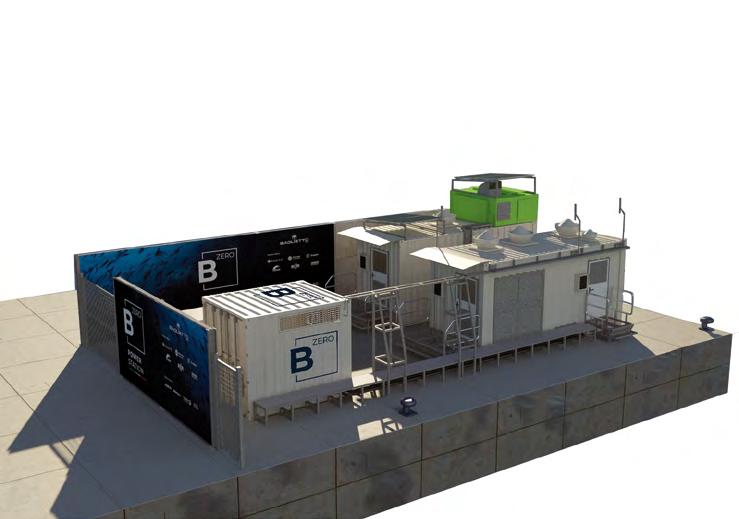
rational dockside. We’re working to adapt our 60-meter model to accommodate it, and that could be as early as the next version - so, in 2028. What we need is a visionary owner willing to partner with us on this journey”.
How did things go with this Dom133?
“We offer the hybrid option on all our models, and it was actually one of the key reasons the client chose Baglietto. He applied his philosophy not only to propulsion, but to many other aspects of the yacht. In the interiors, for example, we supported him through a long process of researching sustainable materials. We always need visionary owners - and in some ways, partners - just like with our first hybrid yacht more than 10 years ago, Vanadis. Back then, it was the owner who supported us in developing the hybrid system, and to this day, the yacht is still sailing successfully. It’s thanks to owners with vision that we’re able to develop such technologies. Vanadis was also the first Italian yacht certified as hybrid by lloyd’s, and it was a major starting point - both for the shipyard and for the classification society - in developing hybrid regulations”.
What motivates those who choose these systems?
“The motivations are both ethicalcultural - owners who want to support sustainability - and technological, especially for yachts that will be delivered in a couple of years. Progress moves fast, and there’s a real concern about ending up with an outdated yacht. In principle, all owners are interested, but many are discouraged by the costs or by the complexity. I’m convinced that the more we work on this technology, the more the costs will come down”.
How much does the hybrid option affect the cost of the yacht?
“It depends a lot on the battery pack, but generally, for a yacht like the Dom133, it starts at around 10% of the yacht’s total cost - a fairly significant impact”.
What are the main complications?
“We’re system integrators - we don’t invent anything ourselves. We purchase components already on the market, often developed for other applications. The real challenge lies in integrating them on board a yacht, in a marine environment”.
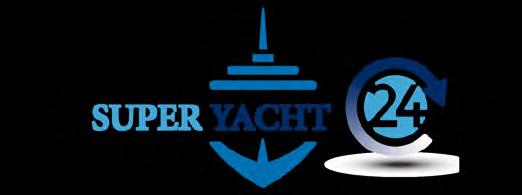

A new occasion of discussion, debate, and networking among representatives of the sailing world – from shipyards to accessory makers, from captains to designers – who will address some of the most relevant current topics for the market with a focus on technology, innovation, and materials.

December 2nd
Main topics
Evolution of shipbuilding in Italy
Suppliers and accessories: Italian excellence in sailing
Innovation and materials above and below deck, from rigging to sails to keels
Yachts and design: a successful story Made in Italy
Evolution of foils, from the America's Cup to the ocean
For more information:
info@alocinmedia.it
Ph. +39 010 9703071
Technological advancements on board
New materials and greener construction processes
Advances in hybrid technology
The perspective of the captains
Maintenance work and protocols
Crew training and safety in shipyards
Opportunities and potential of refit in Italy
The role of yachting in the Port of Genoa
alBErto Mariotti
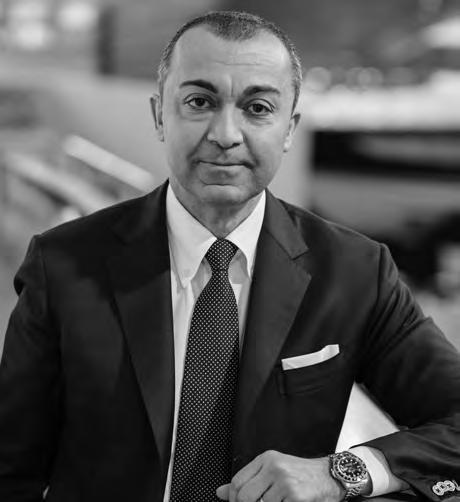
lo sPiEGa FaBrizio iarrEra, PrEsidEntE di silEnt yacHts, quando non si dicE PrEoccuPato PEr la lEntEzza dElla diFFusionE di nuovi Punti di ricarica lunGo lE costE italianE
so exPlains FaBrizio iarrera, President oF silent Yachts, while also exPressinG concern oVer the slow rollout oF new charGinG P oints alonG the italian coast
Nato nel 2008 per sfruttare unicamente l’energia del sole per la propulsione, il cantiere silent Yachts è oggi precursore in questa tecnologia con modelli tra 60 e 80 piedi e l’idea di crescere anche nel mondo oltre i 24 metri. super YaCHt 24 ha incontrato il suo presidente Fabrizio Iarrera per un punto sui progetti presenti e futuri. Fabrizio quali sono le principali sfide nel progettare un catamarano elettrico alimentato a energia solare?
“La sfida è costruire un prodotto realmente ecosostenibile, silenzioso e fruibile da armatori che non cercano performance ma silenzio, integrazione totale con l’ambiente e nessun rumore o vibrazione. Non si tratta di inventare, ma essere all’avanguardia nella capacità di integrare quanto già disponibile nell’automotive e nei settori circostanti. Nel caso di silent Yachts è anche il privilegio di esse-
re precursori, credo che ancora oggi sia l’unica offerta realmente elettrica al 100%. La nostra non è una barca ibrida ma che in anni di sviluppo ha imparato a gestire le utenze e la propulsione per navigare in modalità puramente elettrica”.
Il mercato chiede questo genere di prodotti?
“È un prodotto che risponde a un’esigenza che esiste ma che non è del 100% degli armatori, solo di quelli che vogliono avere una casa confortevole, silenziosa, spaziosa e in armonia con la natura. C’è chi la trova nella barca a vela per poi scoprire che richiede troppa energia fisica e se la famiglia cerca il comfort in vacanza è facile muoversi verso un prodotto del genere”.
Il nuovo 80 piedi indica uno sviluppo verso il mondo superyacht?
“Indica la propensione dell’azienda a non scendere sotto ai 60 piedi e ad andare oltre ai 24 metri. Il piano pre-
Founded in 2008 with the aim of using only solar energy for propulsion, the shipyard Silent yachts is now a pioneer in this technology, offering models between 60 and 80 feet and aiming to expand further into the over-24-meter market. SuPER yACHT 24 spoke with its president, Fabrizio Iarrera, for an update on current and future projects. Fabrizio, what are the main challenges in designing a solarpowered electric catamaran?
“The challenge is to build a truly eco-sustainable product - silent and usable by owners who aren’t seeking performance, but rather silence, full integration with the environment, and no noise or vibration. It’s not about inventing something new, but about being at the forefront in the ability to integrate what’s already available in the automotive and related sectors. In the case of Silent yachts, it’s also
a privilege to be a pioneer. I believe ours is still the only truly 100% electric offering on the market. Our yacht is not a hybrid - it’s the result of years of development to manage onboard systems and propulsion in a way that allows for fully electric cruising”.
Is the market asking for this type of product?
“It’s a product that meets a specific demand - not from 100% of yacht owners, but from those who want a comfortable, quiet, spacious home in harmony with nature. Some people look for that in sailing yachts, but then realize they require too much physical effort. When a family is looking for comfort on vacation, it’s easy to gravitate toward a product like ours”.
Does the new 80-footer signal a move toward the superyacht segment?
“It shows the company’s intent not to go below 60 feet and to expand
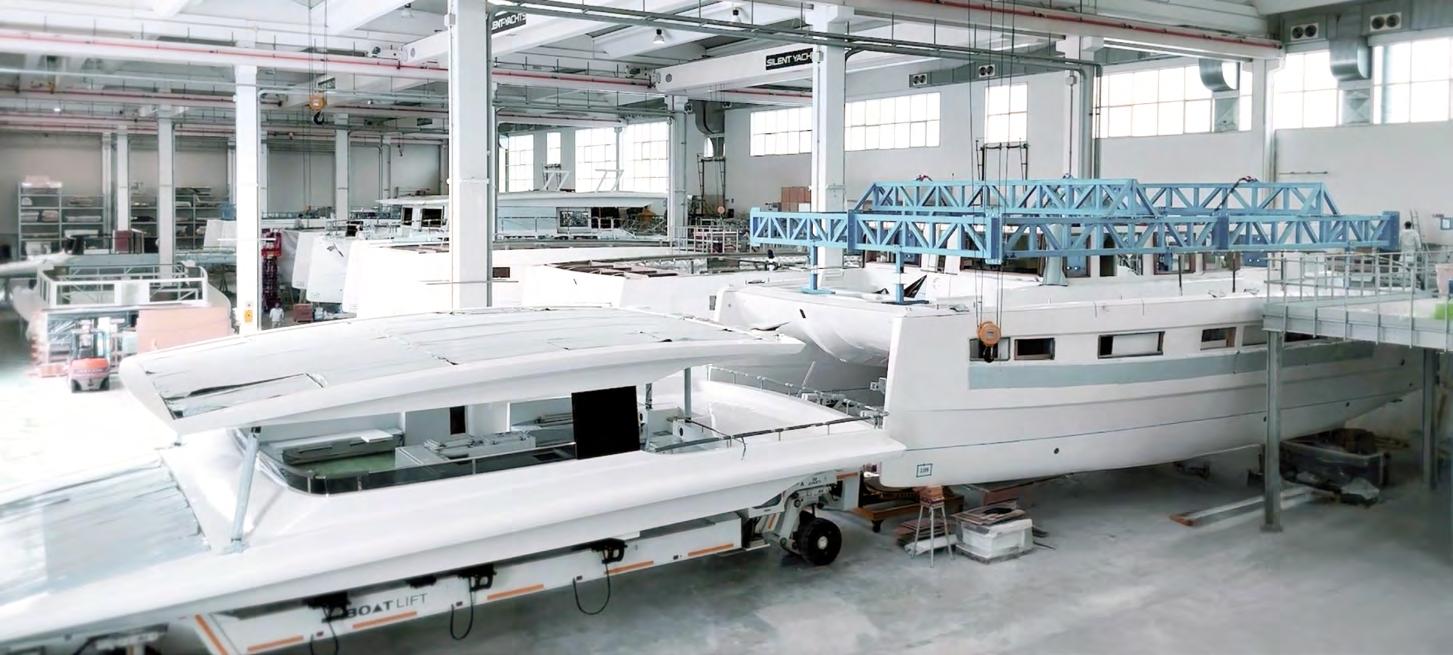
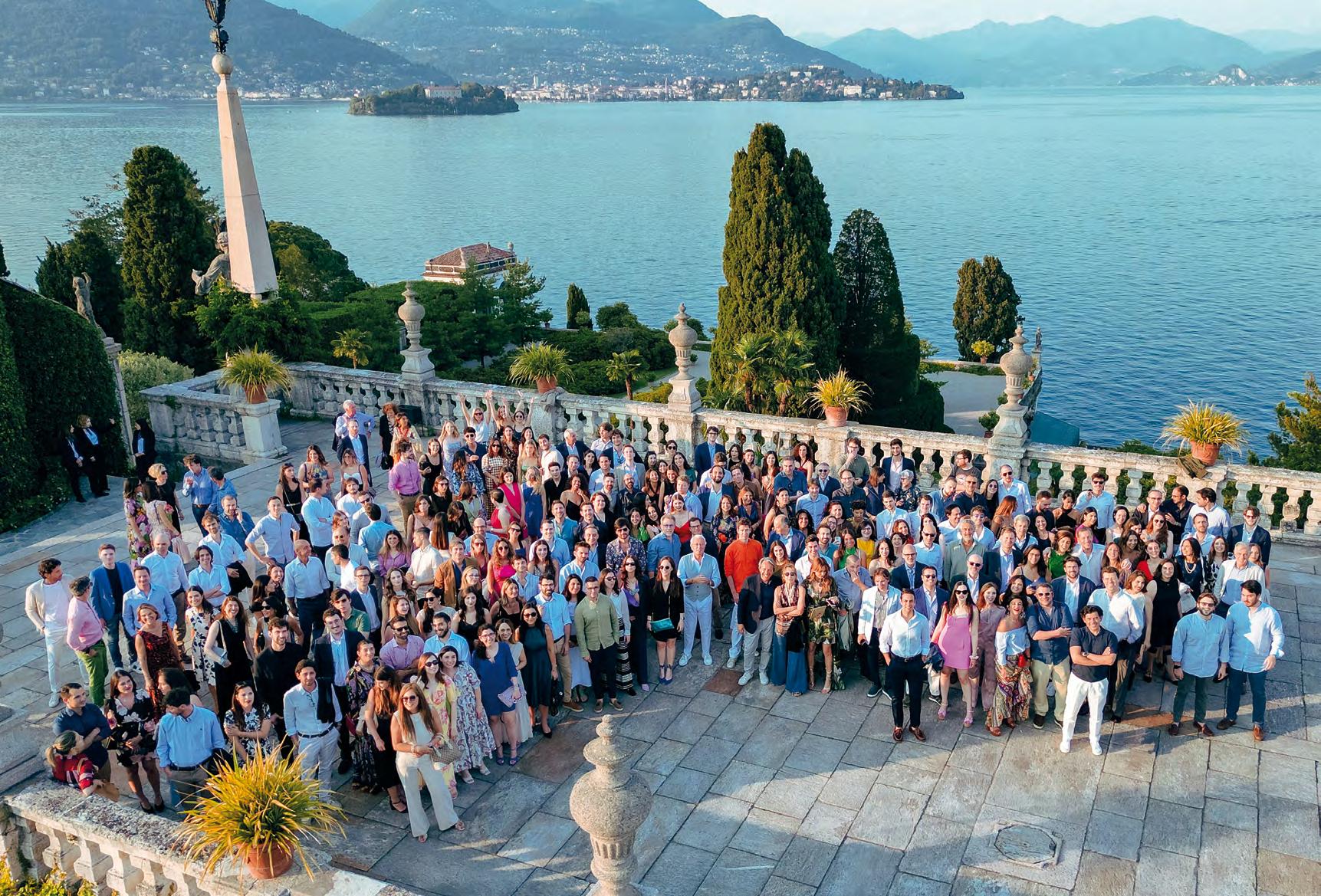

LCA è uno studio legale indipendente e full service specializzato nell’assistenza legale e fiscale d’impresa, con oltre 280 professionisti attivi in tutte le principali aree del diritto, e una consolidata esperienza nel settore della nautica da diporto
Il nostro team dedicato assiste armatori, cantieri, broker, istituti di credito e altri operatori del settore nella redazione e negoziazione di contratti di compravendita, costruzione, finanziamento e leasing di yacht, oltre alla gestione di equipaggi e contratti di noleggio.
Offriamo assistenza nei contenziosi marittimi – in caso ad esempio di collisioni, danni a terzi, salvataggi – e nei procedimenti giurisdizionali e arbitrali; supportiamo inoltre importanti marine nella redazione di contratti di ormeggio e nei rapporti con gli armatori e le amministrazioni competenti.
vede di completare tutto il necessario per la gamma fino a 80 piedi, costruire correttamente la rete vendita mondiale, creare brand awareness e soprattutto una base di clienti che possa crescere con il cantiere”.
La diffusione dei catamarani elettrici aumenterà?
“Ne sono certo, è come tesla che nel 2010 non avevo capito. Ne sono certo perché è una soluzione naturale, un monoscafo non riesce a generare energia sufficiente per coniugare servizi e propulsione, un catamarano solare può farlo grazie alla superfice offerta dalla sua struttura”.
La progettazione di un cat elettrico al 100% è diversa?
“si parte sapendo che il tetto è il tuo generatore di energia e capendo quanto velocemente serve produrre tutta l’energia necessaria per essere coerenti nella promessa. partiamo quindi da capire quanti kWh di capacità nominale dei pannelli solari servono al cliente e da lì si disegna grazie a Nuvolari Lenard la barca più bella possibile”.
State lavorando a soluzione alternative come l’idrogeno?
“siamo concentrati sui sistemi di accumulo dell’energia, rimaniamo solari e il nostro slogan è ‘solar powered’ ma c’è molto da fare. Intorno a noi ci sono 8 miliardi di persone che chiedono pannelli solari più efficaci, batterie più capaci, leggere e sicure. abbiamo un mondo di sviluppo prodotto che dobbiamo essere capaci di integrare nel nostro. È possibile comprare separatamente ognuno di questi componenti, ma la barca non funzionerà se non hai imparato cosa fare per installarli correttamente e integrarli nei sistemi di gestione elettronica”.
Per le batterie vede nuove tecnologie in arrivo?
“Le batterie a stato solido sono il futuro ed è la direzione nella quale essere attenti a seguire l’evoluzione per progetti a 3-5 anni. per il momento usiamo il meglio oggi disponibile, e cioè la tecnologia al litio-ferrofosfato grazie ad accumulatori più compatti, molto più sicuri e con capacità importanti – a parità di unità di volume e di stoccaggio di energia – rispetto a pochi anni fa”.
Esiste un problema di sicurezza legato alle batterie?
“È la prima domanda dei clienti che non conoscono bene il prodotto. Dalla nostra abbiamo l’esperienza di un’azienda che ha fatto sviluppo per anni e nei quali ha creato la risposta corretta rispetto ai possibili problemi legati a batterie con tecnologie precedenti ormai superate”.
Come giudica la situazione dei punti di ricarica lungo le coste italiane?
“Non voglio essere polemico, ma la situazione corrisponde, con il dovuto numero di anni di ritardo, alla situazione dell’elettrificazione della rete stradale. Oggi è facile comprare un’auto elettrica, ma non è adatta a lunghe percorrenze. Da questo punto
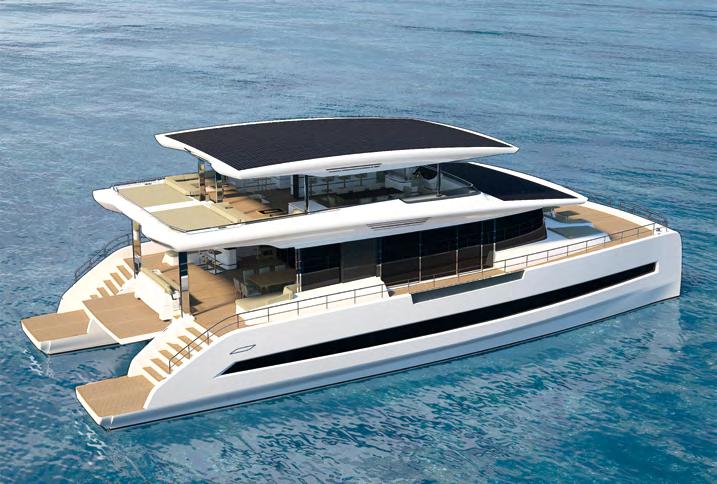
di vista siamo avvantaggiati, i nostri modelli sono essi stessi una stazione di ricarica continua”.
Cosa accade quando non c’è il sole?
“abbiamo un sistema ‘tradizionale’ di produzione dell’energia come il generatore, o più di uno, che alimenta direttamente le batterie nei giorni in cui quella solare non è sufficiente per la propulsione. Il carburante fossile non serve per la propulsione, ma solo per ricaricare le batterie. una differenza importante”.
Quanto viene usato il generatore in media?
“Il 60 piedi può navigare 200 miglia nell’arco di un paio di settimane muovendosi da un’isola all’altra accendendo il generatore per qualche ora, appena 3 o 4 ore sulle 200 di utilizzo totale dello yacht”.
È come un catamarano a vela.
“sì, ma nella realtà se non è performanti anche il catamarano a vela andrà a motore, come ho visto nel 99% dei casi”.
In termini di prestazioni com’è il confronto con un catamarano a motore tradizionale?
“Dicevamo che è come un catamarano a vela, quindi naviga in crociera tra 6 e 8 nodi, velocità massima tra 10 e 12 nodi. Nei lunghi trasferimenti ogni 4-5 ore di navigazione in elettrico si accende il generatore per riportare al le batterie al 100% di carica in circa 40/60 minuti. Il modello base ha 348 KWh di capacità di accumulo, in una giornata di sole estiva produce 100120 KWh di energia, sufficiente per muoversi tra le isole tenendo costantemente accesa l’aria condizionata e tutte le utenze legate al comfort”. Parliamo di autonomie.
“L’apporto di combustibile fossile è minimo, le nostre barche hanno serbatoi da mille o duemila litri per completare un’autonomia che su barche tradizionali sarebbe definita extra long con 1.500 miglia di range a velocità di crociera economica. I silent arrivano a 4/5.000 miglia di autonomia a velocità economica. Il modello più piccolo ha 17 kW di pannelli solari, potenza ben maggiore di quanto viene normalmente installato su case di dimensioni analoghe, e tutto il surplus di energia creata serve per la propulsione”.
beyond 24 meters. The plan is to complete everything needed for the range up to 80 feet, properly build a global sales network, create brand awareness, and - most importantly - a customer base that can grow alongside the shipyard”. Will the adoption of electric catamarans increase?
“I’m certain of it. It’s like Tesla in 2010 - I didn’t understand it back then, but I do now. It’s a natural solution. A monohull can’t generate enough energy to support both onboard services and propulsion, whereas a solar catamaran can, thanks to the large surface area provided by its structure”.
Is designing a fully electric catamaran
“yes, you begin with the understanding that your roof is your energy generator, and you must figure out how quickly you need to generate all the energy required to deliver on your promise. So we start by determining how many kWh of nominal capacity the solar panels need to provide, and from there, with Nuvolari lenard, we design the most beautiful yacht possible”. Are you working on alternative solutions like hydrogen?
“Our focus is on energy storage systems. We remain solar - our slogan is solar powered - but there’s still a lot to do. There are 8 billion people around us asking for more efficient solar panels, batteries that are higher-capacity, lighter, and safer. We have a whole world of product development to integrate into our systems. you can buy each of these components separately, but the yacht won’t function if you haven’t learned how to install and integrate them properly into the electronic management systems”.
Do you see new battery technologies on the horizon?
“Solid-state batteries are the future and it is the direction in which we must be careful to follow the evolution for 3-5 year projects. For the time being, we are using the best available today, namely lithiumiron-phosphate technology with more compact, much safer accumulators and with larger capacities - in the same volume and energy storage units - than a few years ago. ‘Our photovoltaic cat reduces
dependence on the electricity grid’. Is there a safety issue related to batteries?
“This is the first question from customers who are not familiar with the product. On our side we have the experience of a company that has been doing development for years and in which we have created the correct answer to possible problems with batteries with previous outdated technology.
How do you assess the situation with charging stations along the Italian coastline?
“I don’t want to be polemical, but the situation mirrors, with several years’ delay, what we saw with the electrification of the road network. Today, buying an electric car is easy, but it’s still not suitable for longdistance travel. From this point of view, we have an advantage - our models are themselves continuous charging stations”.
What happens when there’s no sun?
“We have a ‘traditional’ energy generation system - a generator, or more than one - that charges the batteries on days when solar energy isn’t sufficient for propulsion. Fossil fuel is used only to recharge the batteries, not to power the propulsion system. That’s a key difference”.
How often is the generator used on average?
“A 60-footer can cover 200 miles over a couple of weeks, islandhopping, with just a few hours of generator use - about 3 or 4 hours over the yacht’s 200 hours of total operation”.
So it’s like a sailing catamaran?
“yes, but in reality, if it’s not performing well, even a sailing catamaran ends up using its engine - which I’ve seen in 99% of cases”.
In terms of performance, how does it compare with a traditional motor catamaran?
“As we said, it’s comparable to a sailing cat - cruising between 6 and 8 knots, with a top speed between 10 and 12 knots. For long passages, after every 4–5 hours of electric navigation, the generator kicks in to bring the batteries back to 100% in about 40 to 60 minutes. The base model has a storage capacity of 348 kWh, and on a sunny summer day, it generates 100–120 kWh - enough to cruise between islands while running air conditioning and all comfortrelated utilities continuously”.
Let’s talk about range.
“The use of fossil fuel is minimal. Our boats have tanks of 1,000 to 2,000 liters to supplement an autonomy that, on traditional yachts, would already be considered ‘extra-long’ - around 1,500 miles at economical cruising speed. Silent yachts can reach 4,000 to 5,000 miles of range at that same economical speed. Our smallest model is equipped with 17 kW of solar panels - more power than is typically installed on homes of similar sizeand all surplus energy generated is used for propulsion”.
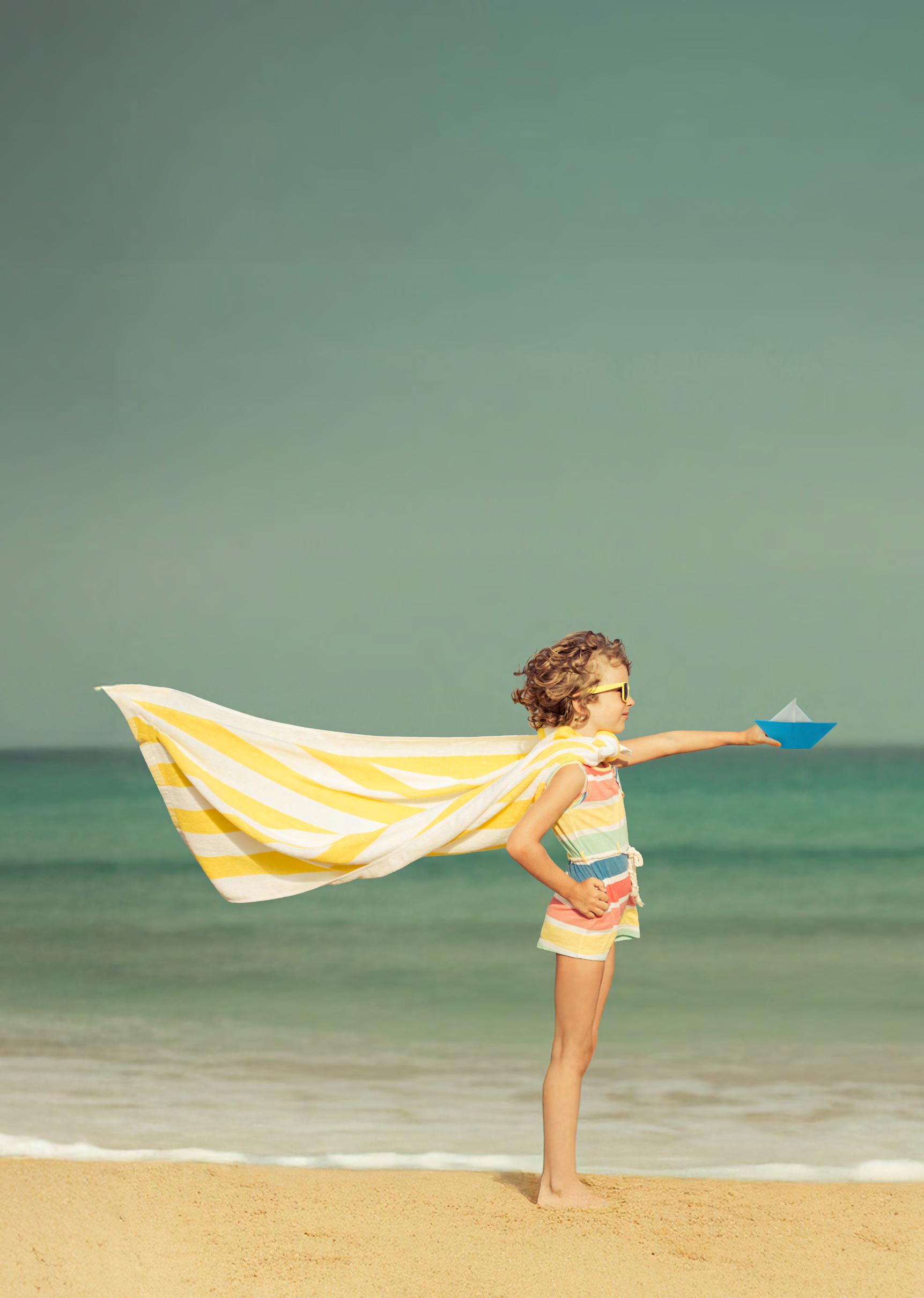
Just like superheroes. Always by your side, ensuring a smooth yachting experience.

Our experience. Your growth.
alBErto Mariotti
sEcondo il GEnEral ManaGEr dEll’aziEnda i nuovi sistEMi sono Più lEGGEri, EFFiciEnti E l’autonoMia di naviGazionE è in costantE crEscita
accordinG to the coMPanY’s General ManaGer, the new sYsteMs are liGhter, More eFFicient and with increasinGlY More iMPortant cruisinG ranGe
La propulsione elettrica fatica ancora ad affermarsi, soprattutto in Italia dove le infrastrutture di supporto si stanno sviluppando lentamente. ma secondo Davide Baldereschi, general manager della divisione italiana di Vetus maxwell, i motori elettrici sono più confortevoli, affidabili, meccanicamente più semplici e, a lungo termine, anche più economici.
Quali sono i migliori vantaggi della propulsione elettrica?
“La trasformazione è tecnica ed esperienziale, ma i vantaggi vanno oltre il comfort. I motori elettrici offrono coppia istantanea e controllo preciso, il che rende le manovre, soprattutto a bassa velocità, più facili e sicure. Il sistema reagisce all’istante ai comandi, a differenza dei tradizionali motori che spesso hanno ritardi o rispondono in modo inconsistente a bassi giri. Inoltre, c’è un enorme vantaggio ambientale: zero emissioni nel punto di utilizzo, contribuendo ad aria e acqua più pulite ovunque tu navighi”. Si risparmia rispetto al carburante o l’investimento annulla il vantaggio?
“sebbene sia vero che l’investimento può essere più alto, il quadro finanziario a lungo termine è convincente. I motori elettrici hanno meno parti mobili e quindi meno manutenzione. Non c’è bisogno di cambi d’olio, nuovi filtri o manutenzione regolare: nel corso della vita del sistema, questo si traduce in risparmi sostanziali. ancora più importante, i costi operativi sono inferiori. L’elettricità è più economica del carburante, soprattutto quando la ricarica avviene in porto o addirittura a casa, per le imbarcazioni più piccole. e considerando quanto sono aumentati i prezzi del carburante, la propulsione elettrica offre un certo grado di indipendenza dalle fluttuazioni del mercato. Nel tempo, il costo per miglio è
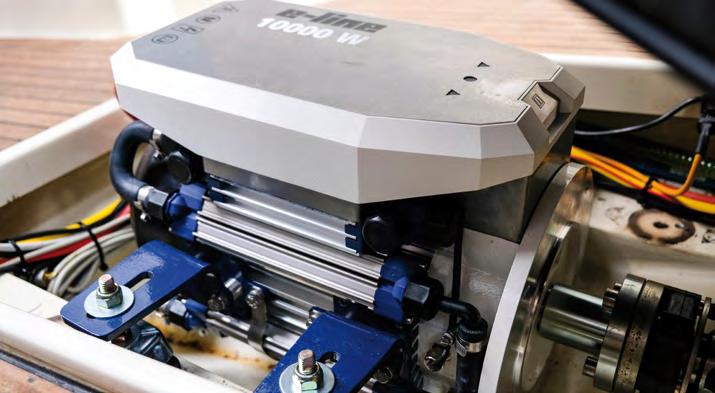
più prevedibile e inferiore”. Come vede la situazione dei punti di ricarica in Italia?
“L’infrastruttura si sta espandendo, ma non è ancora del tutto matura. ma la disponibilità attuale supporta già la maggior parte dei casi d’uso tipici. La maggior parte dei diportisti non attraversa oceani, si gode qualche ora sull’acqua, si ancora per pranzo e ritorna in porto. anche una sola stazione di alimentazione da terra in un porto turistico può essere più che sufficiente per le esigenze quotidiane. Con l’aumento della consapevolezza, cresce anche l’investimento nelle infrastrutture. L’Italia, come molte parti d’europa, sta iniziando ad abbracciare la nautica elettrica, in particolare nelle aree ambientalmente sensibili o dove le normative sulle emissioni stanno diventando più severe. I sistemi Vetus sono progettati per essere compatibili con l’infrastruttura attuale e allo stesso tempo pronti per il futuro”.
Perché il suo sviluppo è così lento? “molto dipende dalla percezione. I primi tentativi di elettrificazione marina, sebbene innovativi, si basavano su componenti poco marinizzati e batterie pesanti. Quelle prime esperienze persistono nella memoria collettiva, e le persone presumono che nulla sia cambiato. ma è cambiato, drasticamente. In Vetus offriamo sistemi integrati che eliminano tutte le incertezze. Non c’è più bisogno di mettere insieme motori, controller e batterie da diversi fornitori e sperare che funzionino tutti insieme. I nostri sistemi e-Drive sono plug-and-play, scalabili e testati per l’affidabilità. più le persone sperimentano questi sistemi, più velocemente avverrà il cambiamento”.
Come sono migliorate autonomia e prestazioni?
“C’è stato un enorme passo avanti.
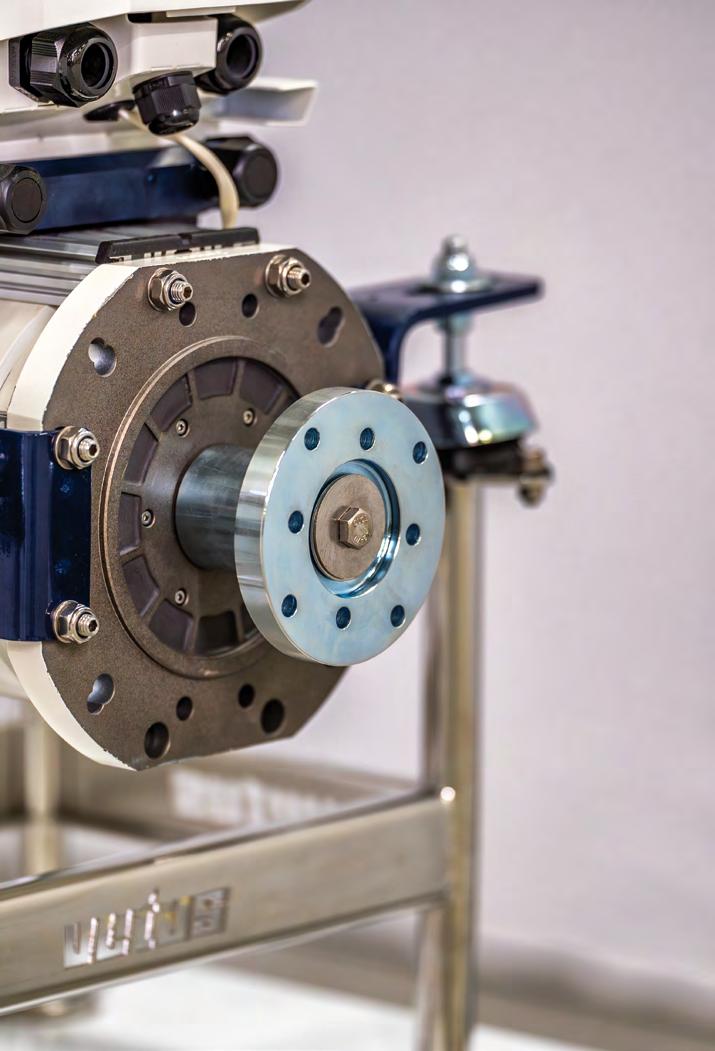
Electric propulsion still struggles to gain widespread adoption, especially in Italy, where support infrastructure is developing slowly. However, according to Davide Baldereschi, General Manager of the Italian division of Vetus Maxwell, electric motors are more comfortable, more reliable, mechanically simpler, and, in the long run, more economical. What are the main advantages of electric propulsion?
“The transformation is both technical and experiential, but the benefits go beyond comfort. Electric motors deliver instant torque and precise control, making maneuversespecially at low speeds-easier and safer. The system responds immediately to commands, unlike
traditional engines that often have delays or react inconsistently at low RPMs. There’s also a major environmental benefit: zero emissions at the point of use, helping keep the air and water cleaner wherever you sail”. Is there real savings compared to fuel, or does the investment cancel out the benefit?
“While it’s true that the initial investment can be higher, the longterm financial picture is compelling. Electric motors have fewer moving parts, which means less maintenance. There’s no need for oil changes, new filters, or regular servicing-over the system’s lifetime, this results in significant savings. More importantly, operating costs are lower. Electricity is cheaper than fuel,

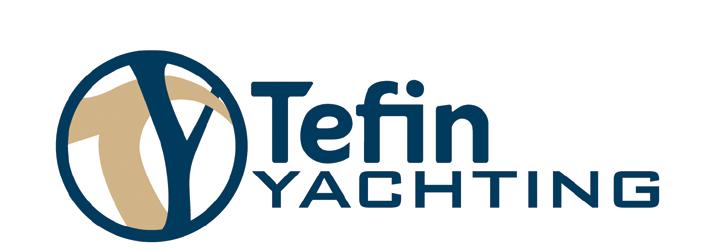
Tefin Yachting nasce dall’esperienza trentennale di Tefin nell’assistenza elettrica ed elettronica navale. Abbiamo creato una divisione altamente specializzata nel settore dei super e giga yacht, con un focus specifico sui sistemi di NavCom (navigazione e comunicazione) e di automazione, per garantire che ogni viaggio sia sicuro, connesso e indimenticabile.
La Divisione Yachting si articola in 5 settori specializzati:
1. Navcom
2. Automazione
3. Entertainment
4. Safety
5. Security

I nostri partner:
• Rappresentiamo con orgoglio i principali marchi del settore, tra cui: Anschuetz, Jrc/ Alphatron Marine, Simrad, Sailor, Netwave, Saab, Sea Tel, WartsilaTransas, Kingsat, Farsounder, Skipper, Intellian, Consilium, e Danfoss Drives.
I nostri punti di forza:
• Esperienza Consolidata: Sfruttiamo la nostra profonda conoscenza del settore navale per offrire soluzioni all’avanguardia per yacht di lusso.
• Specializzazione NavCom: Siamo esperti nell’installazione, manutenzione e aggiornamento dei più sofisticati sistemi di navigazione e comunicazione (radar, girobussole, VDR, piloti automatici).
• Assistenza Globale 24/7: La tua tranquillità è la nostra priorità. Il nostro team di tecnici certificati è a tua disposizione 24 ore su 24, 7 giorni su 7, pronto a intervenire in porto, in bacino, in rada e persino in navigazione, in ogni angolo del mondo.
• Servizi Completi: Offriamo un’ampia gamma di servizi che includono refitting NavCom, conversioni, supporto per nuove costruzioni, programmi di manutenzione personalizzati e gestione della conformità GMDSS.
• Connettività Senza Interruzioni: Rimani connesso ovunque tu vada con le nostre antenne di comunicazione satellitare ad alte prestazioni e il nostro servizio di manutenzione dedicato.
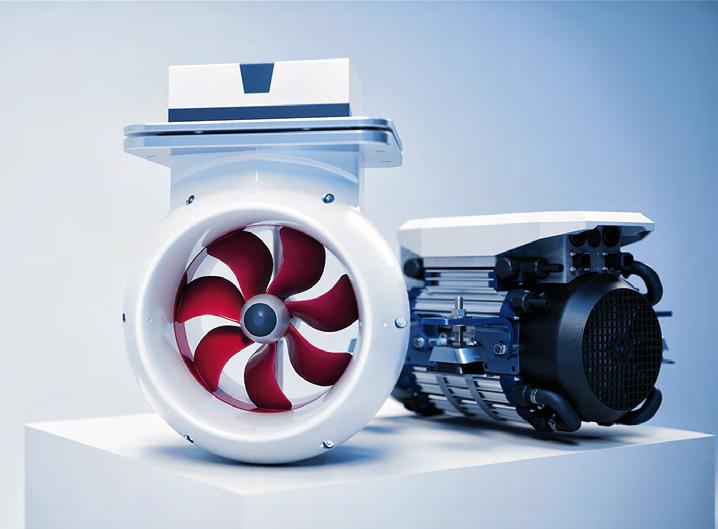
I primi sistemi elettrici marini erano limitati da batterie pesanti e componenti inefficienti. L’attuale tecnologia delle batterie agli ioni di litio è più leggera, ha una maggiore densità energetica ed è capace di cicli di scarica più profondi. Questo riduce il peso complessivo, rendendo le imbarcazioni più efficienti e aumentando l’autonomia. I sistemi Vetus eDrive sono progettati con efficienza a ogni livello, dal motore e controller al pacco batterie e sistema di raffreddamento. una delle caratteristiche chiave è l’integrazione con le reti Nmea2000 e il nostro shunt proprietario, che fornisce dati accurati in tempo reale sulla carica rimanente e l’autonomia stimata. Questo dà ai comandanti la fiducia necessaria per pianificare uscite più lunghe senza il timore di rimanere senza energia”. Per quali tipi, dimensioni o utilizzi la propulsione elettrica rappresenta un vantaggio?
“I nostri sistemi sono abbastanza versatili da supportare un’ampia varietà di imbarcazioni. per esempio, il motore Vetus e-Line è ideale per natanti da circa 11 metri in su, inclusi yacht a vela, motoscafi e imbarcazioni da canale. È progettato per adattarsi ai vani motore esistenti e alle installazioni degli assi dell’elica, rendendolo una scelta pratica sia per nuove costruzioni che per refit. Il sistema epod è una soluzione più compatta e ad alta efficienza che integra motore, raffreddamento, cambio ed elica in un unico pod subacqueo. È adatto per il retrofit di barche a vela con saildrive o per la realizzazione di progetti nuovi che risparmiano spazio per imbarcazioni elettriche. entrambi i sistemi sono costruiti per la modularità, così costruttori e proprietari possono adattare le prestazioni alle loro esatte necessità, che si tratti di maggiore potenza, autonomia estesa o semplicità di installazione”. Un’imbarcazione a vela con propulsione elettrica è sicura quanto una tradizionale?
“sì, e per molti aspetti, è persino più sicura. I motori elettrici sono affidabili e richiedono pochissima manutenzione ordinaria. I motori a combustione interna si basano su una serie
di parti meccaniche complesse e in movimento che possono guastarsi inaspettatamente, i motori elettrici sono semplici, con pochi componenti soggetti a usura. In termini di controllo, si ottiene una precisione impossibile da raggiungere con un motore diesel. Il passaggio tra marcia avanti e retromarcia è istantaneo, permettendo di rispondere rapidamente in luoghi stretti o durante l’attracco. Questo livello di reattività non solo migliora la sicurezza ma riduce anche lo stress per il comandante e l’equipaggio, soprattutto in condizioni meteorologiche non ideali”.
Quali sono i falsi miti più duri a morire?
“uno dei più grandi è che le barche elettriche non abbiano autonomia o potenza sufficiente. Questo poteva essere vero un decennio fa, ma oggi i nostri sistemi possono alimentare imbarcazioni durante escursioni di un’intera giornata con facilità. un altro mito è che passare all’elettrico ‘sposta solo l’inquinamento altrove’. ma la realtà è che l’elettricità viene sempre più generata da fonti rinnovabili, e anche quando non lo è, le centrali elettriche sono molto più efficienti dei piccoli motori a combustione interna. Le persone pensano anche che l’elettrico sia complicato. al contrario, è più semplice, ci sono meno cose che possono andare storte, e la poca manutenzione richiesta è minima. una volta che i diportisti fanno il passaggio, spesso si chiedono perché non l’abbiano fatto prima”. Qualcuno sostiene che la propulsione elettrica non è competitiva. “Direi che la propulsione elettrica non è solo competitiva, è spesso superiore. sì, ci sono ragioni ambientali per passare all’elettrico, e sì, la legislazione sta spingendo l’industria in questa direzione. ma ciò che è più importante è che l’esperienza è migliore. È più silenziosa, più pulita, più fluida e, a lungo termine, più economica. Non chiediamo ai diportisti di fare il cambio perché devono farlo. Vogliamo che cambino perché godranno più la loro imbarcazione. Questa è la missione di Vetus: rendere la nautica più piacevole, accessibile e responsabile dal punto di vista ambientale”.
especially when charging happens in port or even at home, for smaller boats. And considering how much fuel prices have risen, electric propulsion offers a degree of independence from market fluctuations. Over time, the cost per mile is more predictable and lower”.
How do you see the situation of charging points in Italy?
“The infrastructure is expanding, but it’s not fully mature yet. However, the current availability already supports most typical use cases. Most boaters aren’t crossing oceans - they spend a few hours on the water, anchor for lunch, and return to the marina. Even a single shore power station at a marina can be more than enough for daily needs. As awareness grows, so does investment in infrastructure. Italy, like many parts of Europe, is beginning to embrace electric boating, especially in environmentally sensitive areas or where emissions regulations are becoming stricter. Vetus systems are designed to be compatible with existing infrastructure while also being future-ready”. Why is its development so slow?
“A lot depends on perception. The first attempts at marine electrification, while innovative, relied on components that weren’t properly marinized and on heavy batteries. Those early experiences linger in the collective memory, and people assume nothing has changed. But it has - drastically. At Vetus, we offer integrated systems that eliminate all uncertainty. There’s no longer a need to piece together motors, controllers, and batteries from different suppliers and hope they work together. Our E-Drive systems are plug-and-play, scalable, and tested for reliability. The more pe ople experience these systems, the faster the transition will happen”. How have range and perfor mance improved?
“There has been a huge leap forward. Early electric marine systems were limited by heavy batteries and inefficient compo nents. Today’s lithium-ion battery technology is lighter, has higher energy density, and allows for dee per discharge cycles. This reduces overall weight, makes vessels more efficient, and increases range. Ve tus E-Drive systems are designed for efficiency at every level - from the motor and controller to the battery pack and cooling system. One key feature is the integration with Nmea2000 networks and our proprietary shunt, which provides accurate real-time data on remai ning charge and estimated range. This gives skippers the confidence to plan longer trips without fear of running out of power”.
boats. It’s designed to fit existing engine compartments and propeller shaft setups, making it a practical choice for both new builds and refits. The E-Pod system is a more compact, high-efficiency solution that integrates the motor, cooling, gearbox, and propeller into a single underwater pod. It’s well suited for retrofitting sailboats with a saildrive or for new electric boat designs that prioritize space savings. Both systems are built for modularity, so builders and owners can tailor performance to their exact needs - whether that means more power, extended range, or ease of instal lation”.
Is a sailing boat with electric propulsion as safe as a traditio nal one?
“yes - and in many ways, it’s even safer. Electric motors are relia ble and require very little routine maintenance. Internal combustion engines rely on a complex system of moving mechanical parts that can fail unexpectedly, whereas electric motors are simple, with few wear-prone components. In terms of control, you get a level of preci sion that’s impossible to match with a diesel engine. Switching between forward and reverse is instanta neous, allowing quick responses in tight spaces or during docking. This responsiveness not only improves safety but also reduces stress for the skipper and crew, especially
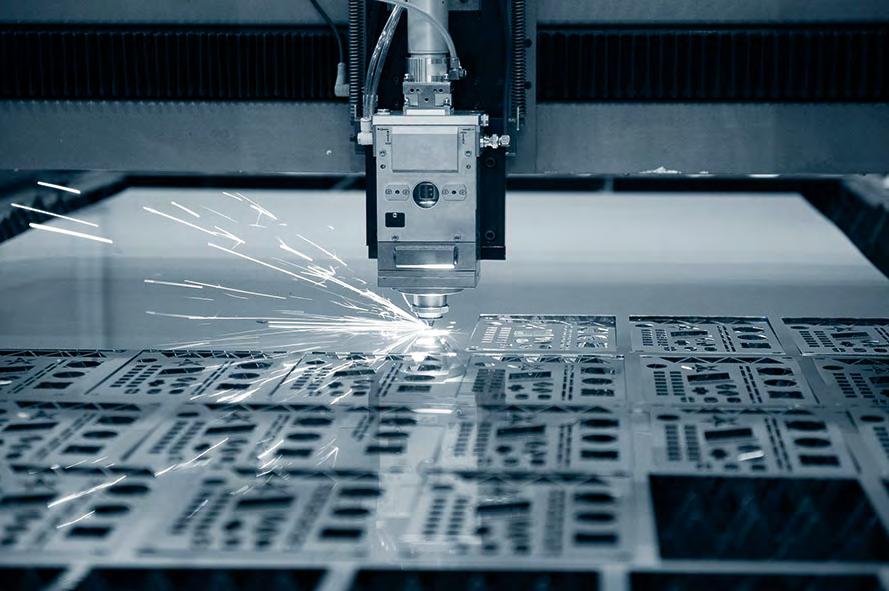

For what types, sizes, or uses is electric propulsion an advantage?
“Our systems are versatile enough to support a wide variety of boats. For example, the Vetus E-line motor is ideal for vessels around 11 meters and up, including sailing yachts, motorboats, and canal
It’s quieter, cleaner, smoother, and in the long run, more cost-effective. We’re not asking boaters to switch because they have to - we want them to switch because they’ll enjoy their boat more. That’s the mission of Vetus: to make boating more enjoyable, more accessible, and more environmentally responsible”.





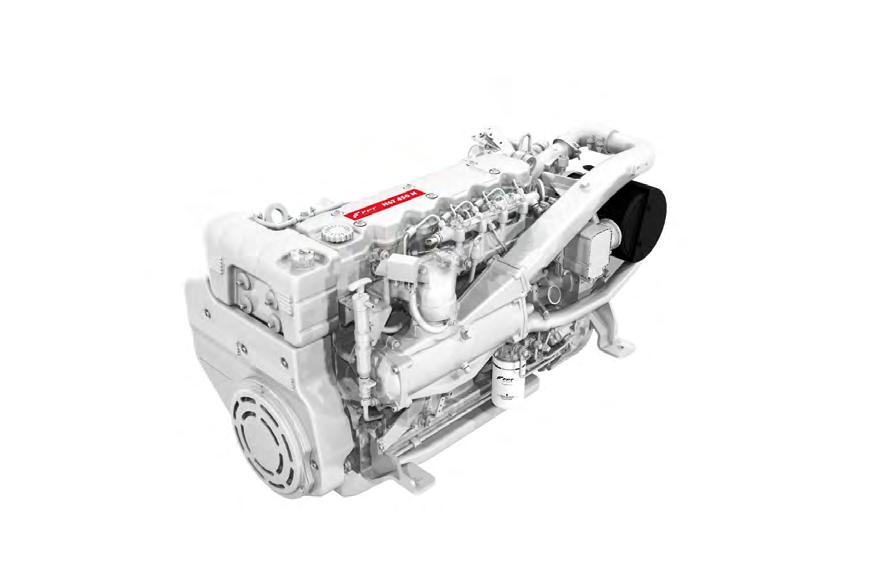
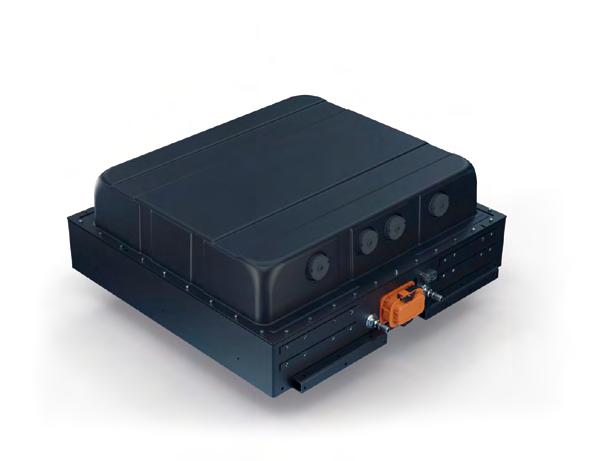
alEssandro Mor E carMinE BaGnoli raccontano coME lE nuovE ProPulsioni arrivano ancHE a Bordo dEllE unità da diPorto doPo un lunGo aFFinaMEnto a Bordo di BarcHE da lavoro
alessandro Mor and c arMine BaGnoli exPlain how new ProPulsion sY steMs Make their waY aBoard recreational Boats aFter extensiVe reFineMent on workBoats
Fpt Industrial fornisce sistemi propulsivi completi, elettrici e ibridi (elettrico più endotermico) che dopo un lungo periodo di prova, solitamente a bordo di unità professionali o da lavoro, arrivano a bordo anche delle imbarcazioni da diporto. alessandro mor, responsabile produzione marine, e Carmine Bagnoli, responsabile power generation e account marine di Fpt Industrial raccontano come i loro sistemi siano conosciuti per essere affidabili, potenti e compatti, tanto da estenderne il campo di applicazione alla pilotina dei piloti del porto, come a un taxi boat o a un maxi yacht.
Quali sono le principali sfide del trasportare a bordo batterie e sistemi elettrici?
“Dal punto di vista di prodotto, le grandi sfide riguardano l’integrazione a sistema, e cioè l’agevolare l’utilizzo di batterie all’interno di propulsioni ibride o full-electric. Fpt Industrial può fornire non solo la batteria, ma anche il sistema propulsivo completo, includendo motore endotermico e componentistica per la gestione della potenza. Dall’altra parte c’è tutto il fronte commerciale, per rispondere bene e velocemente alle richieste di questo tipo di soluzioni, in forte crescita negli ultimi anni, evidenziando tutti i vantaggi dell’elettrico in campo marino”. Con eBS 37 EVO siete riusciti a condensare lo spazio. Quali sono gli accorgimenti in termini di sicurezza, soprattutto a protezione delle batterie?
“Il pacco batteria eBs 37 eVO nasce per le applicazioni on-road e il prodotto è stato validato dai tanti clienti lungo le strade di tutto il mondo. era arrivato quindi il momento di valutarne l’idoneità ad altre applicazioni, con un approccio che portiamo avanti per tutti i nostri prodotti, Ice o elettrici che siano.
Così abbiamo deciso di introdurlo nelle applicazioni marine (il lancio è previsto per pra su imbarcazioni entro i 24 metri). La batteria soddisfa una serie di standard di sicurezza per i veicoli su gomma, in particolare gli eCe r100.3 e eCe r10.6. La sicurezza è poi garantita dall’eBm 5, il nostro sistema di gestione della batteria brevettato che ha ottenuto la certificazione IsO 26262 e che permette di ottimizzare i cicli di carica e scarica monitorando i parametri di funzionamento, tra cui la temperatura. Garantisce inoltre la massimizzazione della durata delle batterie in funzione delle specifiche esigenze di utilizzo. In campo marino, la prima applicazione è stata portata avanti in collaborazione con il nostro distributore autorizzato as Labruna, che ha inserito l’eBs 37 evo all’interno del generatore ibrido HeVOlution 80-37 della nuova gamma di prodotti HeVOlution”. Avete descritto eBS 37 EVO come un prodotto “progettato per la circolarità”, secondo la “regola delle 4R”.
“sì, la regola delle 4r è uno dei pilastri del nostro Customer service così come una filosofia che accompagna lo sviluppo della nostra lineup. Le quattro “r” sono quelle che riassumono i processi e le attività nel campo del riparare, dal monitoraggio remoto del prodotto alle attività sul campo, del rinnovare, internamente e con un’area dedicata, riutilizzare, attraverso partnership dedicate per il riutilizzo di seconda vita, e riciclare”.
Quali sono i vostri punti di forza?
“I prodotti per imbarcazioni da diporto sono riconosciuti come performanti e allo stesso tempo molto affidabili, proprio perché risultato di approfondite fasi di test. In particolare, tra le specifiche più apprezzate dal mercato ci sono la densità della potenza e la compattezza. I nostri
FPT Industrial provides complete propulsion systems - electric and hybrid (electric plus internal combustion) - which are typically tested over a long period on professional or commercial vessels before being installed on leisure boats. Alessandro Mor, Head of Marine Production, and Carmine Bagnoli, Head of Power Generation and Marine Accounts at FPT Industrial, explain how their systems are known for being reliable, powerful, and compact - making them suitable for a wide range of applications, from port pilot boats to taxi boats and maxi yachts.
What are the main challenges of bringing batteries and electric systems on board?
“From a product point of view, the major challenges lie in system integration - specifically, facilitating the use of batteries within hybrid or fully electric propulsion systems. FPT Industrial can provide not just the battery, but the complete propulsion system, including the internal combustion engine and all the components needed for power management. On the commercial side, the challenge is responding effectively and quickly to the growing demand for these types of solutions in recent years, while clearly communicating all the advantages of electric propulsion in the marine sector”.
With the eBS 37 EVO, you’ve managed to reduce space requirements. What safety measures have you implemented, especially for battery protection?
“The eBS 37 EVO battery pack was originally developed for on-road applications and has been validated by many customers around the world. It was therefore time to assess its suitability for other sectors, which is the same approach we take with all our products, whether ICE or electric. That’s why we decided
to introduce it into marine applications (its launch is planned for boats up to 24 meters). The battery meets a series of safety standards for road vehicles, particularly ECE R100.3 and ECE R10.6. Safety is further ensured by the eBM 5, our patented battery management system, which is ISO 26262 certified. It optimizes charging and discharging cycles by monitoring operating parameters such as temperature. It also maximizes battery lifespan based on specific usage needs. In the marine sector, the first application was carried out in collaboration with our authorized distributor AS labruna, who integrated the eBS 37 EVO into the HEVOlution 80-37 hybrid generator, part of the new HEVOlution product line”. You’ve described the eBS 37 EVO as a product ‘designed for circularity’ following the ‘4R rule.’ What does that mean?
“yes, the 4R rule is one of the pillars of our Customer Service and a guiding philosophy behind the development of our product line. The four R’s summarize our processes and activities: Repair: from remote product monitoring to field service operations; Refurbish: with dedicated internal areas for component renewal; Reuse: through partnerships aimed at second-life applications; and Recycle”.
What are your main strengths?
Our products for recreational boats are recognized as both high-performing and highly reliable, precisely because they result from thorough and extensive testing phases. In particular, the market especially values their power density and compactness. Our engines are also ‘connected,’ offering real-time monitoring through the MyFPT app, and enabling users to quickly reach the nearest service point for maintenance and technical support - significantly reducing downtime. Another key strength is our global

motori inoltre sono “connessi”, con la possibilità di monitoraggio realtime dall’app myFpt e di contattare il service point più vicino per i servizi di manutenzione e supporto tecnico con rapidità, riducendo al massimo i tempi di fermo. un altro punto di forza è il nostro network di service, presente in tutto il mondo e con una forte specificità sulle applicazioni marine”.
Qual è l’iter di “affinamento” di un prodotto prima di venire utilizzato in mare?
“I motori marini, dopo la fase di progettazione, vengono testati prima a banco e in seguito su applicazione reale, selezionando ad hoc delle operazioni gravose che mettono a dura prova il motore, come stress test, evidenziandone l’affidabilità. per esempio, l’N67 è stato validato sulle imbarcazioni dei piloti del porto di Genova, che, oltre a prevedere molte ore di utilizzo, sfruttano la coppia e la velocità del motore per compiere la loro missione quotidiana di trasportare i piloti a bordo delle navi in ingresso. Il Cursor 16 è stato testato su imbarcazioni dei Corpi dello stato destinate al pattugliamento delle acque territoriali nazionali. Questa fase permette un continuo monitoraggio del motore e un dialogo continuo tra utilizzatore e i nostri team per identificare aree di potenziamento e ulteriori sviluppi del prodotto, per arrivare alla versione di serie da lanciare sul mercato”.
Come amplierete la vostra offerta in campo marine? “siamo un’azienda di powertrain, per cui possiamo contare su uno sviluppo completo del motore, dal
base engine alla versione marina. un vantaggio competitivo è fare sinergie con i programmi di altri segmenti, permettendo di semplificare e velocizzare le fasi di sviluppo massimizzandone la resa. Negli ultimi anni abbiamo allargato la nostra line-up nel segmento marino, presentando diverse novità. per citarne alcune, abbiamo sviluppato e lanciato sul mercato l’N67, il Cursor 9 e il Cursor 16, motori marini per utilizzo ausiliario, che coprono potenze da 125 kW a 400 kW. Nel 2024 abbiamo presentato la configurazione heavy-duty dell’N67, con una potenza di 290 hp/215 kW. tra questi motori menzionati, sicuramente il Cursor 16 1000, la versione più potente della gamma marina di Fpt Industrial, è ideale per barche dislocanti e uso charter, che richiede un utilizzo annuo intenso. può essere inoltre fornito in configurazione ibrida, potenziato così da un motore elettrico da 200 o 400 kW. La versione ibrida può fornire un comfort notevole, permettendo di navigare in modalità silenziosa, oltre che dare la possibilità di accedere in aree marine protette o fungere da vero e proprio generatore di bordo, per un fast charging delle batterie. Questo è un elemento molto utile per superyacht che vogliono aumentare il più possibile il proprio stanziamento all’ancora riducendo la dimensione e il peso del pacco batterie a bordo. In questo momento stiamo continuando a valutare nuove versioni dei motori della nostra gamma, per soddisfare sempre meglio le esigenze dei clienti, così come proposte ibride ed elettriche, sempre più richieste”.
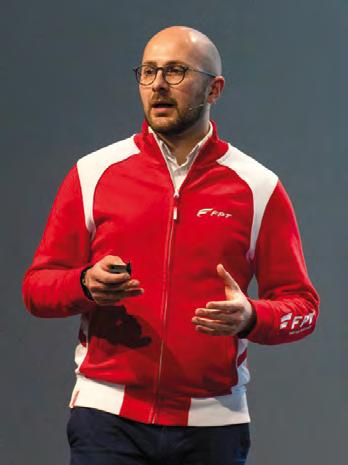
Service network, which has strong expertise in marine applications and ensures dependable support wherever our customers are”. What is the “refinement” process for a product before it’s used at sea?
“After the design phase, marine engines go through bench testing followed by real-world application testing. We select particularly demanding operations that push the engine to its limits - stress tests that demonstrate reliability. For example, the N67 was validated on the pilot boats of the Port of Genoa, which not only run for many hours but also rely on engine torque and speed to carry out daily missions of transferring pilots to incoming ships. The Cursor 16 was tested on government vessels used for patrolling national waters. This phase allows for continuous engine monitoring and close collaboration between the user and our teams to identify areas for improvement
and further product development, eventually leading to the final production version for market release”. How do you plan to expand your marine offering?
“We’re a powertrain company, which means we handle full engine development - from the base engine to the final marine configuration. One of our competitive advantages is the synergy with other market segments, which helps streamline development phases and maximize performance. In recent years, we’ve expanded our marine lineup with several new models. For example, we’ve developed and launched the N67, Cursor 9, and Cursor 16 for auxiliary marine use, covering power ranges from 125 kW to 400 kW. In 2024, we introduced the heavy-duty version of the N67, delivering 290 hp / 215 kW. Among these, the Cursor 16 1000 - the most powerful marine engine in FPT Industrial’s range - is particularly well-suited for displacement hulls and charter boats that require high annual usage. It’s also available in a hybrid configuration, boosted by an electric motor of 200 or 400 kW. This hybrid version offers great comfort, enabling silent navigation, access to marine protected areas, and serving as an onboard generator for fast battery charging. This is especially valuable for superyachts that want to maximize anchorage time while minimizing the size and weight of the battery pack on board. Right now, we’re continuing to evaluate new versions of our engines to better meet customer needs, as well as hybrid and fully electric options - which are seeing increasing demand”.



PEr il tEaM lEadEr HyBrid and ElEctric solutions di vulkan la ricHiEsta di ProPulsionE iBrida nEl sEttorE diPorto è in auMEnto. in arrivo una GaMMa di soluzioni dEdicatE cHiavi in Mano
accordinG to Vulkan italia’s hYBrid and electric solutions teaM leader, deMand For hYBrid ProPulsion in the YachtinG sector is on the rise. a new ranGe oF dedicated turnkeY solutions is on the waY
Con sei stabilimenti di produzione, 50 società di vendita e circa 1.600 dipendenti in più di 18 sedi in tutto il mondo, il Gruppo Vulkan è uno dei leader tecnologici e di mercato nel campo della tecnologia marina, industriale ed energetica. Dal 2021 Vulkan è entrato nel mercato dell’ingegnerizzazione e della fornitura di sistemi di propulsione ibridi ed elettrici anche se, come racconta matteo Zangrandi – team leader Hybrid and electric solutions di Vulkan Italia a super YaCHt 24 “L’azienda si occupa di ibrido già da una decina d’anni: a partire dal 2015 supportava gli integratori di sistemi nella fornitura di un pacchetto propulsivo ibrido attraverso la progettazione meccanica della trasmissione che, specialmente nel mondo marino, si apre a tante configurazioni diverse”.
Quali tendenze vede al momento?
“parlando di taglie dai 20 ai 50/60 metri vedo una crescita importante della richiesta di soluzioni ibride parallele, ovvero con la macchina elettrica inserita sulla linea d’asse per contribuire alla propulsione assieme al motore endotermico. Nella gamma oltre i 70 metri la maggior parte degli yacht sono dotati di propulsori azimutali e quindi sono già imbarcazioni diesel-elettriche in stile nave da crociera”. Avete novità in arrivo?
“senza trascurare il settore superyacht e commerciale nel quale siamo specializzati, stiamo sviluppando una gamma modulare di prodotti compatti e leggeri. si tratta di moduli ibridi da installare sul volano di un ampio spettro di motori endotermici che possono rendere ibrida un’imbarcazione nuova o in retrofit. È un sistema ‘chiavi in mano’ compatto e pensato per ridurre il più possibile i pesi, anche se un impianto ibrido comporta sempre dei pesi aggiuntivi rispetto a uno diesel tradizionale. Il modulo è completato con la parte di distribuzione elettrica, conversione e stoc-
caggio dell’energia tramite batterie e sistemi di controllo”. Come procede l’evoluzione delle batterie?
“Le batterie rappresentano spesso il 50% del peso aggiuntivo, se non di più, del sistema ibrido e si avvicinano al 50% del suo valore economico. Lo yachting prende tanto dall’automotive, perché non fa abbastanza volumi per consentire dei propri sviluppi tecnologici.
D’altro canto il business è cresciuto e oggi trovare batterie per fare stoccaggio in alta tensione non è un problema, esistono tecnologie consolidate, come le batterie Lfp e Nmc. Nonostante ciò, sono l’anello debole, manca ancora una tecnologia di stoccaggio che consenta di avere densità di potenza ed energia sensate per riuscire a sostituire i combustibili fossili. esistono nuove tecnologie interessanti, come le batterie allo stato solido e supercapacitor, ma sono in fase di certificazione e non sono state ancora testate a bordo”.
Esiste un tema di sicurezza legato alle batterie e agli incendi? “s ì, ma le batterie al litio sono molto sicure, specialmente quelle approvate per il settore marino; devono passare test a livello di sicurezza antincendio molto più stringenti di quelle automotive. anche gli installatori seguono delle buone pratiche che consentono una sicurezza estrema. per il progetto del retrofit del primo vaporetto di actv a Venezia abbiamo sviluppato un modulo LFp ad hoc e conseguito la certificazione di tipo con il rina, in seguito abbiamo testato alcuni campioni in laboratorio al fine di indurre il thermal runaway, la condizione di perdita di controllo termico della batteria, per testare il sistema antincendio ad allagamento. I moduli sono installati in cassoni stagni e resistenti al fuoco per 60 minuti che possono essere allagati con acqua di mare. Oltre alle fiamme, il problema delle batterie al litio è l’enorme calore generato dal thermal
With six production plants, 50 sales companies, and around 1,600 employees across more than 18 locations worldwide, the Vulkan Group is one of the technological and market leaders in marine, industrial, and energy technology. Since 2021, Vulkan has entered the hybrid and electric propulsion engineering and supply market, although, as Matteo Zangrandi - team leader of Hybrid and Electric Solutions at Vulkan Italia - told SuPER yACHT 24, “The company has been involved in hybrid systems for about ten years now. As early as 2015, it was supporting system integrators by providing hybrid propulsion packages through the mechanical design of the drivetrain, which, especially in the marine world, allows for many different configurations”. What trends are you seeing at the moment?
“When it comes to yachts in the 20 to 50/60 metre range, I see a significant increase in demand for parallel hybrid solutions, where the electric motor is integrated into the propeller shaft line to assist the internal combustion engine in propulsion. In the over-70-metre range, most yachts are equipped with azimuth thrusters and are therefore already diesel-electric vessels, similar to cruise ships”. Do you have any new developments in the pipeline?
“While continuing to focus on the superyacht and commercial sectors where we specialise, we’re developing a modular range of compact and lightweight products. These are hybrid modules designed to be installed on the flywheel of a wide range of internal combustion engines, making it possible to hybridise both new boats and retrofit existing ones. It’s a turnkey system, compact and designed to minimise weight as much as possible - even though a hybrid system always adds some weight compared to a traditional diesel setup. The module includes the entire electrical distribution, energy conversion, and
storage components, with batteries and control systems”.
How is battery technology evolving?
“Batteries often account for 50% of the additional weight - if not more - of a hybrid system, and nearly 50% of its total cost. yachting borrows heavily from the automotive sector because it doesn’t have the production volumes to justify its own dedicated technological development. That said, the market has grown, and today it’s no longer a problem to source high-voltage storage batteries - established technologies like lFP and NMC batteries are readily available. Still, they remain the weak link: we’re still lacking an energy storage technology with the power and energy density needed to realistically replace fossil fuels. There are promising new technologies, such as solid-state batteries and supercapacitors, but these are still in the certification phase and haven’t yet been tested on board”.
Is there a safety concern related to batteries and fires?
“yes, but lithium batteries are very safe, especially those certified for marine use - they must pass much stricter fire safety tests than automotive batteries. Installers also follow best practices that ensure a very high level of safety. For the retrofit project of the first Actv vaporetto in Venice, we developed a custom lFP module and obtained type approval from RINA. We then tested some samples in the lab to deliberately trigger thermal runaway - the condition where the battery loses thermal control - in order to test the flooding-based fire suppression system. The modules are housed in watertight, fire-resistant containers capable of withstanding flames for 60 minutes, and they can be flooded with seawater. In addition to the flames, the main issue with lithium batteries is the enormous heat generated during thermal runaway. Flooding is an effective way to dissipate that heat - it’s a system already in use
runaway, un modo efficace per dissiparlo è l’allagamento. un sistema già usato a bordo degli yacht e che si sta dimostrando estremamente sicuro”.
Quali sono gli ostacoli a una diffusione maggiore dell’ibrido? “a seconda del tipo applicazione esistono più soluzioni alternative al motore endotermico da studiare caso per caso, questo rende difficile un’economia di scala con conseguente aumento dei costi rispetto a un tradizionale sistema propulsivo. L’ibrido nello yachting deve ancora trovare un suo significato profondo; in altre applicazioni come il commerciale e il trasporto passeggeri, ambiti dove c’è un’attenzione maggiore alle emissioni, si riescono a trovare fondi e finanziamenti pubblici per installare sistemi ibridi. Nello yachting è invece tutto demandato alla passione dell’armatore e alla sua volontà di avere un sistema più tecnologico e sostenibile rispetto a quello tradizionale. Inoltre, per barche veloci che devono navigare oltre i 25 nodi, la soluzione ibrida non è ancora all’altezza delle prestazioni”.
Cosa pensa delle altre tecnologie come idrogeno e metanolo?
“a seconda del tipo di barca e di applicazione esistono tecnologie diverse e l’abilità è capire quali sono veramente efficaci e quando. Il problema è come gestire a bordo il vettore energetico. Ci si sta lavorando ed esistono diverse soluzioni, ma per sostituire il combustibile fossile si dovrà trovare il giusto mix di vettori, che devono essere disponibili nei porti e a prezzi sensati”.
Cosa cerca chi chiede l’ibrido?
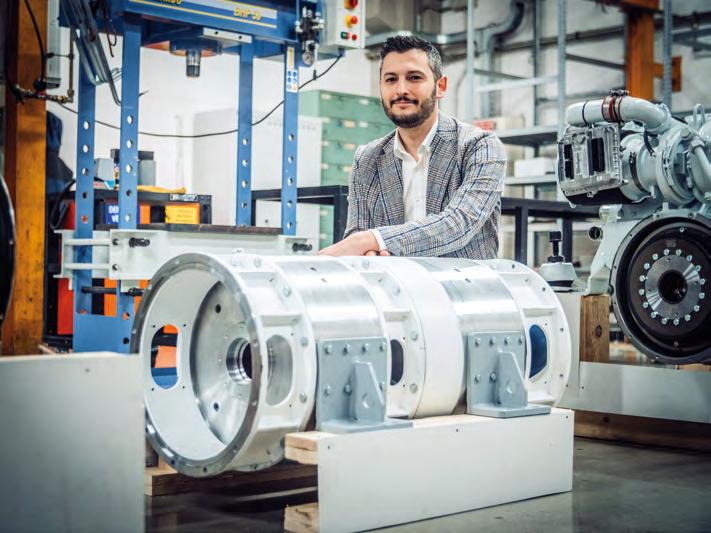
“Oltre all’appeal di uno yacht dotato di un sistema propulsivo innovativo, avere una buona base di stoccaggio di energia a bordo consente di alimentare i servizi hotel senza utilizzare generatori per lunghi periodi e di navigare in full electric, un’esperienza piacevole per chi è abituato, anche ai bassi regimi, a sentire la vibrazione dei motori endotermici. Infine tutta l’imbarcazione è più ottimizzata intorno al sistema propulsivo”.
on yachts and has proven to be extremely safe”.
What are the barriers to wider adoption of hybrid systems?
“Depending on the application, there are various alternatives to internal combustion engines, each requiring a case-by-case studythis makes achieving economies of scale difficult and drives up costs compared to traditional propulsion systems. Hybrid technology still
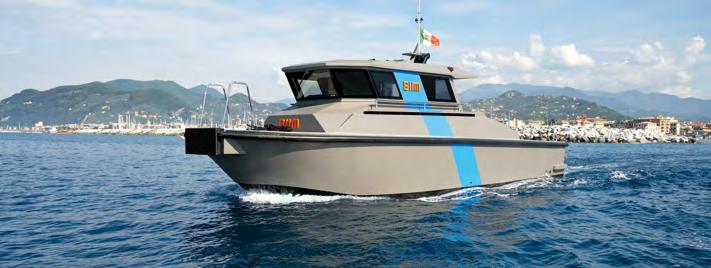
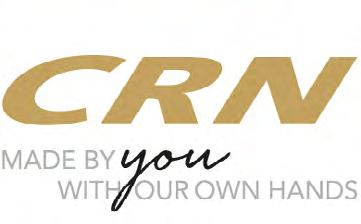
Fondato ad Ancona nel 1963, CRn è il cantiere navale italiano specializzato nella progettazione, ingegnerizzazione e costruzione di superyacht full custom in acciaio e alluminio e totalmente in alluminio fino a 95 metri. le competenze progettuali e costruttive, affiancate alla capacità di recepire e dare forma a ogni visione e richiesta dell’armatore, costituiscono il valore distintivo di CRn: la cultura del bespoke. Forte di una lunga tradizione, CRn si distingue per il know-how, l’architettura navale, l’eccellenza artigianale e la meticolosa precisione. pioniere e trendsetter nel settore nautico internazionale, il cantiere è noto per i suoi iconici superyacht completamente custom, simbolo di innovazione all’avanguardia e unicità. l’approccio e il dnA di CRn si riflettono anche nella sede direzionale, engineering, produttiva e hospitality del cantiere navale. uno spazio che integra la grammatica della forma, dal punto di vista del design, della funzionalità e della sostenibilità. non solo un progetto dedicato all’accoglienza dei clienti ed ai dipendenti, bensì un’esperienza immersiva, dove armatori e ospiti vivono in prima persona ogni fase del processo creativo e costruttivo dello yacht.
Gli spazi richiamano un megayacht CRn, con elementi che esaltano l’eleganza e la raffinatezza italiana, il comfort, i materiali nobili e l’approccio totalmente sartoriale. l’architettura all’avanguardia di questo progetto valorizza il contesto circostante, dando il suo significativo contributo alla riqualificazione dell’ingresso alla città di Ancona, cuore del distretto yachting della regione marche.
needs to find its deeper purpose in yachting. In sectors like commercial shipping and passenger transport, where there’s more focus on emissions, it’s easier to secure public funding and grants for hybrid systems. In yachting, it all depends on the owner’s passion and willingness to invest in a more advanced and sustainable system than the conventional one. Also, for fast boats that need to cruise at over 25 knots, hybrid solutions are not yet capable of delivering comparable performance”.
What’s your take on other technologies like hydrogen and methanol?
“Depending on the type of boat and its intended use, different technologies may be appropriate - the key is understanding which ones are truly effective, and when. The main challenge is how to manage the energy carrier on board. Work is underway and several solutions exist, but in order to replace fossil fuels, we’ll need to find the right mix of energy carriers, which also need to be available in ports at reasonable prices”.
What are hybrid system clients looking for?
“Beyond the appeal of owning a yacht equipped with an innovative propulsion system, having a solid energy storage setup on board allows you to power hotel services without running generators for long periods and to cruise in full-electric mode - a pleasant experience for those who are used to feeling the vibrations of combustion engines even at low speeds. ultimately, the entire yacht is more optimised around the propulsion system”.
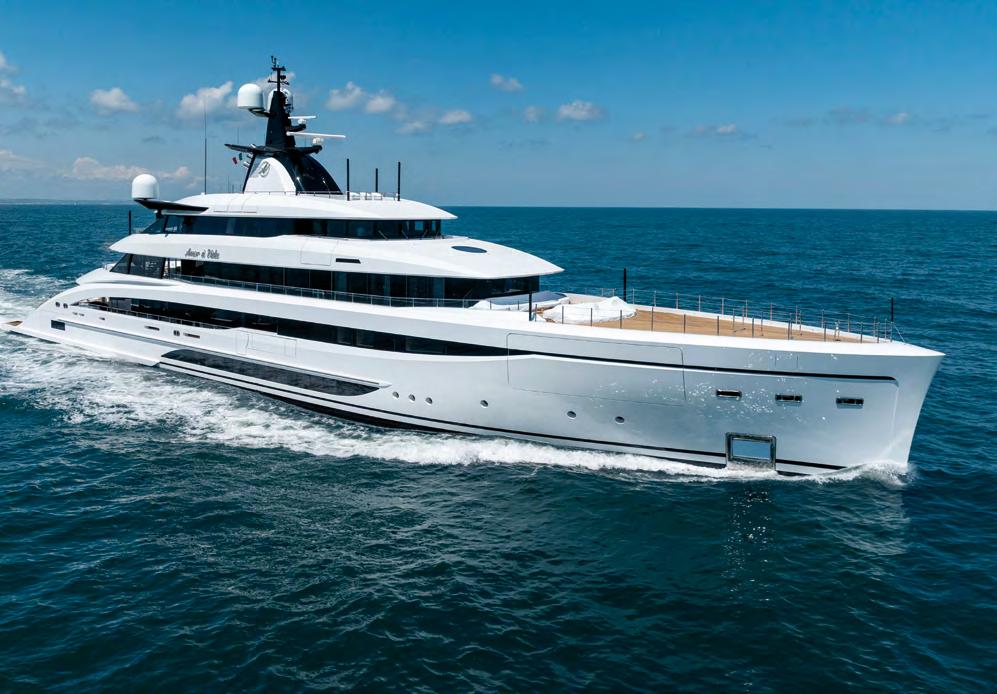
alBErto Mariotti
“i suPP ort electric, But it takes tiMe”
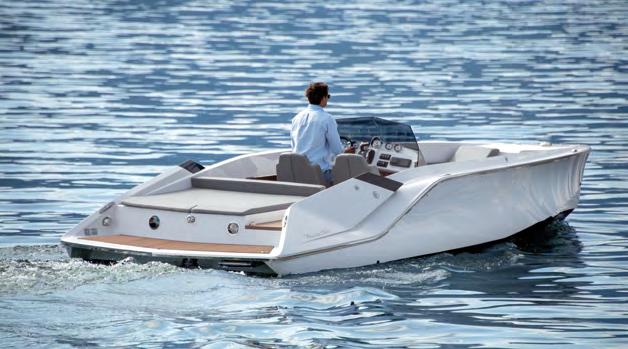
PEr Mauro FEltrinElli, distriButorE italiano dEl cantiErE austriaco FrauscHEr, la ProPulsionE ElEttrica in italia è FrEnata dalla Mancanza di inFrastrutturE
For Mauro Feltrinelli, italian distriButor oF the austrian shiPYard Frauscher, the de VeloPMent oF electric ProPulsion in italY is BeinG held Back BY the lack oF inFrastructure
Importato in Italia da Cantiere Nautico Feltrinelli con base a Gargnano, sul lago di Garda, Frauscher è considerato tra i pionieri della propulsione elettrica e i suoi modelli trovano spesso posto nei garage dei superyacht come luxury tender. Inoltre, il cantiere austriaco ha di recente siglato una collaborazione con porsche per lo sviluppo di modelli elettrici ad alte prestazioni. super YaCHt 24 ha intervistato mauro Feltrinelli, uno dei principali dealer del cantiere che racconta come “al recente salone Nautico di Venezia abbiamo presentato il nuovo 747 mirage air che inaugura la collaborazione tecnica con l’azienda norvegese evoy, che ha fornito il motore elettrico accoppiabile finalmente a un piede poppiero”. Su quali modelli Evoy fornirà i motori elettrici?
“Il cantiere ha quattro partnership tecniche per la propulsione elettrica: porsche per quanto riguarda i modelli top di gamma, evoy/Kreisel per quelli high performance, molabo per le medie potenze e Kräutler per le basse”.
Quanto vale il mercato elettrico per Frauscher?
“rappresenta attualmente il 35% dei numeri, su 85 unità prodotte all’anno circa il 35-40% sono elettriche”.
E in Italia?
“al momento non c’è un vero mercato, anche perché non abbiamo infrastrutture né sul lago di Garda
né altrove. Faccio un esempio: Frauscher ha partecipato alla Biennale di Venezia dove porsche era main sponsor di Norman Foster Foundation team. È andato tutto bene ma è stata un’esperienza complicata da gestire perché avevamo a disposizione un solo fast charger fornito da aqua superpower, delle due prese disponibili ne funzionava una sola e i 75 kW di potenza promessi arrivavano a singhiozzo. abbiamo dovuto gestire le autonomie con molta attenzione”. Ma quindi non siamo pronti per l’elettrico?
“In realtà sì, il prodotto c’è ma siamo lontanissimi dalla potenzialità di poterlo utilizzare. riguardo alle infrastrutture, il primo progetto sul Garda è quello di Nautica Casarola con una colonnina che però ancora non è stata collegata per problemi di permessi da parte del comune. anche noi ne abbiamo una in arrivo, ma serve tempo perché dal fornitore non ci viene garantita la quantità di energia sufficiente. Non è semplice, la propulsione elettrica è molto interessante, sta facendo grandi passi e lo si vede anche dagli investimenti fatti da porsche, uno dei principali player del mercato delle auto sportive, che ha trovato in Frauscher un partner solido per inaugurare il suo ingresso nella nautica e fare ricerca sulla motricità elettrica anche in acqua. I numeri sono ancora piccoli, non sono un detrattore, sono un grande sostenitore della propul-
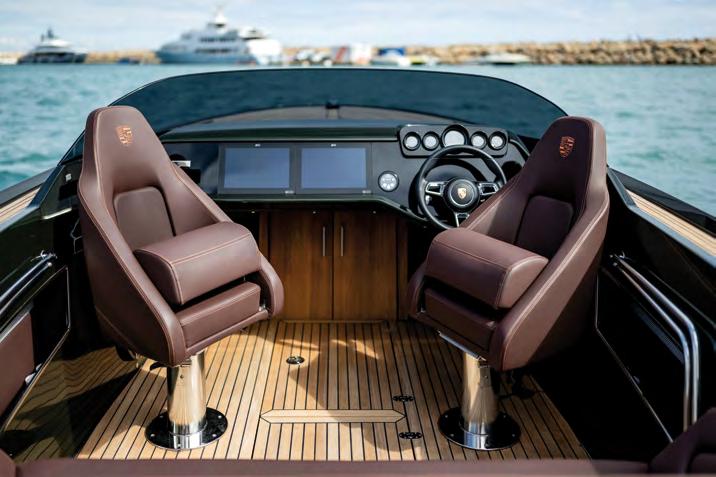
Imported into Italy by Cantiere Nautico Feltrinelli, based in Gargnano on lake Garda, Frauscher is considered a pioneer in electric propulsion, and its models are often found in superyacht garages as luxury tenders. The Austrian shipyard has also recently signed a partnership with Porsche to develop high-performance electric models. SuPER yACHT 24 interviewed Mauro Feltrinelli, one of the shipyard’s key dealers, who explained: “At the recent Venice Boat Show we presented the new 747 Mirage Air, which marks the beginning of a technical collaboration with the Norwegian company Evoy, which supplied the electric motor that can finally be paired with a sterndrive”.
Which models will be equipped with Evoy electric motors?
“The shipyard has four technical partners for electric propulsion: Porsche for top-of-the-line models, Evoy/Kreisel for high-performance ones, Molabo for mid-range power, and Kräutler for low-power systems”.
How much does the electric segment represent for Frauscher?
“It represents 35% of our production. Out of about 85 units built per year, roughly 35–40% are electric.”
And in Italy?
“At the moment there isn’t a real market here, mainly because we don’t have the necessary infrastructure - not on lake Garda or anywhere else. let me give you an example: Frauscher took part in the Venice Biennale, where Porsche was the main sponsor of the Norman Foster Foundation Team. Everything went well, but it was a complicated experience to manage because we only had access to a single fast charger provided by Aqua superPower. Of the two available plugs, only one worked, and the promised 75 kW of power came through intermittently. We had to manage the range very carefully”. So, are we not ready for electric propulsion?
“Actually, we are. The product exists, but we’re still very far from
being able to fully utilize it. As for infrastructure, the first project on lake Garda is by Nautica Casarola, which has installed a charging station, but it still hasn’t been connected due to permit issues with the municipality. We also have one on the way, but it takes time, as the supplier cannot guarantee us the necessary amount of energy. It’s not simple. Electric propulsion is very interesting and making great strides-you can see that in the investments made by Porsche, one of the leading players in the sports car market. They’ve partnered with Frauscher to mark their entry into the boating world and to conduct research on electric propulsion in water as well. The numbers are still small. I’m not a detractor; in fact, I’m a strong supporter of electric propulsion, but we need to be realistic-more time is needed. It’s not just the lack of infrastructure that makes electric boating difficult, but also the limited range (of course) and the weight of the batteries, which plays a crucial role in performance and consumption on water”.
How many boats are involved in the collaboration with Porsche?
“It’s based on an order of 25 Frauscher 850s, which we’re developing in two versions: the Fantom and the Fantom Air. The hull is the same in both cases, but the deck layout differs-enclosed in the first, open in the second. The powertrain is by Porsche, while the transmission is by Mercruiser, using the Bravo III XR drive. This system handles the high torque of the Porsche powertrain well, though it’s redundant in terms of the reversing gear, which isn’t really needed: the electric motor reverses direction by inverting the electric field. I hope that in the future we’ll have access to a direct-drive transmission without a reversing unit, because at this point all the reduction and reversing is handled by the motor’s electronics”.
Let’s talk about Frauscher and luxury tenders
“The tender segment is currently one of the best use cases for high-performance electric pro-
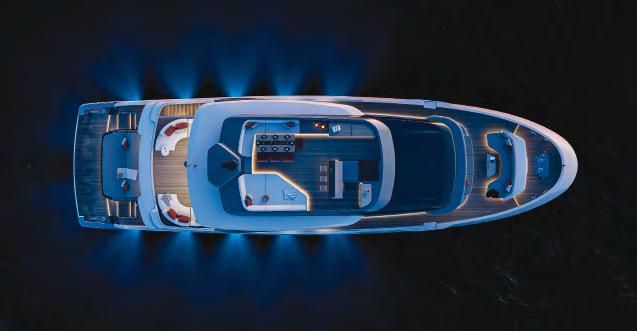
sione elettrica, però serve essere realisti, c’è ancora bisogno di tempo. Non solo la carenza di infrastrutture rende difficile il successo della nautica elettrica, ma anche la ridotta autonomia (ovviamente) e il peso degli accumulatori che in acqua gioca un ruolo determinante sulle prestazioni e i consumi”.
La collaborazione con Porsche quante barche prevede?
“È basata su un ordine di 25 Frauscher 850, che stiamo declinando nelle versioni Fantom e Fantom air, la carena è la medesima, cambia il ponte di coperta: chiuso nel primo caso, aperto nel secondo. Il powertrain è porsche mentre la trasmissione è mercruiser con il piede Bravo III Xr, un prodotto capace di assorbire bene la grande coppia del propulsore porsche ma ridondante per il gruppo invertitore del quale non ci sarebbe bisogno: il motore elettrico inverte la rotazione invertendo il campo elettrico. auspico che in futuro potremo disporre di una trasmissione diretta senza invertitore perché ormai tutta la riduzione e l’inversione si fa con l’elettronica del motore.
Parliamo di Frauscher e luxury tender
“Quello del tender è uno degli utilizzi migliori al momento per l’elettrico ad alte prestazioni: generatori generosi, assenza di serbatoi per il carburante extra per il tender, tragitti brevi e spesso in rade affollate, dove il rombo dei motori termici verrebbe criticato rendono la propulsione elettrica molto desiderabile! È sempre una bella emozione quando riusciamo a mettere un tender su un superyacht. ricordo con piacere la consegna a La spezia di un Frauscher 1017 Gt air su un sanlorenzo sL62 steel. Frauscher
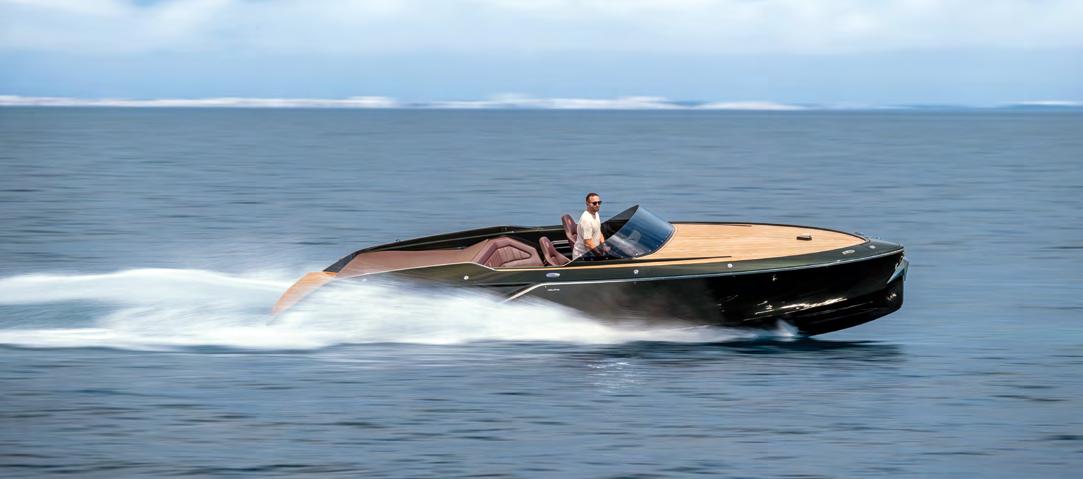
è sempre stata presente nel mercato dei tender di lusso e delle chase boat, ma per filosofia aziendale non è mai voluta entrare nel segmento custom puro, rappresenta un tipo di lavorazione che non compete un’azienda che aspira all’industrializzazione. Incontriamo quel tipo di clientela che accetta un prodotto così com’è salvo piccoli adattamenti”.
Altri tender a bordo di yacht importanti?
“ricordo che avevamo fornito uno dei primi Frauscher 686 Lido al Vsy roma, realizzato appositamente per lo yacht con i bumpers al posto del bottaccio in acciaio inossidabile. ricordo ronin, con due 747 mirage, uno con ponte chiuso e l’altro aperto. e di recente il cantiere rossinavi mi ha contattato per le misure del Frauscher 1017, l’armatore ha chiesto di realizzare il garage appositamente per la nostra barca. Quindi succede il contrario, sono i cantieri che realizzano gli yacht con le misure per poter ospitare un Frauscher e non viceversa”.
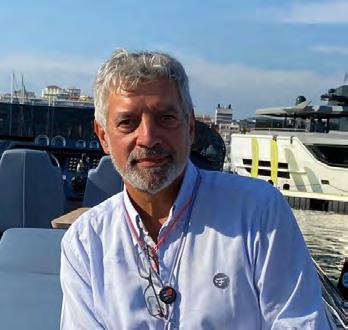
pulsion: generous generators, no need for extra fuel tanks for the tender, short trips often in crowded anchorages-where the roar of combustion engines would be frowned upon-make electric propulsion very desirable! It’s always an exciting moment when we manage to place a tender on a superyacht. I fondly remember the delivery of a Frauscher 1017 GT Air in la Spezia for a Sanlorenzo Sl62 Steel. Frauscher has always been present in the luxury tender and chase boat
market, but as a matter of company philosophy, it has never wanted to enter the pure custom segment. That kind of craftsmanship doesn’t suit a company aiming for industrialization. We cater to clients who are happy to accept the product as it is, with only minor customizations”. Any other tenders aboard important yachts?
“I remember we supplied one of the first Frauscher 686 lido models to the VSy Roma, specifically built for the yacht with bumpers instead of the usual stainless steel rubbing strake. I recall Ronin had two 747 Mirage tenders-one with a closed deck and the other open. And recently, the Rossinavi shipyard contacted me for the dimensions of the Frauscher 1017; the owner requested a garage designed specifically to fit our boat. So it’s the other way around now-the shipyards are building yachts with dimensions tailored to accommodate a Frauscher, not the other way around”.


PrEsEntato a vEnEzia il PriMo taxi a ProPulsionE ElEttrica. carEna in carBonio, MotorE da 200 kW E Pacco BattEriE da 180 kWH PEr costi di GEstionE inFEriori dEl 90% risPEtto a un ModEllo EndotErMico the First electric-Powered water taxi was unVeiled in Venice. FeaturinG a carBon hull, a 200 kw Motor, and a 180 kwh BatterY Pack, it Boasts oPeratinG costs 90% lower than those oF an internal coMBustion Model
al s alone Nautico di Venezia ha debuttato Lucietta, primo taxi boat full-electric progettato per il servizio pubblico lagunare. Frutto della collaborazione tra repower, Nauta Yachts e Cantiere m otonautico s erenella, nasce per coniugare tradizione veneziana e propulsione a zero emissioni, garantendo prestazioni e autonomia adeguate al lavoro quotidiano tra rii e canali. Vincolata dai limiti dimensionali imposti dalla città, Lucietta misura 9,30 metri di lunghezza, 2,30 metri di baglio e 2,10 metri di altezza. Il dislocamento è di 4.500 kg. La carena in carbonio e materiali compositi è stata disegnata per ridurre gli effetti del moto ondoso e massimizzare il rendimento alle andature regolamentari di Venezia, comprese tra 7 km/h nei rii e 20 km/h nei canali principali. L’uso del carbonio ha contenuto il peso e ottimizzato il rapporto tra potenza installata e autonomia.
La propulsione si basa su un sistema full-electric a 600 V, con una doppia elica controrotante e un motore da 200 kW (circa 270 CV). Il pacco batterie da 180 kWh è suddiviso in nove moduli da 20 kWh. L’autonomia varia sensibilmente in funzione della velocità e del carico: a 5 nodi Lucietta può navigare per 77 ore a vuoto e 60 ore a pieno carico; a 20 nodi, fuori regolamento ma utile per trasferimenti extra-lagunari, garantisce 20 ore a vuoto e 15 ore con passeggeri.
Il sistema di ricarica è compatibile con infrastrutture automotive standard, con prese di tipo 2 in aC e CC s 2 in DC. I tempi di ricarica dal 20% al 100% variano da 20,6 ore con 7 kW a 1,2 ore con colonnine rapide da 120 kW. Nella ricarica operativa più frequente, dal 20% all’80%, si passa da 15,4 ore a 50 minuti. Questa flessibilità consente di coprire un’intera giornata lavorativa senza necessità di rifornimenti intermedi.
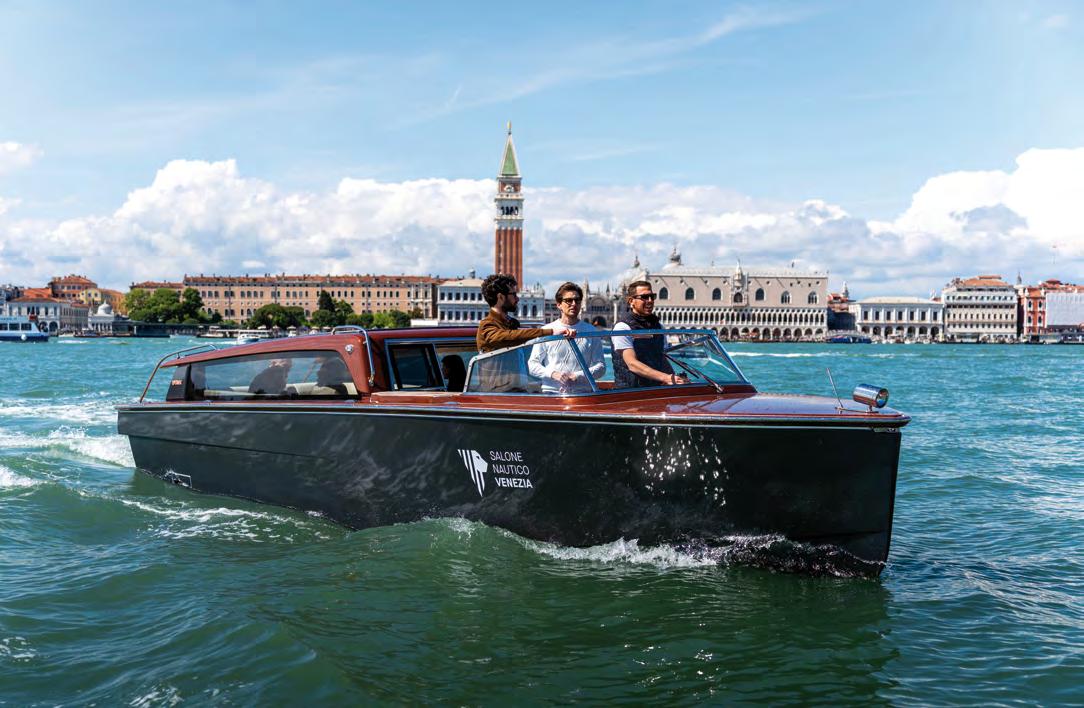
Lucietta è dotata di vani batterie impermeabilizzati, sistemi di autoraffreddamento attivi e una centralina d’emergenza che interrompe gli scambi energetici in caso di criticità. repower dichiara costi di esercizio e manutenzione inferiori del 90% rispetto a un taxi endotermico. accanto ai materiali compositi strutturali, il Cantiere s erenella ha mantenuto le tradizionali lavorazioni in legno tipiche dei taxi veneziani, inserendo pannellature ottenute dal riciclo degli scarti di vetro di m urano, grazie alla collaborazione con la startup rehub. per sviluppare una barca adatta alla Laguna, repower ha condotto un’indagine tra i tassisti locali, per raccogliere indicazioni su esigenze operative e aspettative. Lo studio dei taxi storici e i feedback degli operatori hanno guidato la progettazione affidata a Nauta Yachts, che ha reinterpretato il taxi veneziano con linee moderne e stilemi legati al mondo elettri -
unveiled at the Venice Boat Show, lucietta is the first fully electric taxi boat developed specifically for the city’s public lagoon transport. The result of a collaboration between Repower, Nauta yachts, and Cantiere Motonautico Serenella, it was created to blend Venetian tradition with zero-emission propulsion, delivering performance and range suitable for daily operations through Venice’s narrow canals and waterways. Constrained by the city’s dimensional limits, lucietta measures 9.30 meters in length, 2.30 meters in beam, and 2.10 meters in height, with a displacement of 4,500 kg. The carbon and composite hull was designed to minimize wake effects and maximize efficiency at Venice’s regulated speeds - 7 km/h in the narrow canals (rii) and 20 km/h in the main waterways. The use of carbon fiber helps keep the weight down while optimizing the powerto-range ratio. The propulsion system is a 600
V full-electric setup featuring a counter-rotating twin-propeller and a 200 kW motor (around 270 hp). The 180 kWh battery pack is divided into nine 20 kWh modules. Range varies significantly depending on speed and load: at 5 knots, lucietta can run for 77 hours empty and 60 hours fully loaded; at 20 knots - beyond Venice’s speed limits but useful for transfers outside the lagoon - it offers 20 hours of autonomy without passengers and 15 hours with a full load. The charging system is compatible with standard automotive infrastructure, featuring Type 2 AC and CCS2 DC connectors. Charging times from 20% to 100% range from 20.6 hours with a 7 kW charger to just 1.2 hours with 120 kW fast-charging stations. For the more common operational recharge - going from 20% to 80% - the times vary from 15.4 hours to just 50 minutes. This flexibility allows lucietta to cover a full workday without the need for intermediate charging stops. lucietta
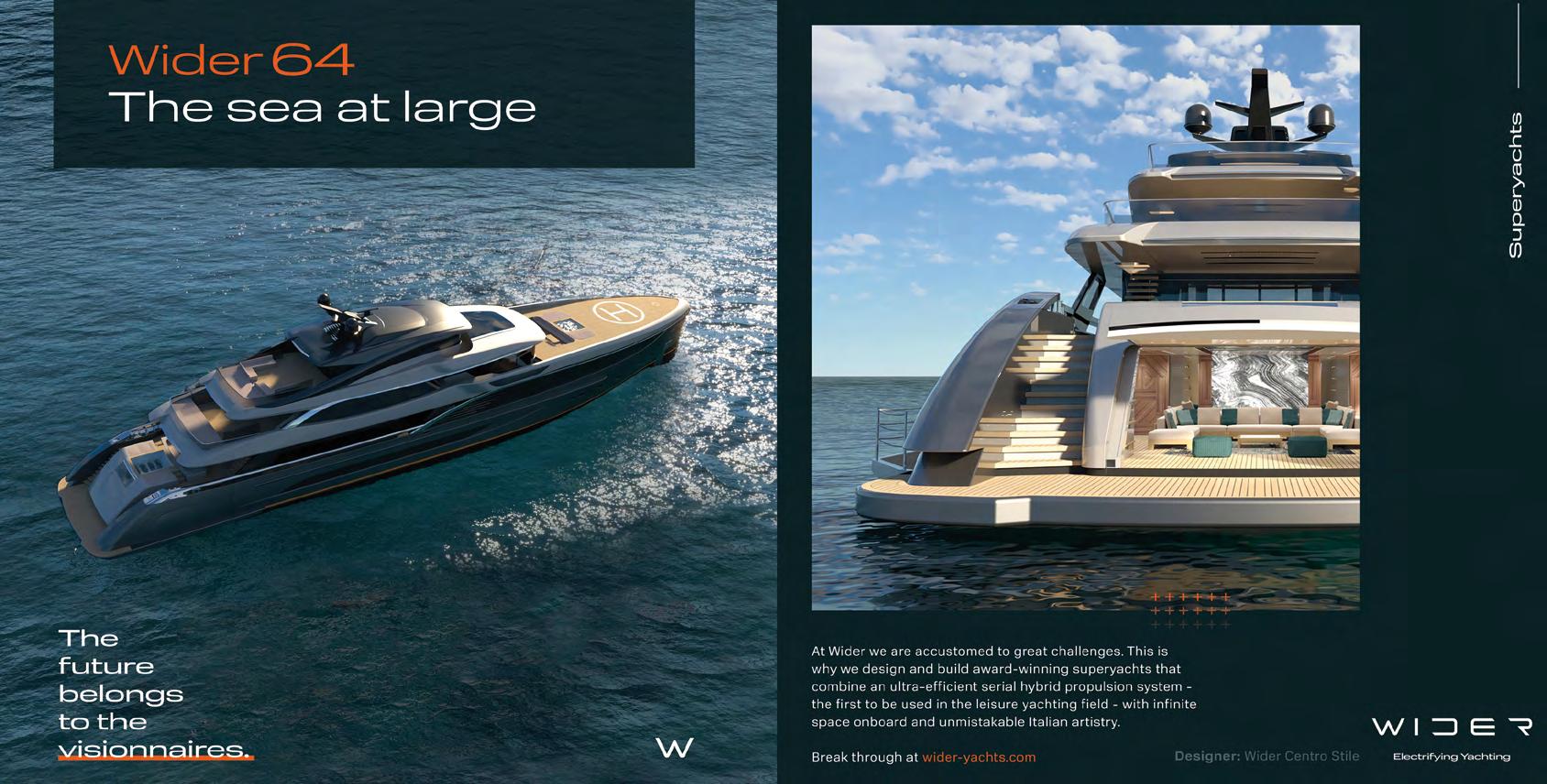
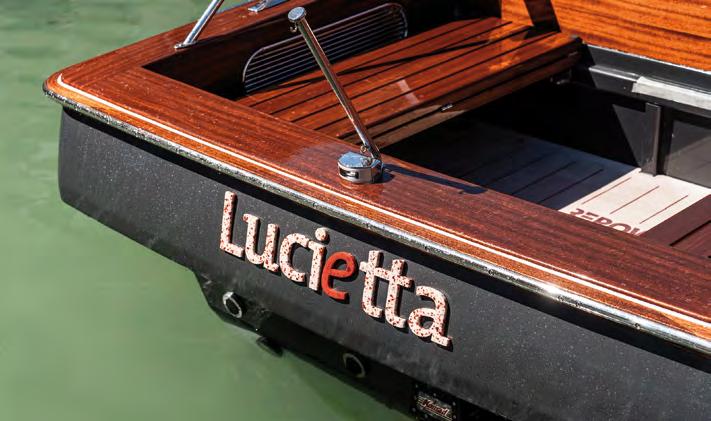
co. “La nautica elettrica rappresenta una parte della rivoluzione che ormai da anni è in atto nel settore della mobilità – dice Fabio Bocchiola, amministratore delegato di repower Italia – e una componente chiave dell’ecosistema di mobilità sostenibile che repower ha sviluppato nei 15 anni di esperienza nel settore. Il passaggio alla tecnologia elettrica va avanti a velocità alterne. L’ u nione europea ha individuato nella nautica elettrica un mercato che secondo le previsioni raggiungerà un volume d’affari globale di circa 13 miliardi di dollari entro il 2030”. Ora, per rendere operativa questa transizione, servirà integrare
la rete di ricarica rapida nei punti strategici della città. Il costo di ogni ricarica dal 20 al 10% è stimato in 40 euro.


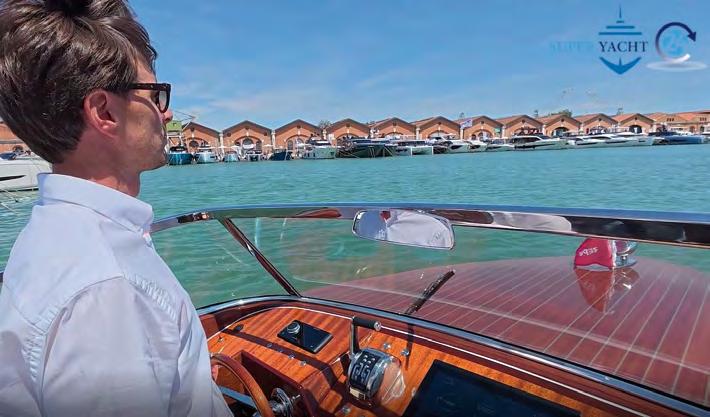
is equipped with waterproof battery compartments, active self-cooling systems, and an emergency control unit that automatically shuts down energy exchanges in the event of a malfunction. According to Repower, the operational and maintenance costs are 90% lower than those of an internal combustion taxi. Alongside the use of structural composite materials, Cantiere Serenella has preserved the traditional wood craftsmanship typical of Venetian taxis, incorporating paneling made from recycled Murano glass waste, thanks to a partnership with the startup Rehub.
To develop a boat truly suited to the Venetian lagoon, Repower
Potenza di ricarica (lato colonnina)
5
–
7 kW 20,6 h 15,4 h
kW 6,5 h
conducted a survey among local taxi operators to gather insights into their operational needs and expectations. The design process, entrusted to Nauta yachts, was informed by this feedback as well as a study of traditional water taxis. The result is a reinterpretation of the classic Venetian taxi, featuring modern lines and design elements inspired by the electric mobility world. “Electric boating is part of the broader revolution that has been transforming the mobility sector for years - says Fabio Bocchiola, CEO of Repower Italia - It’s also a key component of the sustainable mobility ecosystem that Repower has been developing over 15 years of experience in this field. The transition to electric technology is progressing at varying speeds. The European union has identified electric boating as a market expected to reach a global turnover of around 13 billion dollars by 2030”. To make this transition fully operational, a network of fast-charging stations will need to be integrated at strategic points across the city. The estimated cost for a recharge from 20% to 100% is around 40 euros.

alBErto Mariotti
l’aziEnda distriBuiscE i Pod norvEGEsi di sEadrivE, dis PotEnza. il salEs ManaGEr roBErto tuMMolo racconta i vanta the coMPanY distriButes norweGian seadriVe P ods, aVailaBle in three P ower sizes. s ales ManaGer roBerto tuMMolo exPlains the adVantaGes oF the sY steM
tra i tanti accessori distribuiti da saim marine ci sono anche i motori elettrici sviluppati e prodotti dall’azienda norvegese seaDrive, che si adattano tanto alle barche a motore quanto a quella vela. super YaCHt 24 ne ha parlato con roberto tummolo, sales manager della divisione marine dell’azienda lombarda: “Nel nostro catalogo abbiamo i motori di seaDrive, un sistema di propulsione elettrica composto da un pod azimutale che arriva, per il momento, ad un massimo di 20 kW di potenza. La sua caratteristica principale è che sia la trasmissione meccanica sia il motore sono all’interno del pod stesso, quindi non si perde spazio in sala macchine. Il pod viene flangiato a scafo e collegato ad una scatola per la componente elettronica. Il tutto è rimandato in plancia tramite dei cavi in CaN Bus dove un joystick permette il governo del motore”.
Quali sono i punti di forza del sistema?
“sono tre i punti principali della soluzione sviluppata da seaDrive: Il fatto che sia tutto compreso al loro interno, senza occupare altro spazio nel vano motori se non per l’elettronica – di fatto non li fa nessuno – e che i pod possano essere azimutali, ovvero ruotare a 360°, oltre che fissi. un’altra caratteristica è che sull’imbarcazione si possono montare fino a quattro pod integrati in un solo Joystick e gestibili in maniera integrata e coordinata dando così l’opportunità di una manovrabilità unica”.
Quali sono le taglie di potenza?
“L’offerta oggi è composta da tre pod con potenze da 7, 15 e 20 kW. Il primo è adatto a barche tra 7 e 9 metri, il secondo e il terzo possono andare su barche fino a circa 12 metri, ma quello da 20 kW può raggiungere velocità maggiori, mentre l’autonomia di navigazione dipende dal pacco batterie installato a bordo. L’azienda è già all’opera con lo svi-
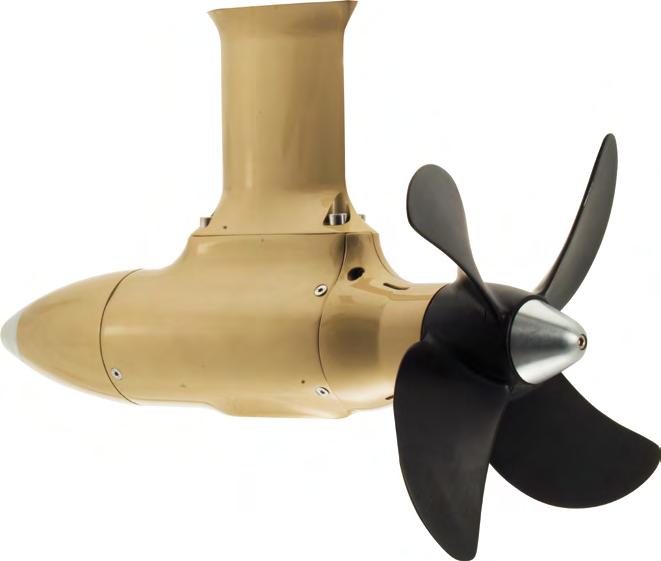
luppo di potenze fino a 50kW”.
Avete collaborazioni con qualche cantiere?
“stiamo lavorando con un armatore di Venezia che vorrebbe mettere due pod da 20 kW su un luxury taxi pensato per il periodo del Festival del cinema. In generale i cantieri ad oggi si concentrano su queste applicazioni solo se c’è una specifica richiesta del cliente o per progetti speciali. Inoltre l’Italia continua a procrastinare la chiusura delle aree marine e di conseguenza i diportisti non sono ancora obbligati a adottare la propulsione elettrica e questo è un ostacolo alla sua diffusione. e inoltre scarseggiano ancora le condizioni normative”.
Quale futuro vede per questa tecnologia?
“a differenza del settore automotive la nautica ha il problema sostanziale di non poter avere stazioni di ricarica in mezzo al mare e partendo da questo primo ostacolo vedo un’evoluzione simile a quella dell’auto in termini di logiche ma più contenuta in termini di numeri. Con le normative odierne avremo qualche applicazione probabilmente dovuta più ad aspetti legati al marketing e alla comunicazione che a un vero e reale interesse per la sostenibilità. sicuramente l’elettrico sarà una delle tecnologie che aiuterà la transizione alla mobilità sostenibile in generale, ma non sarà l’unica”.
Un esempio?
“Con il tempo si svilupperanno anche l’idrogeno e i nuovi carburanti Hvo e proprio su questi ultimi rimango sempre stupito come si punti di più a sviluppare tecnologie integrate tra generatori, idrogeno, fuel cell ancora complesse e non far funzionare, da subito, motori e generatori con questi carburanti che già esistono e permettono un risparmio drastico di emissioni. Quindi l’elettrico sarà una delle modalità di propulsione che avremo in futuro ma la transizione è lunghissima”.
Among the many accessories distributed by Saim Marine are the electric motors developed and produced by the Norwegian company SeaDrive, which are suitable for both motorboats and sailboats. SuPER yACHT 24 spoke with Roberto Tummolo, Sales Manager of the Marine division of the lombard company: “In our catalog, we offer SeaDrive motors-an electric propulsion system made up of an azimuth pod that currently reaches a maximum power of 20 kW. Its main feature is that both the mechanical transmission and the motor are housed inside the pod itself, meaning no space is lost in the engine room. The pod is flange-mounted to the hull and connected to a control box for the electronic components. Everything is routed to the helm via CAN Bus cables, where a joystick allows for motor control”. What are the main strengths of the system?
“There are three key features of the solution developed by SeaDrive: the fact that everything is selfcontained within the pod, without taking up any additional space in the engine room except for the electronics-which is something no one else currently offers; the pods can be either azimuth (i.e., capable of rotating 360°) or fixed. Another advantage is that up to four pods can be installed on a vessel, all integrated into a single joystick and managed in a coordinated and unified way, offering exceptional maneuverability”. What are the available power sizes?
“Currently, the offering includes three pods with power ratings of 7, 15, and 20 kW. The first is suitable for boats between 7 and 9 meters, while the second and third can be used on boats up to around 12 meters-but the 20 kW version can reach higher speeds. The range depends on the battery pack
installed on board. The company is already working on developing models up to 50 kW”.
Do you have collaborations with any shipyards?
“We’re working with a boat owner in Venice who wants to install two 20 kW pods on a luxury water taxi designed for the Venice Film Festival period. In general, shipyards today focus on these applications only when there is a specific client request or for special projects. Additionally, Italy continues to postpone the closure of marine areas, and as a result, recreational boaters are not yet required to adopt electric propulsion-this remains a major obstacle to its spread. Regulatory conditions are still lacking as well”. What future do you see for this technology?
“unlike the automotive sector, boating has the fundamental issue of not being able to rely on charging stations in the middle of the sea. Starting from this challenge, I foresee an evolution similar in logic to that of cars, but more limited in terms of numbers. With the current regulations, we’ll likely see some adoption driven more by marketing and communication reasons than by genuine interest in sustainability. Electric propulsion will certainly be one of the technologies supporting the transition to sustainable mobility in general-but it won’t be the only one”.
An example?
“Over time, hydrogen and new fuels like Hvo will also develop, and I’m always surprised that more effort is put into developing complex integrated technologies-like generators, hydrogen systems, and fuel cells-rather than simply running existing engines and generators on these already available fuels, which can drastically reduce emissions right away. So, electric propulsion will be one of the options we’ll have in the future, but the transition will be very long”.
“
“we’re
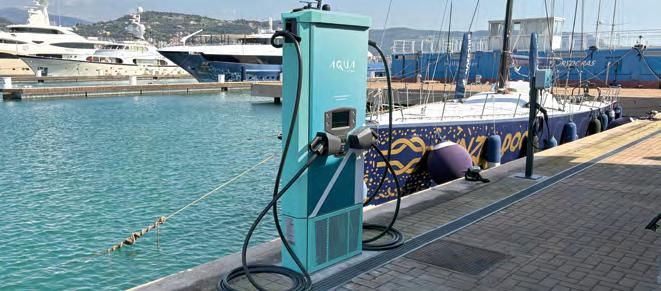
PEr il country ManaGEr l’EsPansionE dElla rEtE di ricarica ProcEdE con un aPProccio Mirato. Focus su laGHi, isolE E arEE ProtEttE, tra nuovE installazioni E soluzioni su Misura PEr i suPEryacHt
For the countrY ManaGer, the exPansion oF the charGinG network is ProGressinG with a tarGeted aPProach. the Focus is on lakes, islands, and Protected areas, with new installations and custoM solutions For suPerYachts
aqua superpower è una delle aziende leader nelle infrastrutture di ricarica rapida marine per imbarcazioni e un partner importante per diverse marine che stanno iniziando ad adottarle. Del gruppo fanno parte anche il brand Vita power, che di recente si è unito al produttore di motori elettrici norvegese evoy, e la canedese taiga, specializzata in moto d’acqua (e slitte da neve) elettriche. un’offerta quindi completa, che spazia dalle colonnine di ricarica, alle barche, ai motori fino ai water toys. Il country manager per l’Italia di aqua superpower, michele Bolpagni, racconta a super YaCHt 24 le ultime novità e il motivo per cui la diffusione delle stazioni di ricarica procede più lentamente del previsto. Michele partiamo da un commento sul mercato italiano. Le barche elettriche si stanno diffondendo a una velocità più lenta del previsto e invece di una rete capillare ci stiamo concentrando su determinate zone dove sappiamo esserci interesse per questo tipo di propulsione (e soprattutto utilizzo). tra queste Venezia ha un potenziale elevato, così come laghi, isole e la zona delle Cinque terre. abbiamo completato un’installazione in sardegna e presto ne faremo una seconda, stiamo proseguendo con il ‘corridoio’ che arriva dalla Francia toccando Ventimiglia, Loano e a breve anche Genova, con l’obiettivo di scendere lungo la costa. sul Lago maggiore abbiamo già tre punti di ricarica veloce che permettono di utilizzare bene la barca elettrica in quel contesto. stiamo seguendo un’installazione anche sul lago di Garda, presso Nautica Casarola, che prevedo sarà pronta entro la fine dell’anno”.
Su Venezia avete progetti specifici?
“al momento sono due le stazioni di ricarica e abbiamo presentato una proposta al Comune per realizzare una rete, un progetto pilota per poi
procedere con un’installazione più capillare, collaboriamo inoltre con diversi cantieri che stanno sviluppando taxi elettrici, come repower ad esempio, o barche da lavoro. è importante lavorare insieme ai cantieri e collaborare”.
A livello normativo sta cambiando qualcosa?
“sono in discussione normative specifiche e notiamo che molti costruttori iniziano a utilizzare gli stessi componenti e standard dell’automotive, una tendenza positiva. riguardo al territorio, il parco nazionale delle Cinque terre aveva fatto una proposta interessante per consentire la navigazione in alcune aree solo alle barche elettriche, ma la richiesta è stata ma il tutto è stato posticipato all’anno prossimo proprio per mancanza di infrastrutture di ricarica. Le aeree protette dovrebbero accelerare questo passaggio ma poi servirebbero anche gli incentivi, perché i costi sono ancora elevati per la conversione all’elettrico”. Tender di lusso ed elettrico è un’accoppiata vincente?
“Il mondo del tender elettrici è in grande sviluppo e di recente è stato varato il primo superyacht – non posso fare nomi al momento – dotato di infrastruttura di ricarica veloce a bordo per i suoi due tender elettrici. Quello del tender è un utilizzo perfetto per questo tipo di propulsione, navigano su distanze ridotte e permettono di non stoccare carburante nell’area del garage, uno degli aspetti più apprezzati. aqua superpower può fornire soluzioni personalizzate per la ricarica veloce dei tender, sia nel garage stesso sia con il tender già in acqua. Il superyacht su cui abbiamo lavorato ha tre punti di ricarica intorno alla barca e permette una soluzione customizzata che va dalla ricarica in corrente continua veloce fino a 120 kW fino a quella lenta nel garage. Il sistema è stato completamente integrato nell’arredo dello yacht e non è quindi visibile”.
Aqua superPower is one of the leading companies in rapid marine charging infrastructure for boats and an important partner for several marinas that are beginning to adopt such systems. The group also includes the brand Vita Power, which recently joined forces with Norwegian electric motor manufacturer Evoy, and the Canadian company Taiga, specialized in electric jet skis (and snowmobiles). It’s a comprehensive offering-from charging stations to boats, motors, and water toys. Aqua superPower’s country manager for Italy, Michele Bolpagni, shared with SuPER yACHT 24 the latest developments and the reasons why the spread of charging stations is progressing more slowly than expected. Michele, let’s start with a comment on the Italian market. Electric boats are spreading at a slower pace than expected, and instead of aiming for a widespread network, we are focusing on specific areas where we know there is real interest in this type of propulsion (and especially its practical use). Among these, Venice shows high potential, as do lakes, islands, and the Cinque Terre area. We’ve completed an installation in Sardinia and will soon be doing a second. We’re continuing with the ‘corridor’ from France through Ventimiglia and loano, and soon also Genoa, with the goal of moving down the coast. On lake Maggiore, we already have three fast-charging stations that allow for effective electric boat use in that setting. We’re also working on an installation on lake Garda, at Nautica Casarola, which I expect to be ready by the end of the year”. Do you have specific projects for Venice?
“At the moment, there are two charging stations, and we’ve submitted a proposal to the Municipality to create a network-a pilot project that could later lead to a
more widespread installation. We’re also working with several shipyards that are developing electric water taxis, such as Repower, and also workboats. It’s important to work together with the shipyards and collaborate”.
Are there any regulatory changes underway?
“Specific regulations are under discussion, and we’re seeing that many manufacturers are beginning to use the same components and standards as the automotive industry-a positive trend. Regarding the territory, the Cinque Terre National Park had made an interesting proposal to allow navigation in certain areas only for electric boats, but everything was postponed to next year due to the lack of charging infrastructure. Protected areas should be driving this transition, but incentives would also be needed, as the costs for switching to electric propulsion are still high”. Are luxury tenders and electric propulsion a winning combination?
“The world of electric tenders is growing rapidly, and recently the first superyacht was launchedthough I can’t reveal the name yet-equipped with a fast-charging infrastructure onboard for its two electric tenders. Tenders are a perfect use case for this type of propulsion: they travel short distances and eliminate the need to store fuel in the garage area, which is one of the most appreciated aspects. Aqua superPower can provide customized fastcharging solutions for tenders, either inside the garage or with the tender already in the water. The superyacht we worked on has three charging points around the vessel, offering a tailored solution ranging from fast DC charging up to 120 kW to slower charging in the garage. The system has been fully integrated into the yacht’s furnishings, making it completely invisible”.
intErvista a GaBriElE carniGlia, MastEr dEl M/y rJ, un cantiErE dEllE MarcHE lunGo 48 MEtri, sEGuito dalla cHasEBoat M/y FolloW ME, un novaMarinE Bs140, E da un tEndEr scout castoldi 17 carGo
interView with GaBriele c arniGlia, caPtain oF the MeGaYacht rj, a 48-Meter Yacht Built BY c antiere delle Marche, accoMPanied BY the chase Boat M/Y Follow Me, a noVaMarine Bs140, and a scout tender c astoldi 17 c arGo
II tender non sono più semplici mezzi di trasferimento, ma vere e proprie estensioni dello yacht, sia in termini di design che di dotazioni. tra vincoli tecnici, esigenze di comfort e richieste estetiche, la loro scelta richiede oggi una visione d’insieme che coinvolge comandante, armatore e costruttori. per capire come avviene questo processo, abbiamo intervistato il comandante Gabriele Carniglia, oggi al comando di rJ, explorer yacht Cantiere delle marche lungo 48 metri. a seguire una rassegna dei principali modelli oggi disponibili sul mercato. Comandante qual è la filosofia generale nella scelta del tender per un superyacht come il suo? “È la stessa che ha il proprietario come visione di utilizzo dello yacht. Noi abbiamo voluto un explorer fatto per navigare per lunghi periodi e in giro per il mondo, senza particolari problematiche di sosta. Di conseguenza, anche i nostri tender devono avere delle caratteristiche tali da poter supportare questa esigenza. Nello specifico abbiamo un Castoldi 17 Cargo per trasportare persone e carico, come ad esempio biciclette, canoe, i rifiuti a terra, l’approvvigionamento di materiali e alimenti, mentre la chaseboat è un Novamarine 140, scelta per le sue valide caratteristiche di navigazione ma anche di autonomia, fino a 450 miglia, che non sono comuni per una barca di queste dimensioni. Nel suo insieme è accattivante nelle linee, asciutto, protetto. Inoltre, ha buone performance di velocità e permette di coprire distanze quasi a tre volte tanto la velocità della barca grande. Il tender deve essere un miglioramento dal punto di vista del comfort percepito ma anche della sicurezza: pensiamo al caso di qualcuno che ha un malore, un infortunio a bordo: posso raggiungere il primo pronto soccorso disponibile in tempi brevi”. Quanto conta il parere del comandante rispetto a quello
dell’armatore?
“Nel nostro caso c’è stata una forte collaborazione, anche perché sono ormai 16 anni che lavoriamo insieme, abbiamo navigato tanto, costruito tanti yacht e avuto esperienza con diverse imbarcazioni e modi di vivere la barca insieme. Fattori che ci hanno portato a strutturare una visione comune e un rapporto di fiducia reciproca, dove io sono il suo punto di riferimento dal punto di vista tecnico. Quindi presento delle alternative, secondo me interessanti per il nostro utilizzo, poi l’armatore con la moglie fanno le loro considerazioni finali, quanto meno estetiche, perché anche quello è importante a questo livello di dettaglio. È una collaborazione stretta tra armatore e comandante. Nella scelta si guarda anche l’immagine e la funzionalità che deve trasmettere, se abbiamo un explorer sarà un tender più avventuroso, se abbiamo delle linee più eleganti sarà magari un riva aquarama”. Il tender deve essere quasi la riproduzione in miniatura dello yacht o si guarda più alla funzionalità che all’immagine?
“secondo me sono legate tra loro, ma è necessario che ci sia un fil rouge, dato che i gusti sono personali. Nel nostro caso abbiamo cercato di uniformare i colori per identificare la flotta di cui fanno parte, mi piace l’idea che i tender siano tutti collegati alla nave madre anche nei colori dei cuscini, nei colori primari della verniciatura e nel design. abbiamo scelto qualcosa che non fosse troppo estremo, il nostro yacht ha caratteristiche da explorer puro ma in realtà ha delle linee eleganti. abbiamo cercato tender che esprimessero forza, carattere ma anche eleganza”.
Quali sono le innovazioni più interessanti che ha visto di recente nel settore dei tender?
“per i tender forse meno innovazioni, dato che le caratteristiche fondamentali, da tanti anni, sono quelle
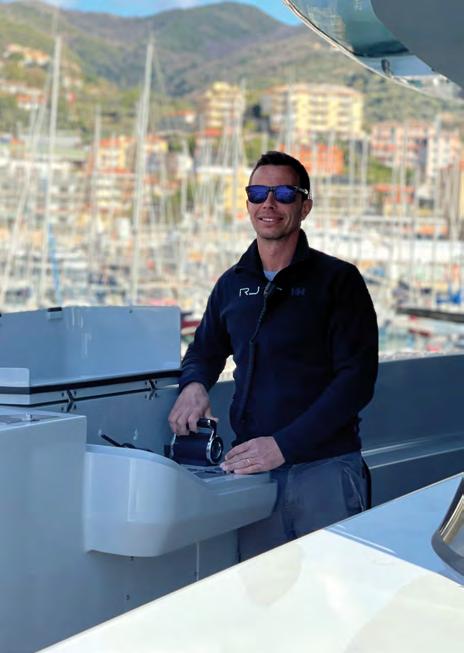
Tenders are no longer just simple means of transportthey have become true extensions of the yacht, both in terms of design and equipment. With technical constraints, comfort requirements, and aesthetic demands all in play, choosing the right tender now calls for a comprehensive approach that involves the captain, the owner, and the builders. To understand how this process unfolds, we interviewed Captain Gabriele Carniglia, currently at the helm of RJ, a 48-meter explorer yacht by Cantiere delle Marche. Following the interview is a selection of the main tender models currently available on the market.
Captain, what is the general philosophy behind choosing a tender for a superyacht like yours?
It reflects the same vision the owner has for the use of the yacht. In our case, we wanted an explorer designed for long periods of navigation around the world, without particular concerns about stopping. As a result, our tenders also need to have the right characteristics to support this goal. Specifically, we have a Castoldi 17 Cargo, which we use to transport people and cargo-such as bicycles, kayaks, waste to shore, supplies, and food. Our chase boat is a Novamarine 140, chosen for its excellent seakeeping capabilities and range-up to 450 miles, which is uncommon for a boat of this size. Overall, it has an attractive design, it’s dry, well protected, and performs well in terms of speed. It can cover distances at almost three times the speed of the main yacht. A tender should enhance both the perceived comfort and the safety on board. Think of a scenario where someone falls ill or gets injured-we need to be able to reach the nearest medical facility quickly”.
How much does the captain’s
opinion matter compared to the owner’s?
“In our case, there’s been a strong collaboration, especially because we’ve been working together for 16 years. We’ve sailed extensively, built several yachts, and experienced many different vessels and styles of living on board together. All of this has led us to develop a shared vision and a relationship built on mutual trust, where I act as his technical point of reference. So I present options that I believe are well-suited to our needs, and then the owner and his wife make the final decisions-at least on the aesthetic side, which is also important at this level of detail. It’s a close collaboration between owner and captain. When choosing, we also consider the image and function the tender needs to convey: if we have an explorer yacht, the tender will have a more adventurous character; if the yacht has more elegant lines, we might go for something like a Riva Aquarama”.
Should the tender be almost a miniature version of the yacht, or is functionality more important than image?
I believe the two are connected, but there needs to be a common thread, since preferences are personal. In our case, we aimed to coordinate the colors to clearly identify the tenders as part of the same fleet. I like the idea that the tenders are visually tied to the mothership-even in the cushion fabrics, primary paint colors, and design. We chose something that isn’t too extreme. Our yacht has the features of a true explorer, but it also has elegant lines. We looked for tenders that convey strength and character, but also elegance”. What are the most interesting innovations you’ve seen recently in the tender sector?
“When it comes to tenders, perhaps there have been fewer innovations, since the core re-

GiusEPPE orrù
di dover essere pronti ad essere stivati e movimentati a bordo, in spazi angusti, avere buone prestazioni. Le chaseboat, invece, negli ultimi anni hanno avuto una grandissima espansione. Dai primissimi wallytender, che Wally presentò sul mercato all’inizio dei primi anni del 2000 in poi, c’è stata una crescita esponenziale anche con modelli ibridi e elettrici. però sicuramente c’è un’attenzione in più sia da parte del mercato sia dei costruttori”.
Il tema della sostenibilità sta influenzando anche le richieste per i tender?
“È un tema che piace all’idea, ma il concetto è sempre relativo a quanto budget deve essere investito da parte dell’armatore: quando si parla di nuove tecnologie, cosiddette green, va messa anche a budget una sensibile quantità di denaro, dato che un pacco batterie o una nuova tecnologia inerente a questo aspetto ha un costo che va oltre quello della propulsione tradizionale. secondo me, gli stessi cantieri stanno iniziando adesso ad affrontare questo tipo di tecnologie, quindi io, dal mio punto di vista, non lo riterrei ancora maturo per investirci. se invece l’armatore è propenso si butta il cuore oltre all’ostacolo e si dà una mano alla tecnologia a crescere, dato che in questo momento tutti i feedback sono importanti per portare a casa il miglior risultato possibile. siamo ancora in una fase di transizione”. Quali sono i principali requisiti tecnici?
“Dimensioni e peso sono i più importanti, seguiti da autonomia, motorizzazione e capacità di navigare con meteo avverso in condizioni di comfort per gli ospiti. Vengono fatti calcoli in base al garage dal punto


di vista tecnico, così avviene la prima scrematura. poi si guarda alle caratteristiche di navigazione. a prescindere dall’utilizzo giornaliero, dove magari si usa il tender per il traino di water toys o per gestire la giornata al mare, abbiamo anche il momento in cui dobbiamo sbarcare degli ospiti vestiti con l’abito da sera per andare a cena o a un party. La protezione dall’acqua di mare e dal vento è fondamentale. Ci sono inoltre le problematiche di stivaggio e movimentazione con le gru, i carri ponte, l’accessibilità ai garage ecc. Va tenuto conto di tutte queste situazioni, anche perché si fa sempre a gara a cercare di mettere nello spazio più angusto il tender più grande possibile. si cerca sempre di arrivare a un compromesso; è importante collaborare fin da subito con il team dell’armatore, il cantiere che deve fornire tutte le caratteristiche di stivaggio e movimentazione e il cantiere costruttore del tender, perché è un concerto, è una parte delicata che va gestita tra le parti”.
quirements have remained the same for many years: they need to be easy to store and handle on board, often in tight spaces, and they must offer solid performance. However, chase boats have seen a huge expansion in recent years. Since the very first Wallytenders introduced by Wally in the early 2000s, there has been exponential growth, including hybrid and electric models. So there’s definitely greater attention being paid by both the market and manufacturers”.
Is the topic of sustainability starting to influence tender choices as well?
“It’s an appealing idea, but the concept is always tied to the bud get the owner is willing to invest. When we talk about new so-called green technologies, you have to account for a significantly higher cost-whether it’s for battery packs or other related technologieswhich goes well beyond traditional propulsion systems. In my opinion, shipyards themselves are only
now starting to seriously engage with these technologies, so from my perspective, I wouldn’t yet consider them mature enough to invest in. However, if the owner is inclined, and is willing to take a leap of faith, it can help accelerate technological development-especially since right now, every bit of feedback is crucial to achieving the best possible outcome. We’re still in a transitional phase”. What are the main technical requirements?
“Size and weight are the most important, followed by range, engine type, and the ability to navigate in rough weather while still providing comfort for guests. Technical calculations are made based on the garage space, and that’s where the initial selection happens. Then we assess navigation performance. Beyond daily use-such as towing water toys or managing beach days-there are moments when we need to drop off guests dressed in evening wear for dinner or a party. Protection from sea spray and wind becomes essential. There are also practical concerns around stowage and handling using cranes, gantries, and garage access. All of these factors must be taken into account, especially
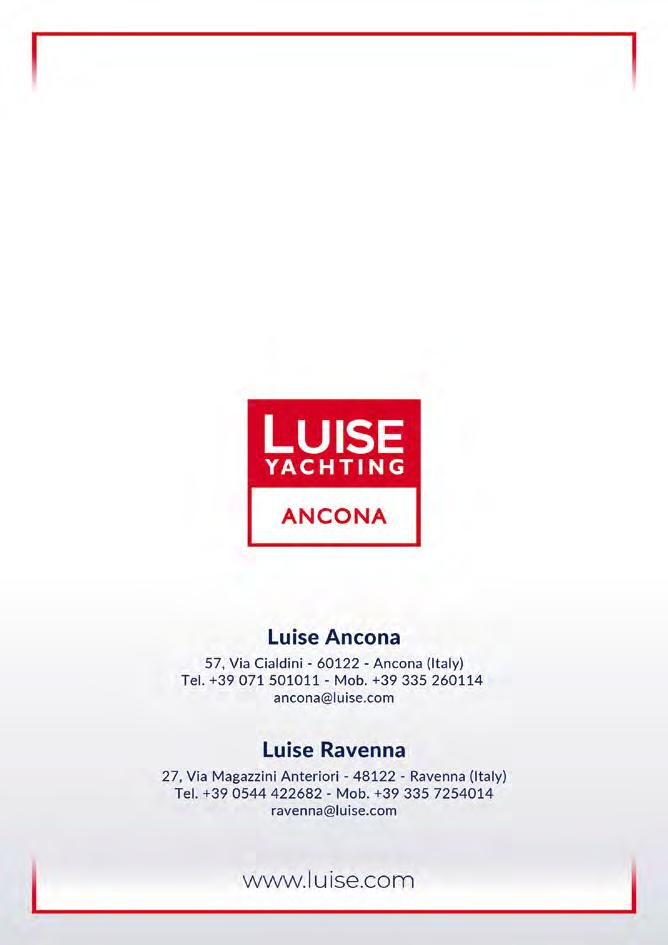
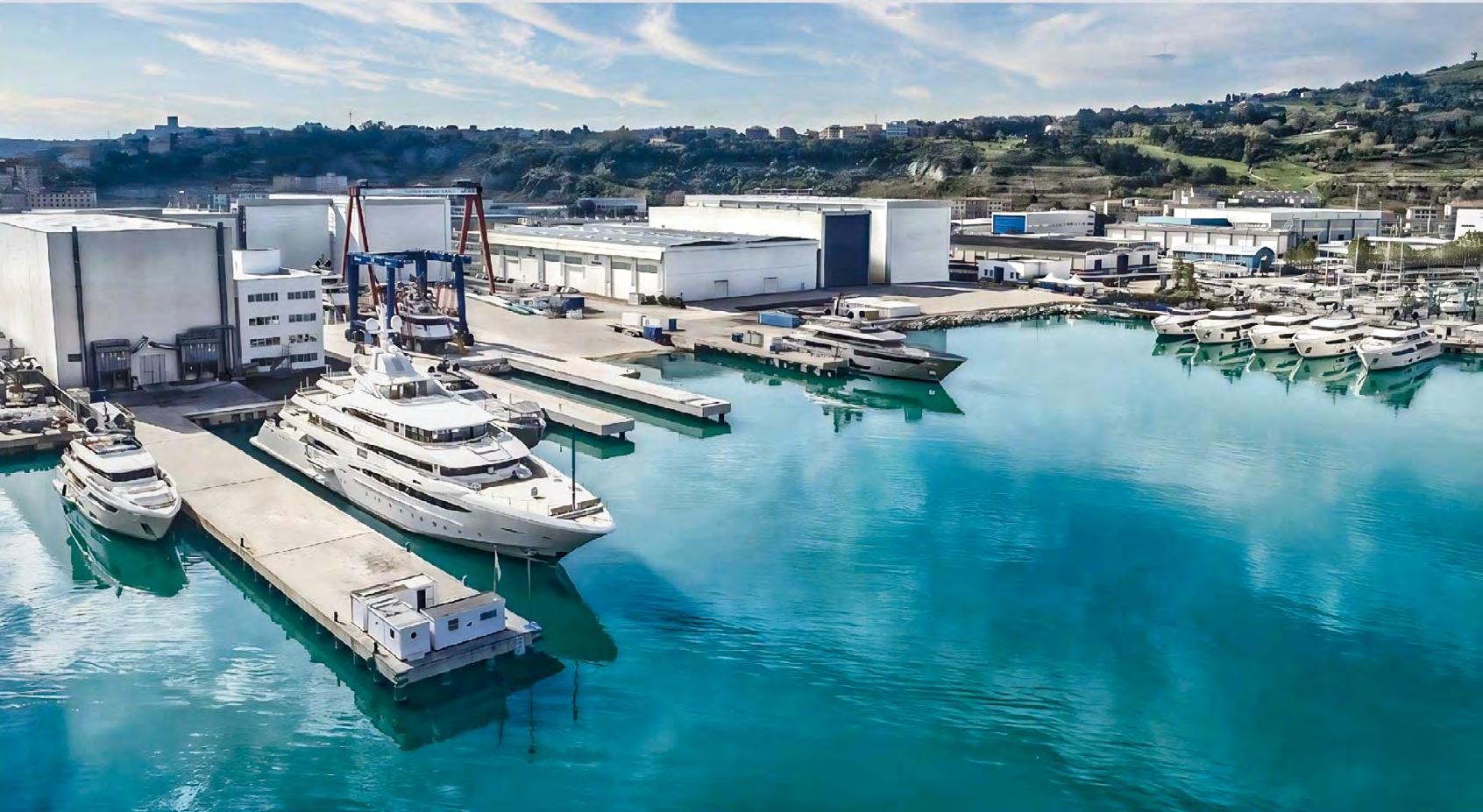
PEso ridotto E PrEstazioni ElEvatE è così cHE il cantiErE roMaGnolo, cHE Ha Basato il suo succEsso sul carBonio, crEa ModElli cHE si distinGuono PEr EFFiciEnza E vErsatilità
reduced weiGht and hiGh PerForMance. that’s how the roMaGna-Based shiPYard, which has Built its success on carBon FiBer, creates Models that stand out For their eFFiciencY and Versatilit Y
Nel panorama dei tender e delle chase boat destinati a supportare i maxiyacht, le imbarcazioni a nvera rappresentano un punto di riferimento per l’applicazione di tecnologie avanzate e soluzioni ingegneristiche mirate. La scelta della fibra di carbonio come materiale primario non è dettata da mere considerazioni estetiche, ma da un’attenta valutazione delle prestazioni strutturali e dell’efficienza operativa.
Con sede a m isano adriatico, proprio di fronte all’autodromo, l’azienda ha trasferito alla nautica il know-how maturato in settori ad alta intensità tecnologica, come l’automotive performante e le competizioni offshore, dove il rapporto tra peso, rigidità e resistenza è un fattore critico.
L’utilizzo del carbonio garantisce un incremento del 20% nella rigidità torsionale rispetto alle costruzioni tradizionali in vetroresina o alluminio per una maggiore stabilità dinamica a velocità elevate o in condizioni di mare mosso.
La riduzione del peso, che può raggiungere il 40%, comporta vantaggi anche in termini di con -
sumi e autonomia, aspetti importanti per unità di supporto ai superyacht.
Le imbarcazioni sono progettate per rispondere a esigenze operative diversificate, dall’assistenza a maxiyacht alle crociere giornaliere.
La flessibilità d’impiego deriva da scelte progettuali precise, come lo specchio di poppa libero e le terrazze laterali abbattibili, che consentono di riconfigurare gli spazi in base alle necessità. La passerella integrata, ad esempio, è studiata per garantire un trasbordo sicuro anche in condizioni avverse, mentre gli interni modulari permettono di allocare aree per l’equipaggio, water toys o zone lounge senza compromettere le prestazioni. particolare attenzione è riservata alle normative internazionali: il cantiere offre configurazioni conformi agli standard m ca ( s cv) red Flags e Cyc m alta Flag, essenziali per operatori professionali che richiedono unità certificate per uso commerciale. Questa capacità di aderire a requisiti tecnici stringenti rappresenta un valore aggiunto per flotte e management di grandi yacht,
dove la compliance normativa è parte integrante della progettazione.
L’efficienza propulsiva è ottimizzata grazie alla leggerezza degli scafi e all’aerodinamica studiata per ridurre la resistenza idrodinamica: con una lunghezza di 20 metri e una velocità massima superiore ai 70 nodi, l’a nvera 200-s dimostra come l’utilizzo del carbonio possa conciliare dimensioni contenute e prestazioni elevate.
La riduzione dei consumi, unita a una maggiore autonomia, rende queste imbarcazioni adatte a missioni prolungate o a operazioni in aree remote.
La gamma, che spazia dai 42 ai 66 piedi, è pensata per coprire un’ampia varietà di scenari d’uso.
I modelli più compatti, come il 42, sono ideali per l’esplorazione di aree costiere o per brevi soggiorni, grazie alla presenza di una cabina e un bagno. Le versioni più grandi, come l’a nvera 58, offrono invece una beach area di 23,4 mq e ampie possibilità di personalizzazione, rendendole adatte a crociere giornaliere o a operazioni di supporto più complesse.
La capacità di trasformazione degli spazi permette di passare
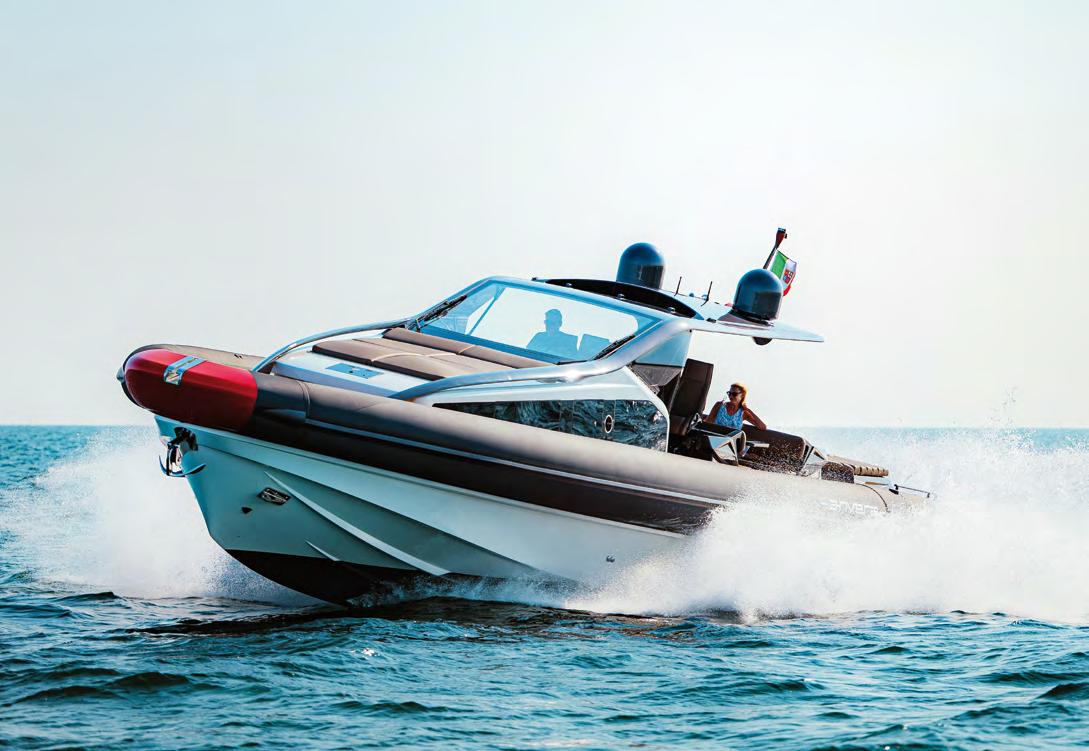
da una configurazione sportiva a una dedicata al relax o all’intrattenimento con soluzioni come le terrazze laterali abbattibili e gli interni riconfigurabili, una versatilità apprezzata nel mondo dello yachting, dove le esigenze possono variare sensibilmente in base alla destinazione d’uso. L’uso del carbonio, le soluzioni tecniche, l’attenzione alla sostenibilità e la flessibilità d’impiego rendono queste imbarcazioni adatte ai professionisti esigenti, che richiedono prestazioni elevate senza compromessi sulla funzionalità.
In produzione il cantiere ha implementato un sistema di recupero e riutilizzo delle fibre di carbonio residue, che vengono impiegate come strato superficiale negli scafi.
Questo approccio non solo riduce gli sprechi, ma contribuisce a ottimizzare la finitura superficiale, migliorando la resistenza all’usura e agli agenti esterni.
L’attenzione alla sostenibilità si estende anche agli impianti produttivi, dove l’adozione di pannelli fotovoltaici permette di ridurre la dipendenza da fonti energetiche tradizionali.
In the realm of tenders and chase boats designed to support maxi yachts, Anvera vessels stand as a benchmark for the application of advanced technologies and targeted engineering solutions. The choice of carbon fiber as the primary construction material is not merely an aesthetic one, but the result of a careful evaluation of structural performance and operational efficiency. Headquartered in Misano Adriatico, directly across from the racetrack, the company has transferred to the nautical world the know-how gained in high-tech sectors such as high-performance automotive and offshore racing, where the balance between weight, rigidity, and strength is a critical factor. The use of carbon fiber ensures a 20% increase in torsional rigidity compared to traditional fiberglass or aluminum constructions, resulting in greater dynamic stability at high speeds or in rough seas.
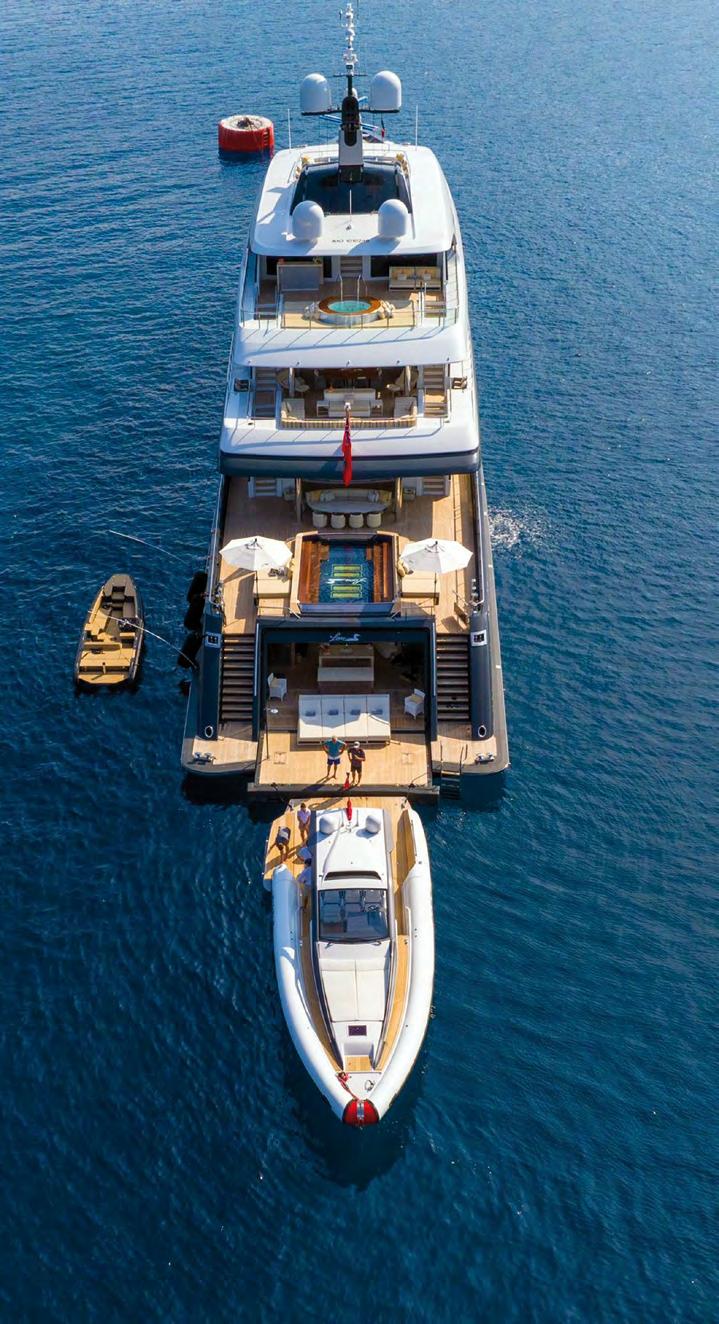
The weight reduction-up to 40%also brings significant benefits in terms of fuel consumption and range, both of which are essential for vessels that support superyachts.
Anvera boats are engineered to meet a wide range of operational needs, from maxi yacht support to day cruising. Their flexibility stems from precise design choices, such as an open aft deck and fold-down side terraces, which allow the onboard layout to be reconfigured according to specific requirements. For instance, the integrated gangway is designed to ensure safe boarding and disembarkation even in challenging conditions, while modular interiors offer customizable spaces for crew areas, water toys, or lounge zones-without compromising performance.
Special attention is given to international regulations: the shipyard provides configurations that comply with MCA (SCV) Red Flags and CyC Malta Flag standards. These certifications are essential for professional operators who require vessels approved for commercial use. Anvera’s ability to meet stringent technical requirements adds significant value for superyacht fleets and management teams, where regulatory compliance is a fundamental part of the design process. Propulsion efficiency is maximized through the lightness of the hulls and carefully studied aerodynamics aimed at reducing hydrodynamic drag. With a length of 20 meters and a top speed exceeding 70 knots, the Anvera 200-S exemplifies how the use of carbon fiber can reconcile compact dimensions with exceptional performance. Reduced fuel consumption combined with
extended range makes these boats well-suited for long-duration missions or operations in remote areas. The range, spanning from 42 to 66 feet, is designed to cover a wide variety of use cases. More compact models, like the Anvera 42, are ideal for coastal exploration or short stays, thanks to the inclusion of a cabin and bathroom. larger versions, such as the Anvera 58, offer a 23.4-square-meter beach area and extensive customization options, making them perfect for day cruises or more complex support operations.
The ability to transform onboard spaces allows Anvera boats to shift seamlessly from a sporty configuration to one focused on relaxation or entertainment. Features like fold-down side terraces and reconfigurable interiors offer a level of versatility highly valued in the yachting world, where usage needs can vary greatly depending on the mission. The use of carbon fiber, combined with advanced technical solutions, a strong focus on sustainability, and operational flexibility, makes these vessels ideal for demanding professionals who seek top-tier performance without compromising functionality. In its production process, the shipyard has implemented a recovery and reuse system for leftover carbon fiber, repurposing it as a surface layer in the hulls. This not only reduces material waste but also enhances surface finish, improving resistance to wear and environmental exposure. The commitment to sustainability extends to the manufacturing facilities as well, where photovoltaic panels help reduce reliance on traditional energy sources.
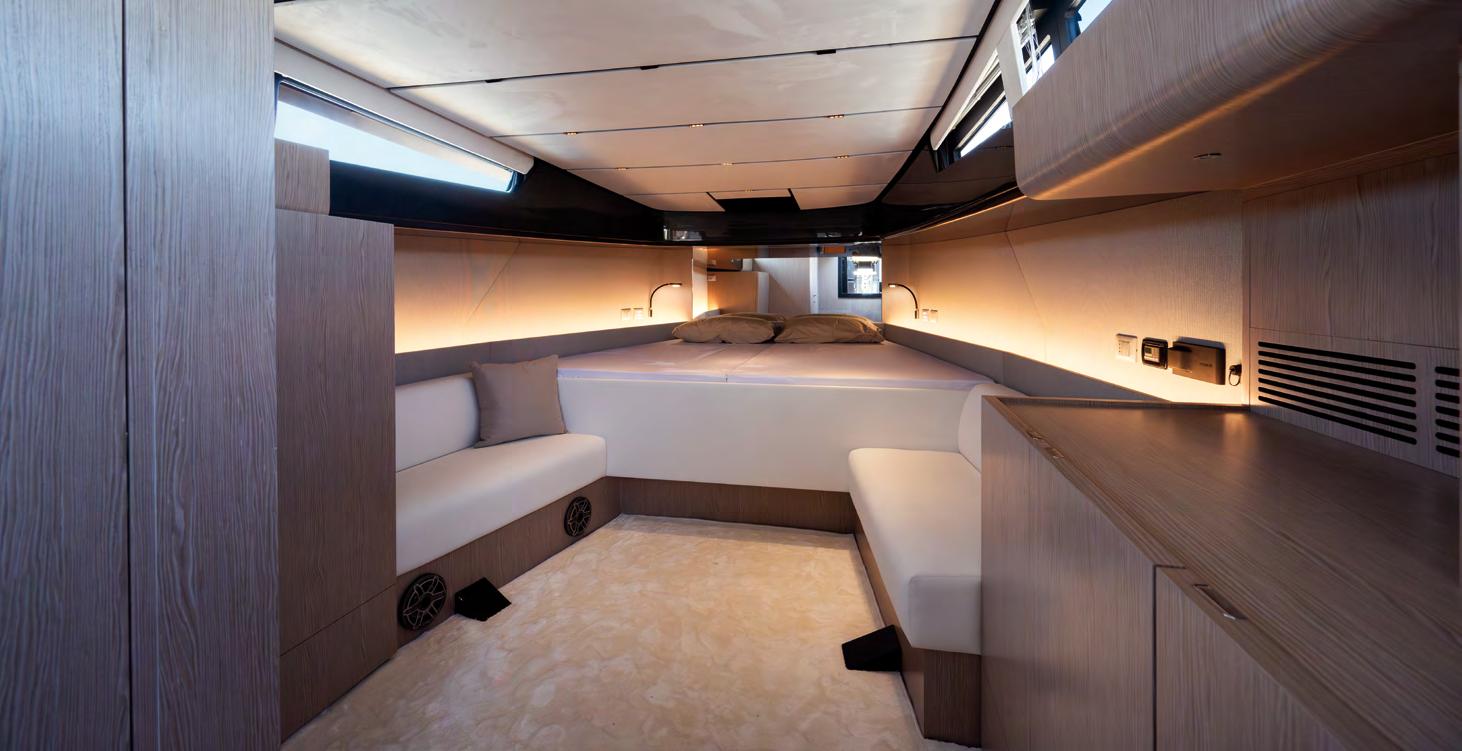
stradivari 52, l’ultimo arrivato della gamma di Cantieri Capelli, è spinto da quattro Yamaha V8 XtO da 450 cv, per una propulsione fuoribordo da 1.800 cv complessivi, con iniezione diretta e sterzo elettronico digitale integrato, abbinata al sistema Helm master e X per la gestione di precisione e manovrabilità totale. La carena è realizzata in infusione, come hard top e dettagli strutturali. tubolari in Orca Neoprene Hypalon 1670 dtex, ponte in teak e omologazione B per 20 persone. peso a secco 9.950 kg, 11.900 kg con motori installati. Il design, firmato Capelli e BG Design Firm, integra estetica e funzionalità, offrendo un package tecnico di alto livello per velocità, controllo e comfort in navigazione.
www.CAntieRiCApelli.Com
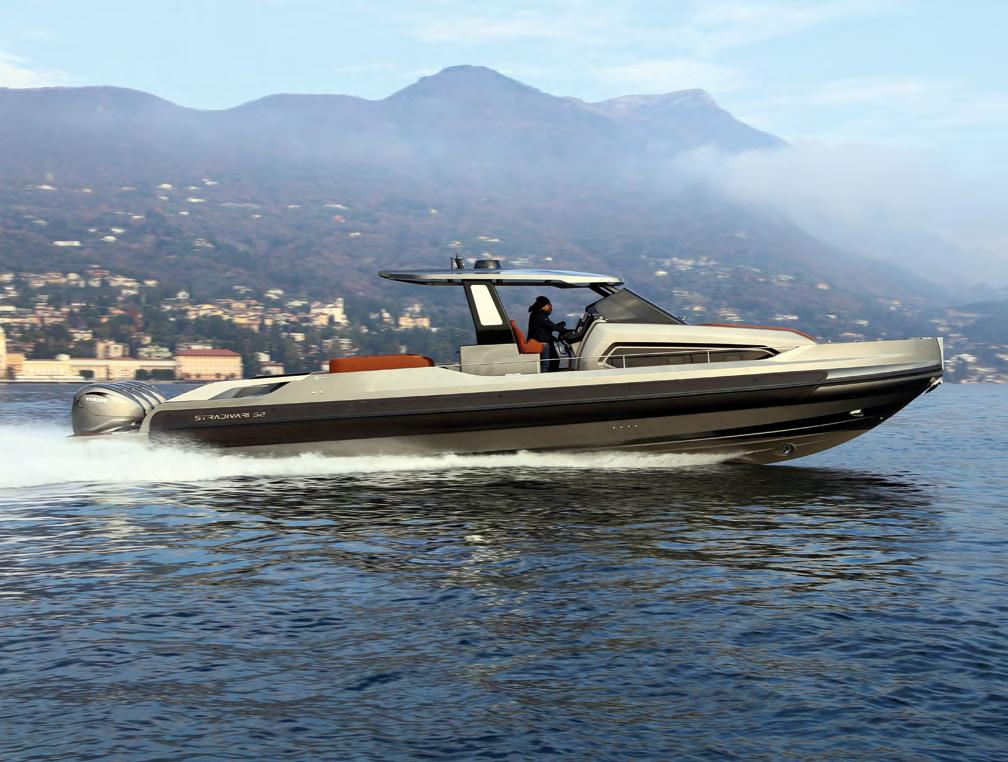
Stradivari 52, the latest addition to the Cantieri Capelli range, is powered by four Yamaha V8 XTO outboards, each delivering 450 hp, for a total output of 1,800 hp. These engines feature direct injection and integrated digital electric steering, paired with the Helm Master EX system for precise handling and total maneuverability. The hull, hardtop, and structural details are built using infusion technology. The tubes are made of Orca Neoprene Hypalon 1670 dtex, with a teak deck and Category B certification for up to 20 people. Dry weight is 9,950 kg, increasing to 11,900 kg with engines installed. The design, created by Capelli in collaboration with BG Design Firm, blends aesthetics and functionality, offering a high-level technical package focused on speed, control, and comfort at sea.
Flynt 956 è il primo modello del cantiere olandese Flynt Yachts, progettata con Vripack. Lunga 9,56 m, monta una carena planante a V profonda che assicura stabilità a velocità sostenute. motorizzata con merCruiser abbinati a trasmissioni Bravo three X, offre accelerazioni pronte e manovrabilità precisa, supportata da bowthruster di serie. Linee tese, prua alta e plancetta bagno ampia definiscono l’estetica. In coperta: sedili recaro regolabili, prendisole trasformabile e parabrezza curvo in pezzo unico per protezione aerodinamica. sottocoperta cabina doppia con bagno nascosto e mini-cucina. scafo in vetroresina composita, acciai inox 316 e ponte effetto teak completano una costruzione curata, personalizzabile e adatta a navigazioni tecniche e veloci.
The Flynt 956 is the first model from Dutch shipyard Flynt Yachts, designed in collaboration with Vripack. Measuring 9.56 meters in length, it features a deep-V planing hull that ensures stability at high speeds. Powered by MerCruiser engines paired with Bravo Three X drives, it delivers quick acceleration and precise maneuverability, aided by a standard
www.FlYntYACHts.Com
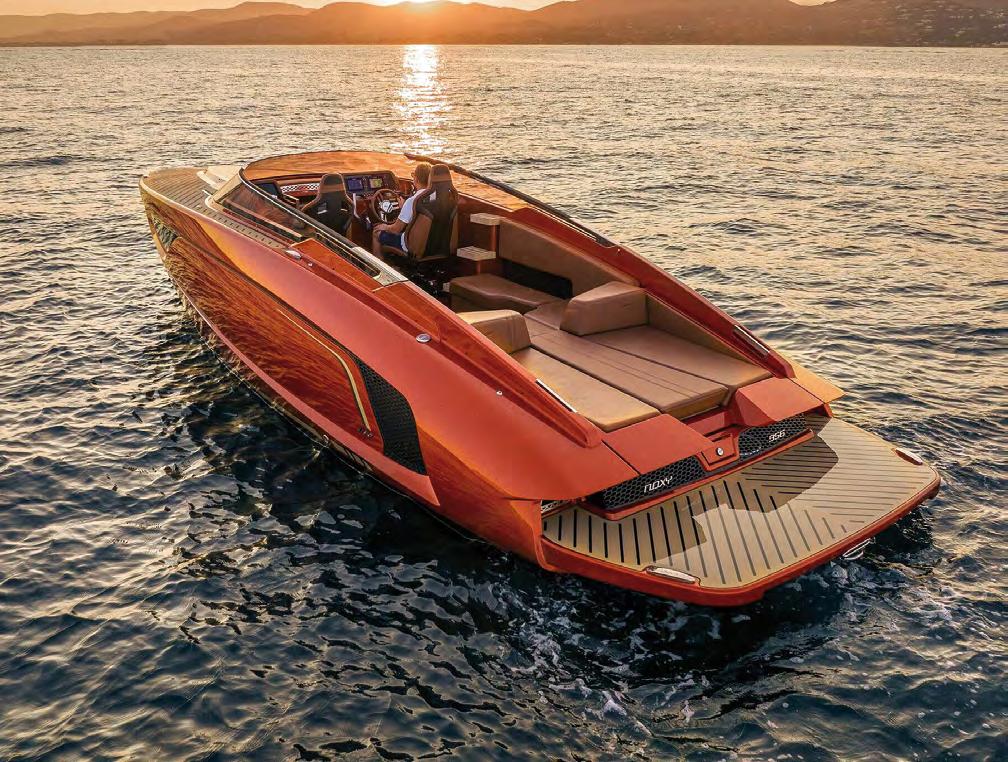
deck, the Flynt 956 combines meticulous
castOLDI Jet teNDer 17
Castoldi presenta il nuovo Jet tender 17, tender completamente riprogettato per alzare gli standard nel segmento yacht tender. Lungo 5,20 metri, combina linee moderne a soluzioni funzionali evolute: portello di poppa, ampia area di carico e rampa prodiera per l’approdo a terra. La carena “gullwing” laminata in Kevlar assicura stabilità laterale e navigazione asciutta. a bordo, spazi ottimizzati e volumi interni superiori alla media della categoria. La motorizzazione prevede un diesel da 170 hp abbinato al collaudato waterjet Castoldi turbodrive 224 Da , per manovre precise e sicurezza in ogni condizione. Disponibili tendalini prua e poppa pieghevoli e removibili, per protezione efficace in caso di vento o mare formato.
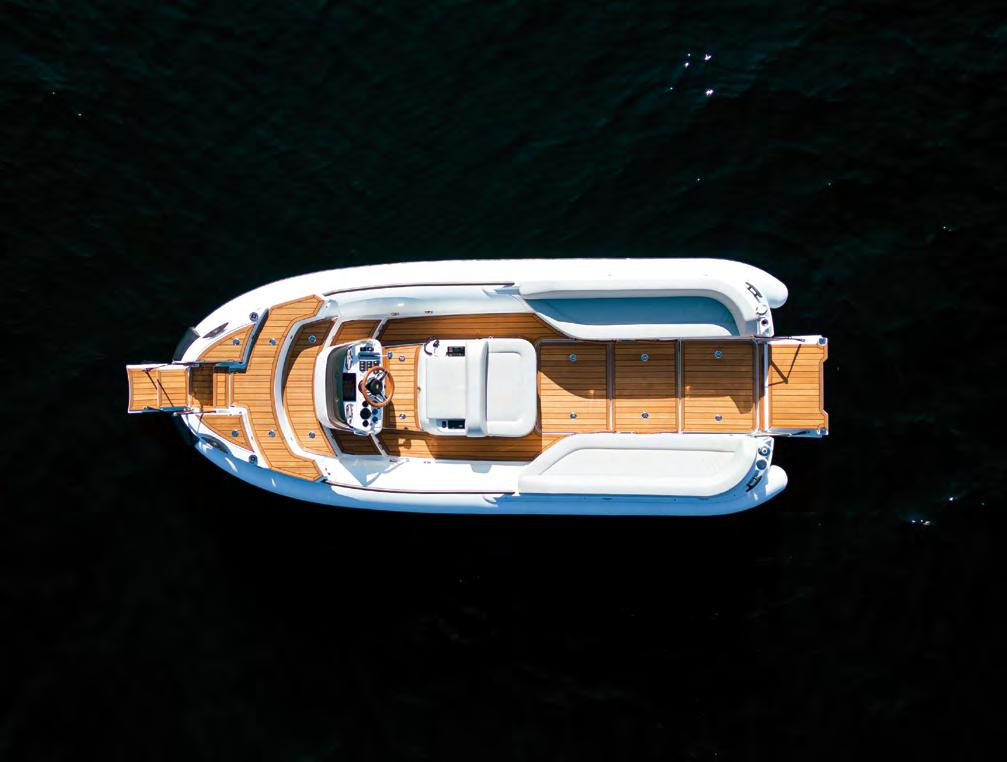
Castoldi presents the new Jet Tender 17, a completely redesigned tender aimed at raising the standards in the yacht tender segment. Measuring 5.20 meters in length, it combines modern lines with advanced functional solutions, including a stern hatch, generous cargo area, and a bow ramp for easy shore access. The Kevlar-laminated “gull-wing” hull ensures excellent lateral stability and a dry ride. Onboard, space optimization results in interior volumes above the category average. It is powered by a 170 hp diesel engine paired with the proven Castoldi Turbodrive 224 DA waterjet, offering precise maneuvering and safe operation in all conditions. Foldable and removable bow and stern canopies are available, providing effective protection in windy or rough sea conditions.
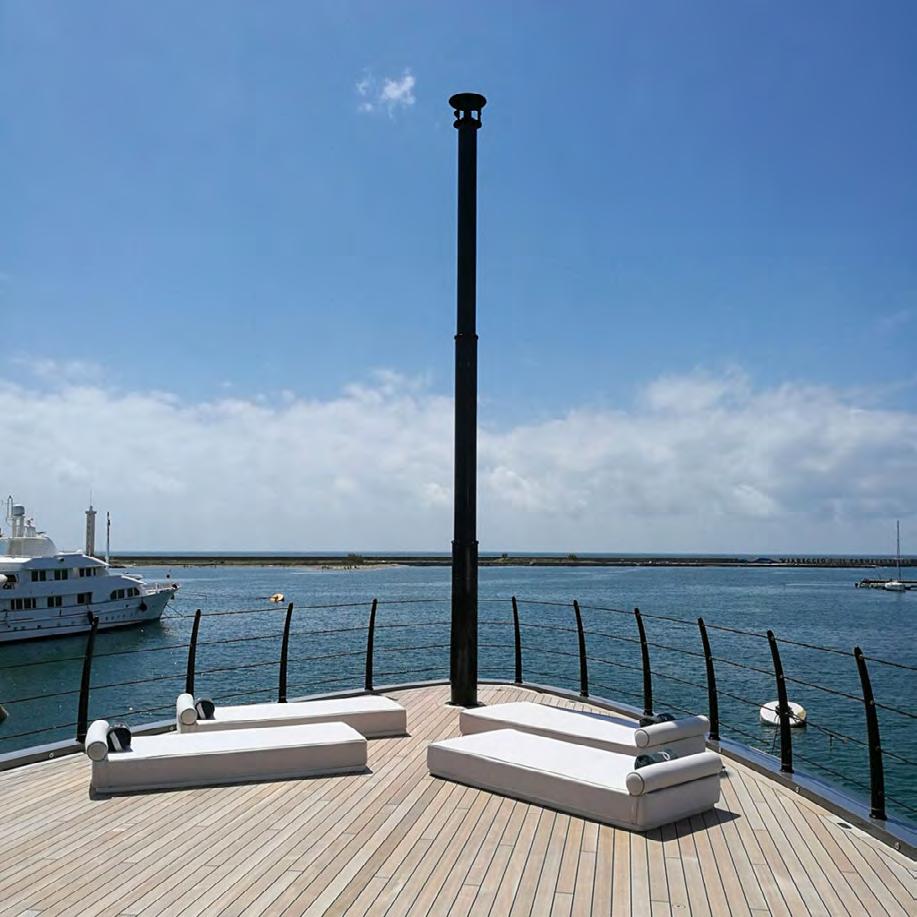
Novamarine B s 140 è più di un tender: 14,65 metri di lunghezza per 4,25 di larghezza su layout walkaround che massimizza gli spazi di coperta. a poppa, dinette trasformabile in salotto sull’acqua e scale integrate per accesso immediato al mare. a prua, area modulabile con tavolo a doppia funzione. s ottocoperta, il primo Black s hiver con cabina offre un divanoletto matrimoniale, altezze generose e illuminazione zenitale. Il pescaggio di 0,8 m consente accesso a fondali bassi e baie riservate. Nella versione fuoribordo monta tre m ercury Verado V12 da 600 cv, raggiungendo 57 nodi. personalizzabile in ogni dettaglio, ospita fino a 25 persone, con strutture e materiali progettati per navigare anche in condizioni difficili.
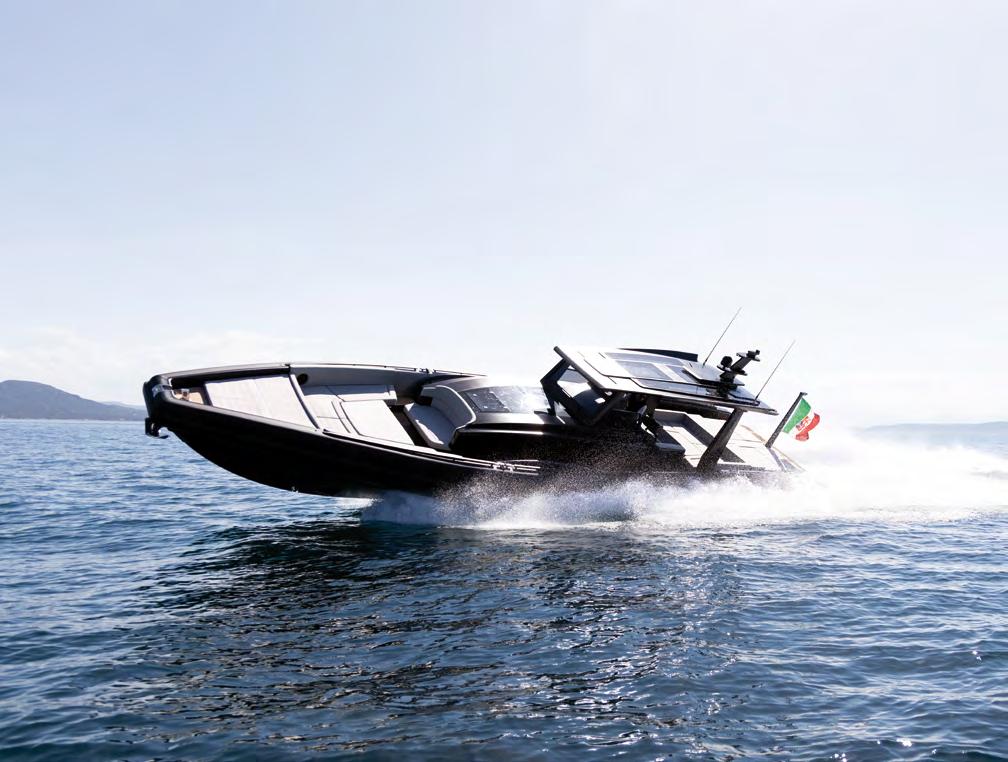
The Novamarine BS 140 is more than just a tender: at 14.65 meters long and 4.25 meters wide, it features a walkaround layout that maximizes deck space. At the stern, a convertible dinette transforms into a waterside lounge, with integrated steps for immediate sea access. Forward, a modular area includes a multifunctional table. Below deck, the first Black Shiver model with a cabin offers a double sofa-bed, generous headroom, and overhead lighting. With a draft of just 0.8 meters, it can access shallow waters and secluded bays. In the outboard version, it’s equipped with three 600 hp Mercury Verado V12 engines, reaching speeds of up to 57 knots. Fully customizable down to the smallest detail, it can accommodate up to 25 people, with structures and materials engineered for safe navigation even in challenging conditions.
Il nuovo a xopar 29 s un top adotta la carena twin-stepped con prua “sharp entry” a 22°, stampata in vetroresina con gelcoat vinyl-ester per contrastare l’osmosi. La motorizzazione spazia da 300 a 400 cv fuoribordo, raggiungendo velocità fino a 50 nodi; con un 350 hp, il consumo si attesta a 1,6 l/nm tra 24 e 34 nodi. s erbatoio fisso da 400 l e idrodinamica ottimizzata offrono +30 % di efficienza rispetto al modello precedente e autonomia di oltre 200 mg. La plancia è orientata al pilota, con dashboard essenziale, volante snelli, sedili pilota e copilota regolabili e girevoli, ottima ergonomia. La copertura s un top è un bimini rigido con pannello canvas scorrevole, gestito manualmente o elettricamente.
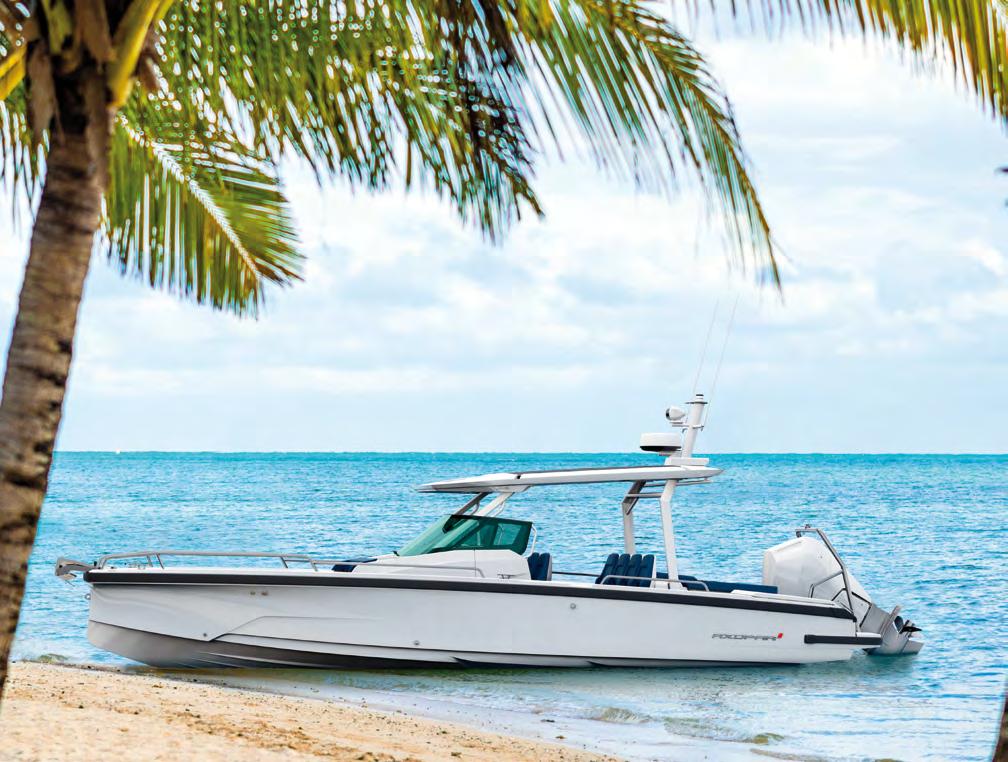
The new Axopar 29 Sun Top features a twin-stepped hull with a 22° sharp-entry bow, molded in fiberglass with vinyl-ester gelcoat to prevent osmosis. Outboard engine options range from 300 to 400 hp, enabling top speeds of up to 50 knots. With a 350 hp setup, fuel consumption averages 1.6 l/nm between 24 and 34 knots. A fixed 400-liter fuel tank and optimized hydrodynamics deliver over 30% greater efficiency compared to the previous model, with a range exceeding 200 nautical miles. The helm is driver-focused, featuring a clean dashboard layout, slim steering wheel, and adjustable, swiveling pilot and co-pilot seats for excellent ergonomics. The Sun Top cover is a rigid bimini with a sliding canvas panel, operable manually or electrically.
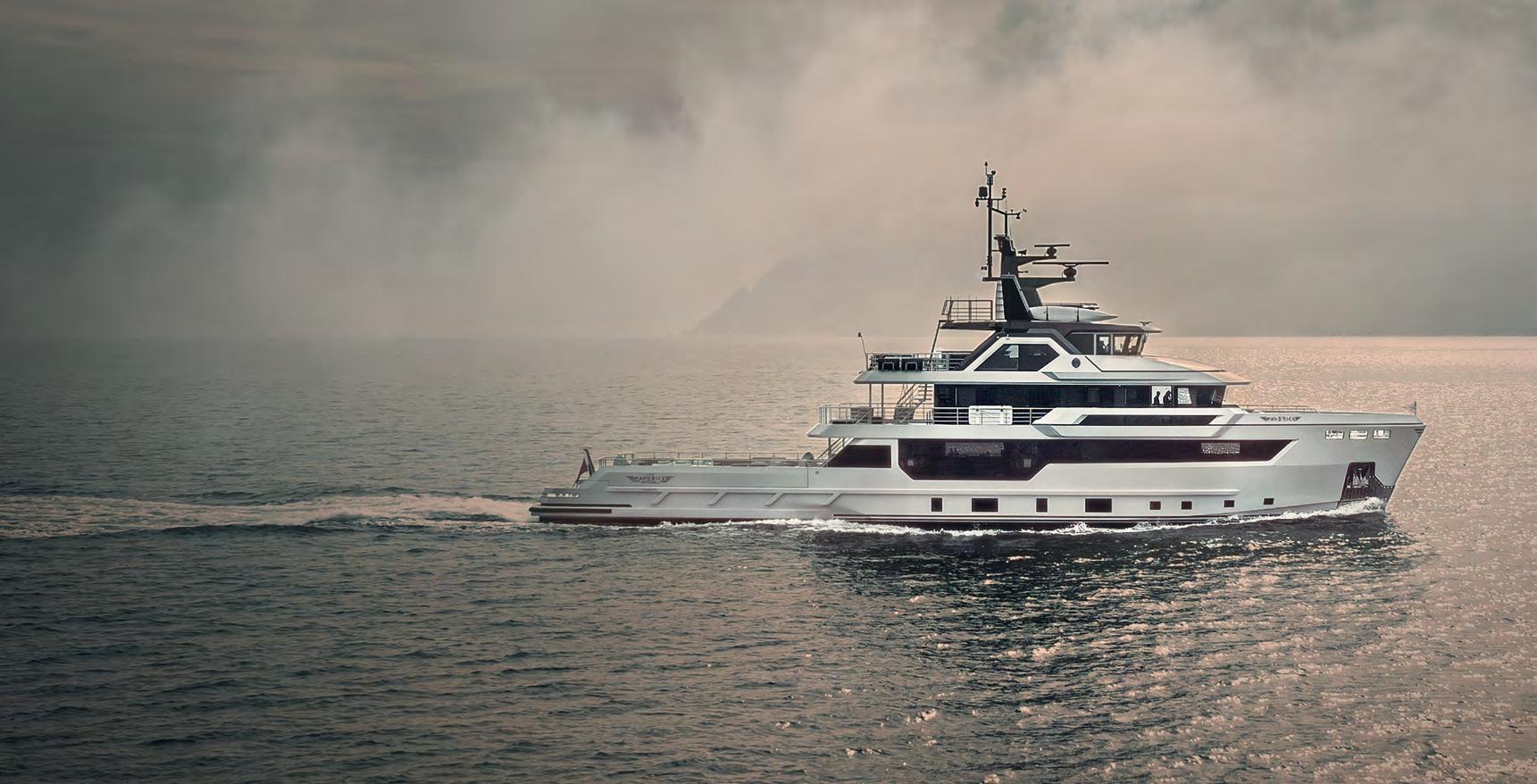
Frauscher 1212 Ghost a ir riprende le linee della sorella 1212 Ghost, integrando la filosofia a ir: grande coperta, dinamismo e spazi versatili. La postazione di guida è il fulcro funzionale, con accesso diretto a sottocoperta, dove 1,90 m d’altezza consentono di sfruttare zona notte per due e bagno con doccia. Il pozzetto ospita una cucina laterale, oltre a una dinette trasformabile in lounge o pista da ballo, grazie al tavolo regolabile e all’impianto JL audio premium. Il t-top in carbonio monolitico, senza pali, alleggerisce struttura e profilo. La carena a V profonda con due step garantisce stabilità e tenuta in mare formato. m otorizzabile con due m ercruiser 430 hp o Volvo D6-440 diesel, supera i 40 nodi.
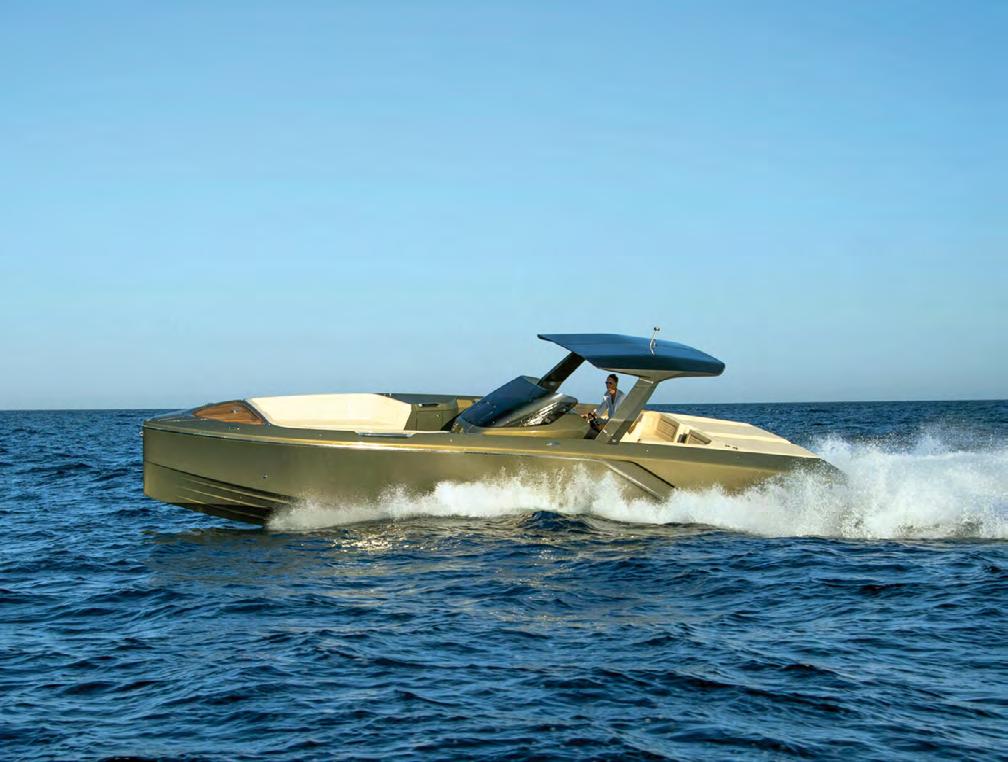
The Frauscher 1212 Ghost Air echoes the lines of its sister model, the 1212 Ghost, while embracing the Air philosophy: a spacious deck, dynamic performance, and versatile spaces. The helm station serves as the functional core, offering direct access below deck, where 1.90 meters of headroom allow for a sleeping area for two and a bathroom with shower. The cockpit features a side galley and a dinette that can transform into a lounge or even a dance floor, thanks to an adjustable table and a premium JL Audio sound system. The monolithic carbon T-Top, designed without support poles, lightens the structure and profile. The deep-V hull with dual steps ensures stability and grip even in rough seas. It can be powered by twin MerCruiser 430 hp engines or Volvo D6-440 diesels, exceeding 40 knots in top speed.

Nimbus t 11 è un walkaround puro, ideale per uscite giornaliere, crociere di breve durata o trasferimenti a terra. t, infatti, sta per tender. può trasportare fino a 12 persone offrendo a tutti la possibilità di sedersi in direzione di marcia durante le trasferte. La grande lounge di poppa è configurabile con divani e tavoli mobili, convertibile area pranzo o zona relax. La cucina esterna offre la possibilità di montare un grill o un fornello. s ottocoperta trovano posto due cabine doppie e un bagno completo con doccia. Così come molte barche scandinave, tiene perfettamente il mare, ma lo fa con una sicurezza e con un’eleganza che colpiscono. Ottimi i materiali utilizzati a bordo e la qualità costruttiva.
www.nimBusBoAts.Com
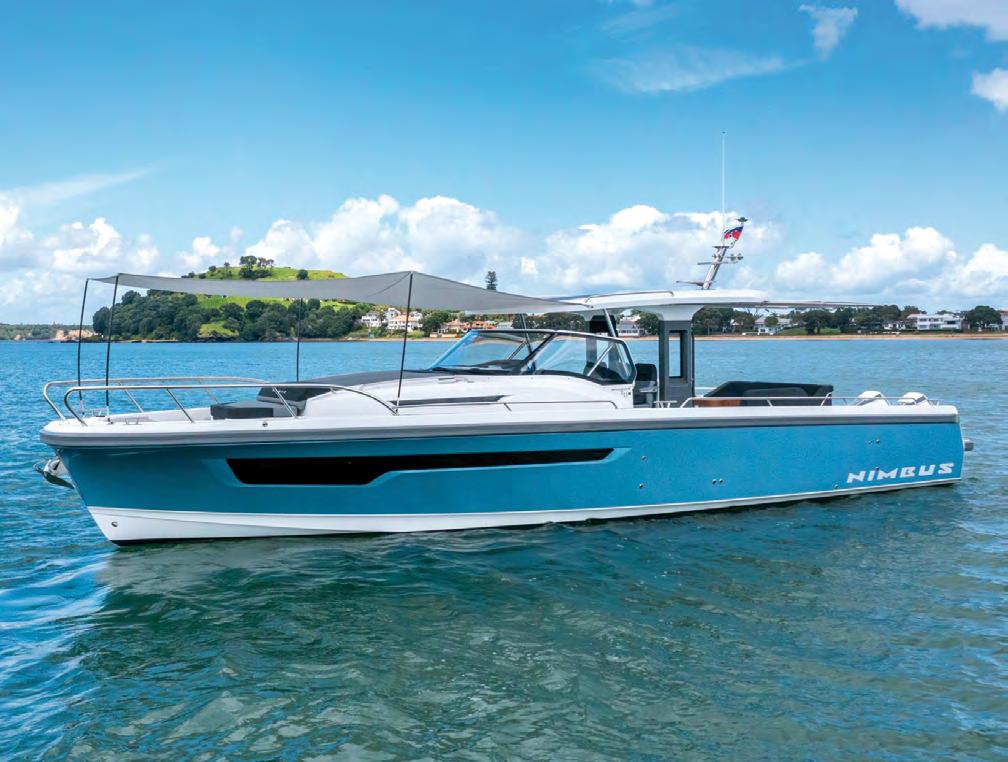
The Nimbus T11 is a true walkaround, ideal for day trips, short cruises, or shore transfers. The “T” stands for tender, highlighting its versatility. It can carry up to 12 passengers, with all guests able to sit facing forward during travel. The large aft lounge is highly configurable, with movable sofas and tables that convert the space into a dining or relaxation area. The outdoor galley can be fitted with a grill or stove for added convenience. Below deck, there are two double cabins and a full bathroom with a shower. Like many Scandinavian boats, it handles the sea exceptionally well—combining safety with a striking sense of elegance. High-quality materials and excellent craftsmanship complete the package.
Debutterà ai saloni di Cannes e Genova il nuovo u niko Cabin 34, evoluzione cabinata del modello Fish già visto a Düsseldorf. p rogettato da paolo s avoca e costruito da BFF Yachts a Catania, il battello misura 10,40 m (9,99 m omologazione) per 3 m di larghezza ed è realizzato in vinilestere. Oltre alle sue murate abbattibili, offre fiancate laterali apribili con scaletta bagno e doccetta integrate. a bordo, cabina doppia con toilette separata e prendisole a prua. a poppa, zona modulabile con dinette trasformabile, mobile cucina e grill opzionale. s oluzioni tecniche pensate per rendere questo 34 piedi un battello polivalente, adatto sia alla crociera che all’uso di servizio per superyacht.
www.BFFYACHts.Com
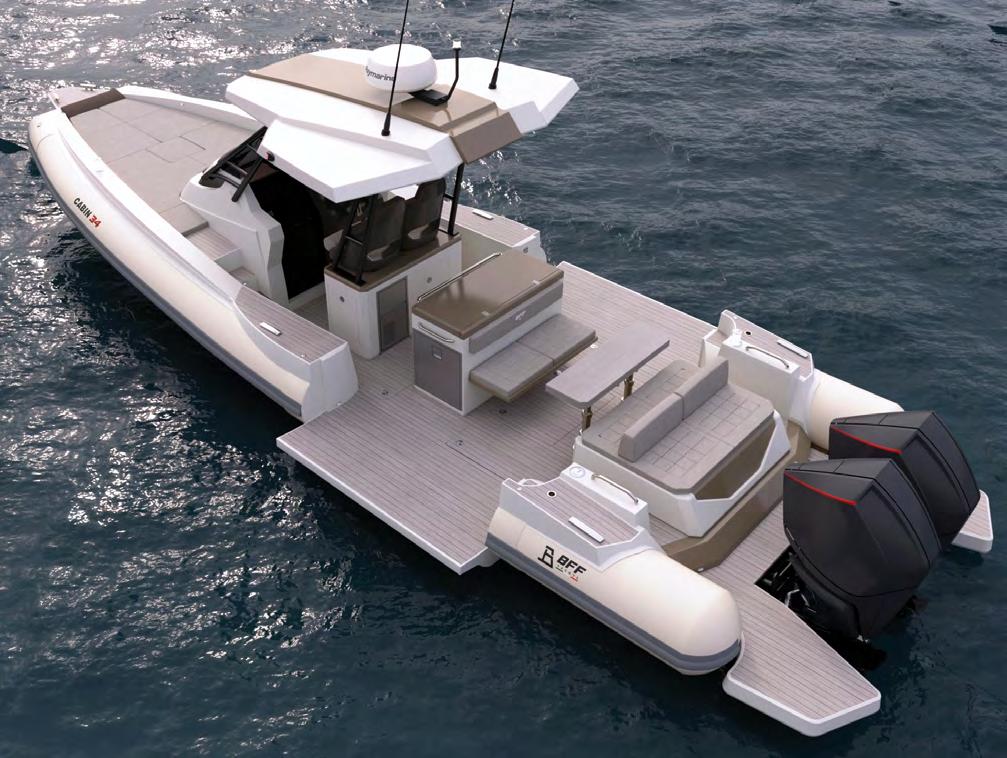
Set to debut at the Cannes and Genoa boat shows, the new Uniko Cabin 34 is the cabin-equipped evolution of the Fish model previously unveiled in Düsseldorf. Designed by Paolo Savoca and built by BFF Yachts in Catania, the vessel measures 10.40 meters in length (9.99 meters certified) with a beam of 3 meters, and is constructed using vinylester resin. In addition to its drop-down bulwarks, it features side openings with integrated swim ladder and shower. Onboard amenities include a double cabin with a separate bathroom and a bow sunbathing area. At the stern, a modular layout includes a convertible dinette, kitchenette, and optional grill. Technical solutions throughout are aimed at making this 34-footer a highly versatile craft—ideal for both cruising and superyacht tender duties.
Disegnato dal progettista italiano m ichele m olino, Limo 7 è un tender molto particolare sviluppato appositamente per il “suo” superyacht. tra i vincoli da rispettare in fase di progetto, dimensioni e peso hanno infatti determinato le sue principali caratteristiche tecniche. Il tender doveva avere, al massimo, una lunghezza di 7 metri e un peso di 2 tonnellate e visto che sul mercato non c’era nulla di simile è stato progettato un mezzo apposito. Ne esistono due versioni, una open e la seconda chiusa (una per lato del superyacht) che riprende lo stile delle auto – Bentley – del suo armatore. tra i punti di forza di Limo 7 anche l’ancora a scomparsa nello scafo, il paramare apribile per agevolare l’accesso a bordo e al mare e l’elica di prua.
www.tRimARine.Com
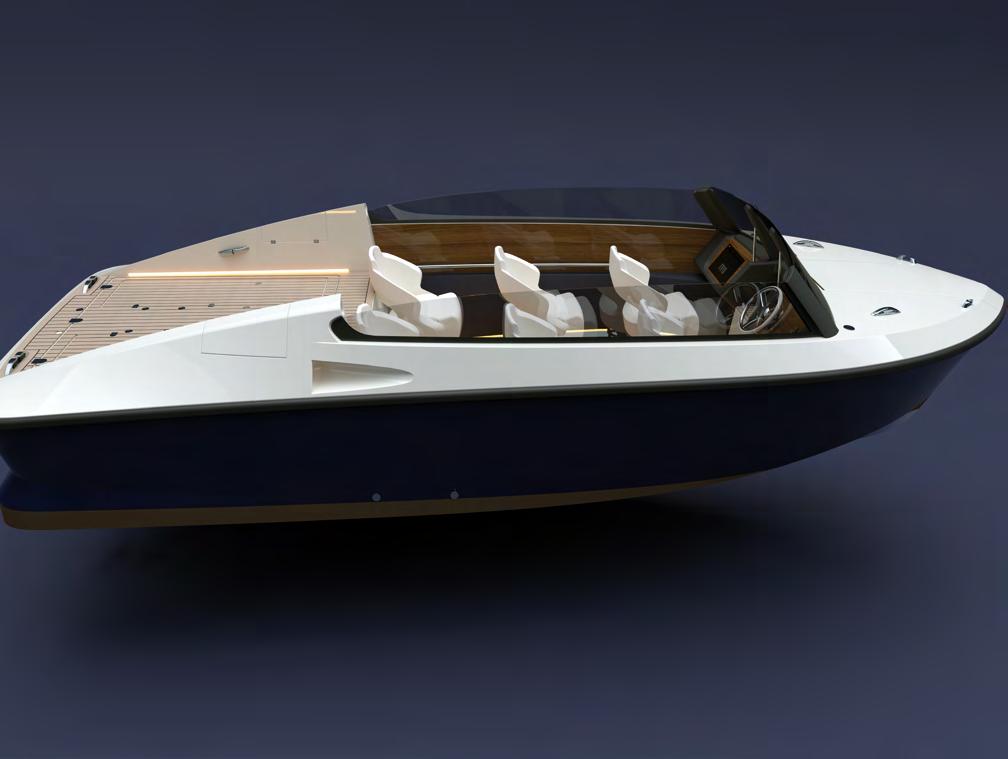
Designed by Italian naval architect Michele Molino, the Limo 7 is a highly distinctive tender developed specifically for “its” superyacht. During the design phase, strict requirements on size and weight defined its main technical characteristics: the tender had to be no longer than 7 meters and weigh no more than 2 tons. Since no existing model on the market met these criteria, a bespoke solution was created. Two versions exist—an open model and a closed one (one for each side of the superyacht)—with the closed variant reflecting the style of the owner’s favorite cars, namely Bentleys. Key features of the Limo 7 include a retractable anchor integrated into the hull, a foldable spray deflector to ease access both onboard and to the water, and a bow thruster for improved maneuverability.
Goodyear fa il suo ingresso nella nautica di lusso con il nuovo Goodyear Carbon 35, un rib sportivo firmato Gtender. Lungo 10,60 metri e largo 3,95, è omologato per 24 persone e monta due Yamaha Xto da 450 cv con sistema Helm master wireless. La struttura è in vetroresina e carbonio, con t-top integrato e calpestio antiscivolo in eva. Il layout offre ampi prendisole, console centrale ergonomica e una cabina con bagno. a poppa due plancette con scalette di risalita, frigoriferi, lavello e mobile stand-up. a prua prendisole trasformabile con tavolo telescopico e verricello elettrico con telecamera. I materiali sono di alto livello: hard top e sedili in carbonio evolution tech Lab, tappezzerie curate da atelier Zanasi. Il debutto sarà al salone di Genova 2025.
www.G-tendeR Com
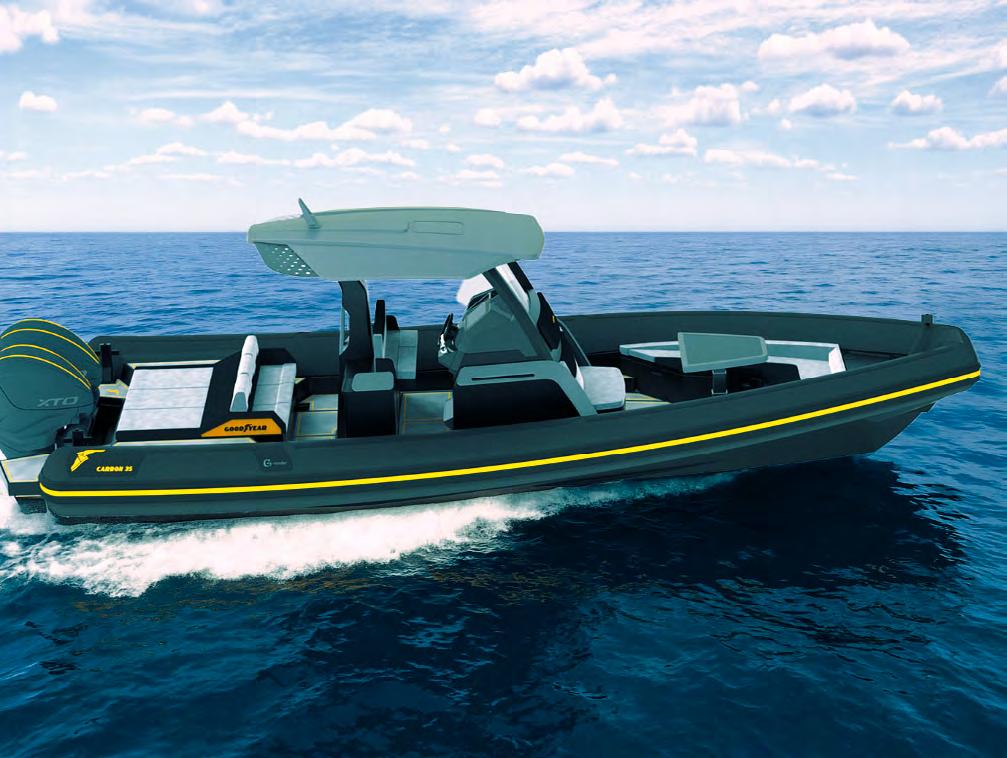
Goodyear makes its entry into luxury boating with the new Goodyear Carbon 35, a sporty rib by G-Tender. At 10.60 metres long and 3.95 metres wide, it is homologated for 24 people and is fitted with two 450 hp Yamaha Xtos with wireless Helm Master system. The structure is made of fibreglass and carbon fibre, with an integrated T-Top and non-slip Eva decking. The layout offers spacious sundecks, an ergonomic centre console and a cabin with bathroom. At the stern, two swim platforms with climbing ladders, refrigerators, sink and stand-up cabinet. At the bow convertible sundeck with telescopic table and electric winch with camera. The materials are of the highest level: Evolution Tech Lab hard top and carbon seats, upholstery by Atelier Zanasi. The debut will be at the Genoa Boat Show 2025.
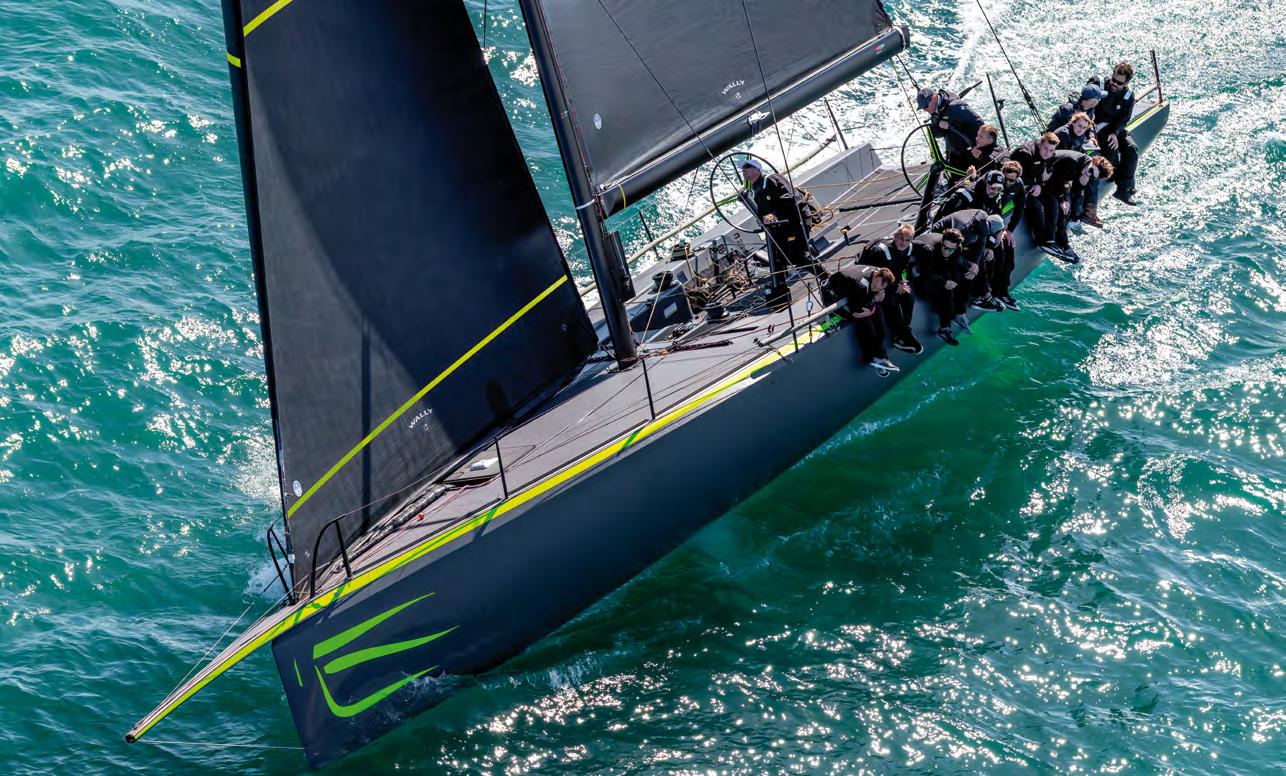
dEl cantiErE,
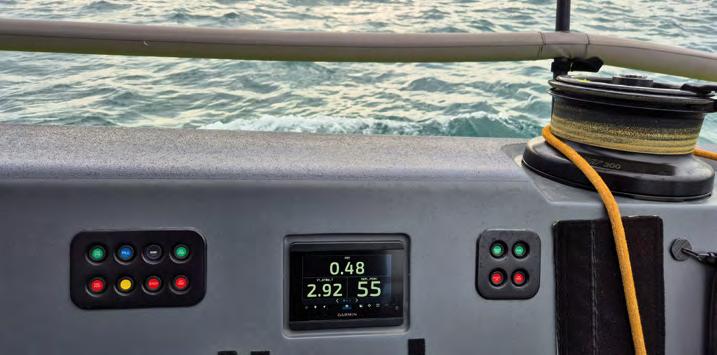
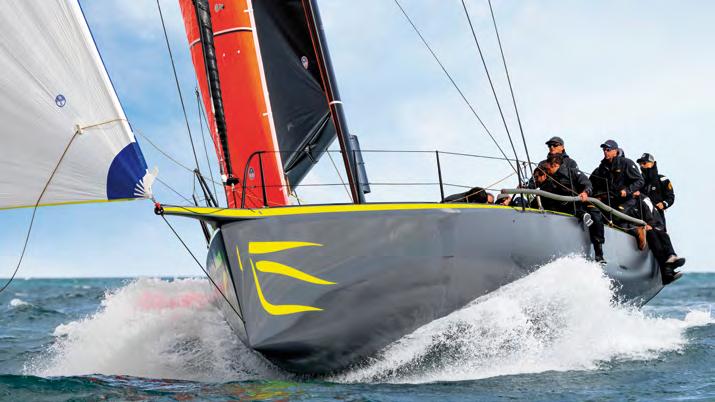
PEr rEGatE irc/orc E onE dEsiGn disEGnata da Botin PartnErs. il 51 Ha Già dEButtato vincEndo il caMPionato nazionalE orc dEl tirrEno cEntralE E MEridionalE the test oF the shiPYard’s new racer, a Boat desiGned BY Botin Partners For irc/orc and one desiGn racinG the 51 has alreadY Made its deBut BY winninG the orc national chaMPionshiP oF central and southern tYrrhenian sea
Gli strumenti all’albero segnano 11,2 nodi di velocità e 11,4 di vento reale con randa e gennaker. I due valori vanno a braccetto in tutte le condizioni e spesso la velocità della barca supera quella del vento. Il timone è reattivo e gli angoli di bolina sono da racer puro. La barca in questione è il nuovissimo wallyrocket51, scafo n°1, su cui super YaCHt 24 è salito per i primi test in mare a Valencia, in spagna. a bordo un equipaggio d’eccezione, che comprende Luca Bassani, fondatore e chief designer di Wally (oggi brand di Ferretti Group), lo skipper Vasco Vascotto e il tattico argentino Guillermo parada. Facile andare forte quando si è seguiti da velisti del genere, ma serve anche il mezzo giusto. ed è proprio durante il test, che Luca Bassani racconta l’idea di come è nato questo modello dedicato al mondo delle regate Orc/Irc e One Design con la formula dell’armatore-timoniere. un progetto sviluppato con la collaborazione dello studio Botin partners, conosciuto per l’esperienza in america’s Cup e per i successi nelle classi fra i 50’ e 100’.
Con una lunghezza di 15,5 metri, wallyrocket51 si distingue per un dislocamento ultraleggero di 6,3 tonnellate e uno scafo di carbonio dotato di due water ballast da 600 litri per migliorare stabilità e performance. “Wally è nata per dare all’armatore una barca con cui divertirsi e vincere in regata –racconta Luca Bassani tra una virata
e l’altra – ma che fosse comoda anche in crociera, il perfetto cruiser/racer. poi con il tempo è successo che le imbarcazioni sono diventate sempre più tirate e si sono trasformate in racer/cruiser e proprio per questo in molti si sono allontanati dalle regate, perché diventavano troppo impegnative. Questo ha creato una separazione non risolvibile tra chi vuole una barca da crociera veloce ma non per le regate e chi vuole invece competere ai massimi livelli. Il recente wally100 Galma è un grande salto in avanti nel mondo della crociera e ci ha spinto a non abbandonare il mondo delle regate. L’obiettivo era realizzare una barca più veloce dell’ottimo tp52 e creare una classe One Design per evitare che ogni anno ci sia un modello nuovo e più forte che rende obsoleti tutti gli altri. La barca ha anche costi di gestione inferiori anche grazie all’equipaggio di 11 persone invece che di 15. Inoltre, una volta formata la classe si potrà decidere, ad esempio, di sostituire le colonnine dei winch con verricelli idraulici o elettrici per regatare anche in 8 persone”. secondo Bassani la versione elettrificata “sarà perfetta anche per quegli armatori che hanno già uno yacht a motore e cercano una barca vela per fare 2/3 ore di vela durante il giorno divertendosi. Basta un equipaggio di tre persone e 15/20 nodi di vento per planare con solo randa e fiocco e divertirsi come matti. se invece ci sarà poca aria come è successo nella no-
The instruments on the mast show 11.2 knots of boat speed and 11.4 knots of true wind with the mainsail and gennaker up. The two values go hand in hand in all conditions, and the boat speed often exceeds the wind speed. The helm is responsive, and the upwind angles are those of a pure racer. The boat in question is the brandnew wallyrocket51, hull No. 1, which SuPER yACHT 24 boarded for the first sea trials in Valencia, Spain. On board was an exceptional crew, including luca Bassani, founder and chief designer of Wally (now a brand of the Ferretti Group), skipper Vasco Vascotto, and Argentine tactician Guillermo Parada. It’s easy to go fast with sailors of this caliber on board, but the right boat is just as important. And it was during the test that luca Bassani shared the story behind the creation of this model, designed for ORC/ IRC and One Design racing with an owner-driver formula. The project was developed in collaboration with the design studio Botin Partners, renowned for its America’s Cup experience and success in classes ranging from 50 to 100 feet.
“Wally was created to give owners a boat they could enjoy and win races with - says luca Bassani between tacks - but one that would also be comfortable for cruising-a true cruiser/racer. Over time, however, boats became more and more extreme and shifted into racer/
cruiser territory, which led many people to step away from racing because it became too demanding. This created a clear divide between those who want a fast cruising boat but don’t race, and those who want to compete at the highest level”.
“The recent wally100 Galma marked a big leap forward in the cruising world and reminded us not to abandon the racing scene - he continues - Our goal was to build a boat faster than the excellent TP52 and to create a One Design class to avoid the yearly arms race of newer, better models that quickly render others obsolete. The wallyrocket51 also has lower running costs, partly thanks to a crew of 11 instead of 15. And once the class is established, we could consider switching from pedestal winches to hydraulic or electric winches to allow racing with just eight crew”.
According to Bassani, the electrified version “will also be perfect for owners who already have a motor yacht and are looking for a fun sailing boat to enjoy a couple of hours under sail during the day. All you need is a three-person crew and 15–20 knots of wind to start planing with just the mainsail and jib-it’s a blast. And if there’s light wind, like we had during our test, you still have fun because the boat easily hits eight knots in six knots of breeze.
The comparison I always make is to a Formula 1 car you could also
alBErto Mariotti


stra prova ti diverti lo stesso perché la barca fa comunque otto nodi con sei di vento. Il paragone che faccio sempre è quello di una Formula 1 che nel weekend può andare anche in strada. L’idea è provare anche ad allargare un po’ il mercato per far tornare la passione per la vela, che negli ultimi 15 anni è calata in modo deciso”. Non capita spesso di navigare insieme a campioni di questo calibro (Vascotto nella sua carriera ha vinto 28 mondiali senza contare le esperienze in Coppa e molte altre regate) e timonare un mezzo così veloce e reattivo è adrenalina pura, ma anche molto diverso da qualsiasi altra barca. Il tattico chiama le virate e gli occhi sono fissi sugli strumenti del vento: uno o due gradi in più o in meno fanno la differenza. Notevoli la capacità
di stringere il vento e il feeling al timone che fanno apprezzare ancora di più le qualità di questo racer. Lo scafo è stato realizzato con la collaborazione di pure Design & engineering ed è costruito in carbonio pre-preg con anima in Corecell e Nomex. Il piano velico sfrutta un albero southern spars con sartiame in carbonio aerOsix di Future Fibres e arriva a una superficie velica di 160 mq di bolina che diventano 360 alle andature portanti grazie al gennaker da 265 mq. tra i punti di forza della barca ci sono i water ballast, un sistema idraulico a comando elettrico e un pacco batterie, soluzioni che saranno probabilmente adottate per la futura classe one-design, con l’obiettivo di rendere la barca il più accessibile possibile ai suoi armatori. Il sistema di water ballast permette di riempire i serbatoi in un minuto e di far passare l’acqua da un lato all’altro in appena 6/7 secondi durante la virata. Il fatto di potere rimuovere i verricelli idraulici e il pacco batterie sostituendoli con un pedestal manuale per azionare i verricelli Harken air, permette al wallyrocket51 di competere nelle regate Irc e Orc senza penalizzazioni di rating. Il wallyrocket51 ha debuttato in regata in occasione del Campionato nazionale Orc del tirreno centrale e meridionale che ha dominato con tre vittorie su quattro prove e il primo posto assoluto in classifica generale.
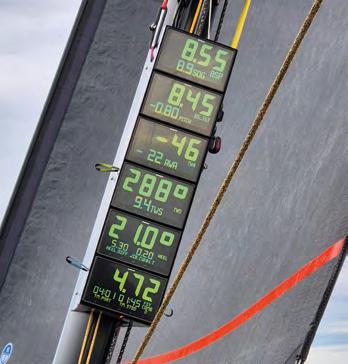
lungHEzz A F T | lEngHT o.A 15,50 M
lungHEzz A | bEAM 4,30 M
PESCAggio | dRAFT 3,50 M
diSloCAMEnTo | diSPl ACEMEnT 6.500 kg
PRogETTo | PRojECT boTin PARTnERS
PuRE dESign & EnginEERing
PiAno vEliCo| SAIl Pl AN
RAndA | MAinSAil Mq 98
FioCCo | jib Mq 69
gEnnAkER Mq 265

Condizioni dEll A PRovA
CONDITIONS ON TEST
METEo | WEATHER
luogo | Pl ACE vAlEnCiA (SPA)
Condizioni | CondiTionS
ACquA PiATTA | Fl AT wATER
vEnTo | wind 8/11 kTS
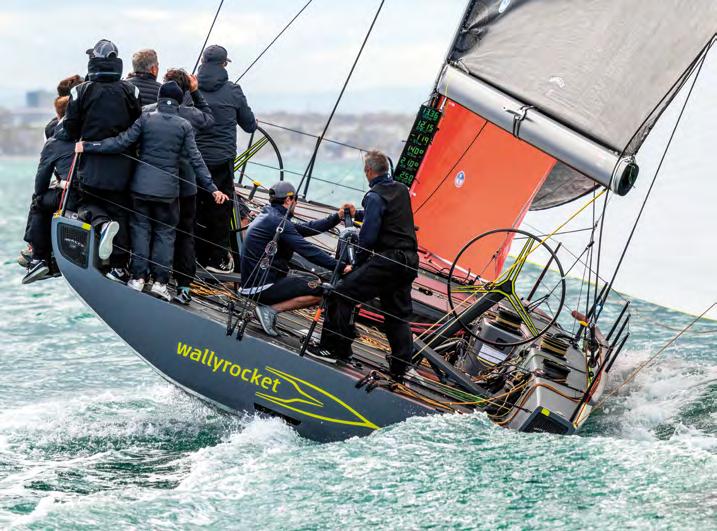
take on the road for the weekend. The idea is to try and broaden the market a little and reignite the passion for sailing, which has declined significantly over the last 15 years”. It’s not every day you get to sail alongside champions of this caliberVascotto, for example, has won 28 world championships over his career, not to mention his America’s Cup campaigns and countless other races. Steering such a fast and responsive boat is pure adrenaline, but it’s also a very different experience from any other boat. The tactician calls the tacks, and everyone’s eyes are glued to the wind instruments-just one or two degrees more or less can make all the difference. The boat’s ability to point high into the wind is impressive, as is the feel at the helm, which really highlights the strengths of this racer.
The hull was built in collaboration with Pure Design & Engineering and is constructed using pre-preg carbon with a Corecell and Nomex core. The sail plan features a Southern Spars mast with AEROsix
[ ] PRESTA zioni | PERFORMANCE
tWs Velocità barca angolo Vele true wind Boat speed vento sails
maIN/JIB
raNDa/FIOCCO maIN/JIB
raNDa/FIOCCO maIN/JIB
maIN/JIB
maIN/JIB
raNDa/GeNNaKer maIN/GeNNaKer
raNDa/GeNNaKer maIN/GeNNaKer
raNDa/GeNNaKer maIN/GeNNaKer
raNDa/GeNNaKer maIN/GeNNaKer
raNDa/GeNNaKer maIN/GeNNaKer
carbon rigging from Future Fibres, delivering 160 square meters of upwind sail area, which increases to 360 square meters downwind thanks to the 265-square-meter gennaker. Among the boat’s standout features are the water ballast system, an electrically controlled hydraulic system, and a battery pack-solutions likely to be adopted for the future one-design class, with the goal of making the boat as accessible as possible to owners. The water ballast system can fill the tanks in one minute and transfer water from one side to the other in just 6–7 seconds during a tack. The option to remove the hydraulic winches and battery pack and replace them with a manual pedestal to operate the Harken Air winches allows the wallyrocket51 to compete in IRC and ORC races without rating penalties. The wallyrocket51 made its racing debut at the ORC National Championship for the Central and Southern Tyrrhenian Sea, where it dominated the competition with three wins out of four races and took first place overall.
SCHEdA TECniCA TECHNICAl DATA


CAnTiERE | SHIPyARD wAllY, FERRETTi gRouP, HTTPS://www.wAllY CoM/iT-iT/
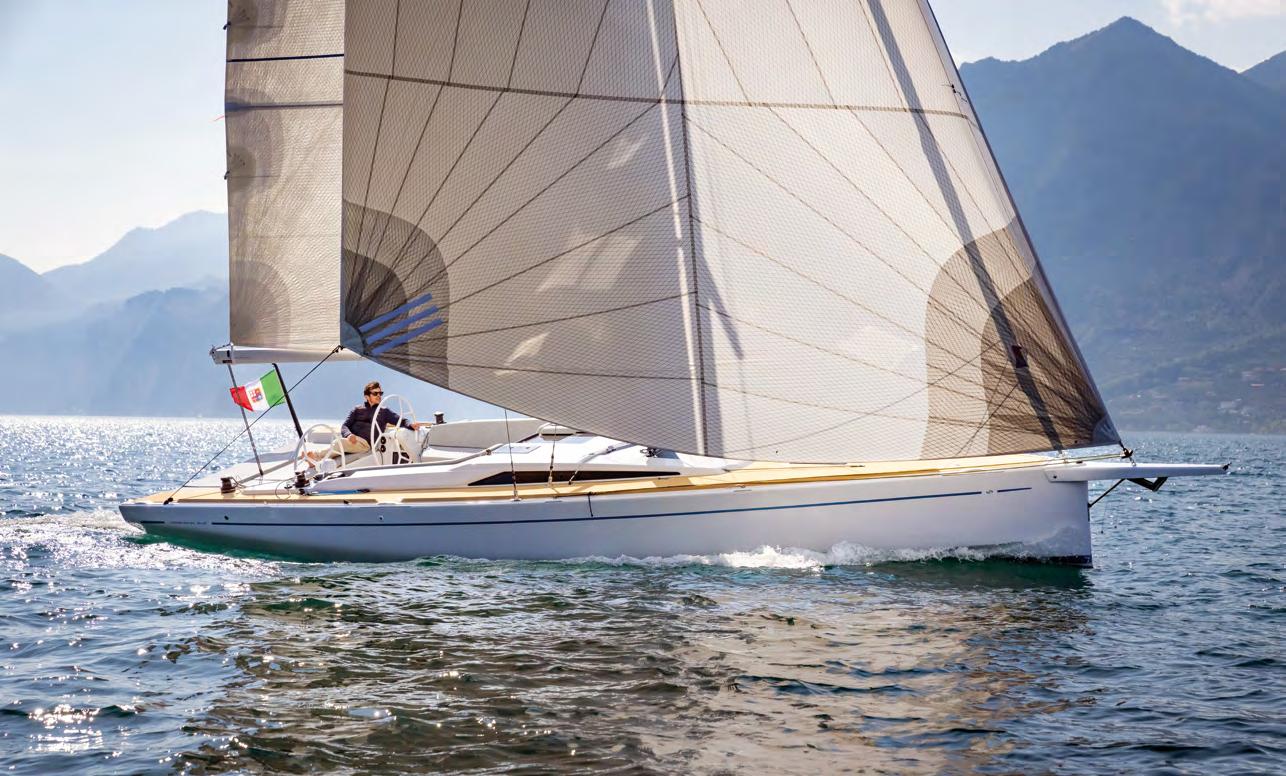
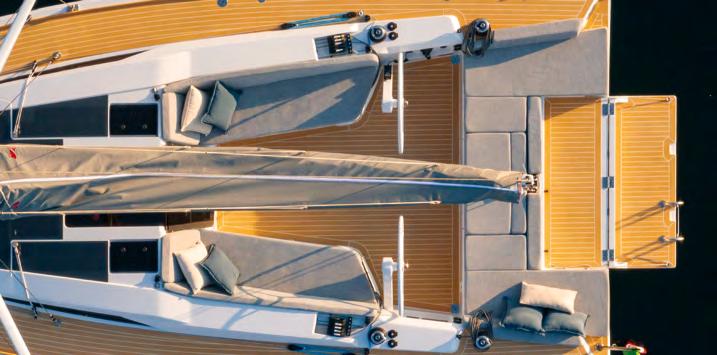
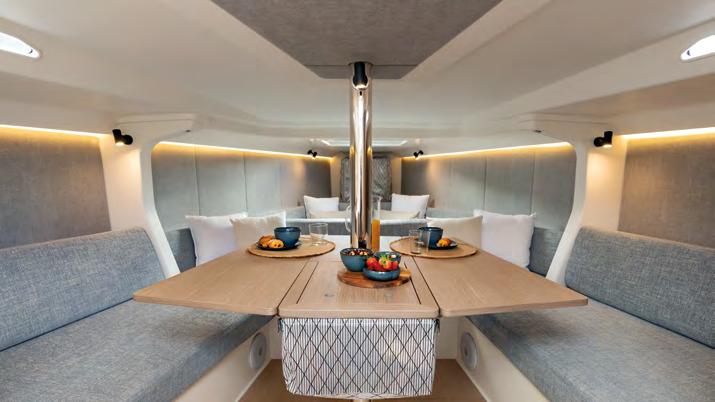
PEr EssErE riciclaBilE a FinE vita. la Prova di suPEr yacHt 24 a MalcEsinE, sul laGo di Garda hull lenGth oF 9.99 Metres, electric Motor and construction with therMoPlastic resin to Be recYclaBle at the end oF its liFe. the suPer Yacht 24 test at Malcesine on l ake Garda
super YaCH t 24 ha navigato con il Grand s oleil Blue, il primo weekender/daysailer di Cantiere del pardo. La barca è firmata da matteo polli, Nauta Design e NlComp, la startup italiana che ha collaborato alla sua costruzione dello scafo riciclabile. Il Blue ha una lunghezza di 9,99 metri e una larghezza massima di 3,70 metri, vista dalla banchina fa impressione, sembra molto più grande di quanto lo sia in realtà. e anche in navigazione somiglia più a un maxi che a un natante. Il Blue si aggiunge alle gamma performance e Long Cruise diventando di fatto una terza linea, con l’idea di un mezzo facile e pronto all’uso da tenere in banchina per divertirsi nell’arco di uno o due giorni di navigazione costiera o, come nel caso del test a malcesine, sul lago. ma il Blue non è solo un natante o un daysailer, ma un progetto speciale che porta con sé una discreta dose d’innovazione, tanto nella costruzione quanto nella progettazione.
La barca viene definita riciclabile. perché? Cosa la rende più e meglio riciclabile delle altre? s ono due gli aspetti principali: la progettazione e la costruzione. partiamo da quest’ultima. s cafo e coperta sono costruiti con normali fibre di vetro, un’anima in rcy atlas (che contiene una percentuale di materiale riciclato) e il tutto è infuso con una resina di tipo termoplastico e non termoindurente, come si
usa nella costruzione tradizionale. La resina termoplastica è la e lium prodotta dall’azienda francese a rkema e al contrario della termoindurente può tornare al suo stato orginale, liquido. a fine vita lo scafo viene smantellato, fatto a pezzi e tramite un processo chimico chiamato pirolisi è possibile separare le fibre di vetro dalla resina. m entre la resina può essere riutilizzata per costruire un’altra barca, le fibre di vetroresina, che sono state tranciate e quindi sono corte, tornano utili per costruire componenti di vario genere dalle dimensioni minori (non lo scafo, che richiede invece fibre lunghe).
La tecnologia è stata sviluppata, sperimentata e applicata da NlComp che in passato l’ha sperimentata per il suo ecoracer 25, il prototipo da regata che per primo ha visto l’utilizzo della resina termoplastica, in quel caso accoppiata a fibre di lino, un materiale naturale più sostenibile. La resina termoplastica funziona anche con fibra di vetro e carbonio, più adatte alla costruzione di imbarcazioni dalle dimensioni maggiori. Inoltre, le caratteristiche meccaniche di questa resina hanno richiesto l’utilizzo del processo di infusione al posto della tradizionale laminazione a mano che usa il cantiere sugli altri modelli. La barca ha un dislocamento a secco di 3.500 kg, quella su cui navighiamo raggiunge i 4.200 kg (è ben accessoriata con quattro winch elettrici Harken
SuPER yACHT 24 sailed with the Grand Soleil Blue, the first weekender/daysailer from Cantiere del Pardo. The boat is designed by Matteo Polli, Nauta Design and NlComp, the Italian startup that collaborated on the construction of the recyclable hull. The Blue is 9.99 meters long and has a maximum width of 3.70 meters, seen from the dock it is impressive, it seems much larger than it actually is. And even when sailing it looks more like a maxi than a vessel. The Blue joins the Performance and long Cruise ranges, effectively becoming a third line, with the idea of an easy and readyto-use boat to keep on the dock for fun over the course of a day or two of coastal navigation or, as in the case of the test in Malcesine, on the lake. But the Blue is not just a vessel or a daysailer, but a special project that brings with it a fair amount of innovation, both in construction and design.
The boat is defined as recyclable. Why? What makes it more and better recyclable than others? There are two main aspects: the design and the construction. let’s start with the latter. The hull and deck are built with normal glass fibers, a core in rcyAtlas (which contains a percentage of recycled material) and the whole thing is infused with a thermoplastic resin and not a thermosetting one, as is used in traditional construction. The thermoplastic resin is Elium produced by the French company Arkema
and unlike the thermosetting one it can return to its original, liquid state. At the end of its life the hull is dismantled, broken into pieces and through a chemical process called pyrolysis it is possible to separate the glass fibers from the resin. While the resin can be reused to build another boat, the fiberglass fibers, which have been cut and are therefore short, are useful for building various smaller components (not the hull, which instead requires long fibers).
The technology was developed, tested and applied by NlComp , which in the past tested it for its Ecoracer 25, the racing prototype that first saw the use of thermoplastic resin, in that case coupled with flax fibers, a more sustainable natural material.
Thermoplastic resin also works with glass and carbon fibers, more suitable for the construction of larger boats. Furthermore, the mechanical characteristics of this resin required the use of the infusion process instead of the traditional hand lamination that the shipyard uses on other models. The boat has a dry displacement of 3,500 kg, the one we are sailing on reaches 4,200 kg (it is well equipped with four Harken electric winches and synthetic teak) with a weight surplus due to the type of construction calculated at about 5% compared to a standard process.
The idea of a more manageable end of life is also found in the design approach defined as “design for disassembly”, which allows for
alBErto Mariotti


e teak sintetico) con un surplus di peso dovuto al tipo di costruzione calcolato in circa il 5% rispetto ad un processo standard.
L’idea di un fine vita più gestibile si ritrova anche nell’approccio progettuale definito come “design for disassembly”, che consente di separare più facilmente gli accessori e i componenti dell’imbarcazione, in modo simile alle pratiche dell’industria automobilistica. Questo processo garantisce che ogni parte possa essere smontata e riciclata con il processo visto prima. La barca monta inoltre un motore elettrico da 6 kW con trasmissione diretta pod drive di e- p ropulsion con pacco batterie da 8 kW a 48V e sistema fotovoltaico s olbian con una potenza di circa 340
W integrato nella tuga, calpestabile e dotato di finitura antisdrucciolo. L’impianto ricarica non solo le batterie del motore, ma può trasferire l’energia in eccesso a quelle dedicate ai servizi di bordo. Inoltre, in navigazione grazie all’idrogenerazione il motore elettrico consente di ricaricare le batterie permettendo una ricarica minima di 250 W già a una velocità di circa 6 nodi.
Gli interni hanno un’altezza di circa 1,40 metri, non si può quindi stare in piedi ma offrono spazio per quattro persone, una cucina con ghiacciaia e un bagno. La cuccetta a V di prua può essere trasformata in zona divano grazie a una coppia di elementi poggiaschiena. Il vento sul lago di Garda è una certezza e dopo pranzo si alza l’Ora che soffia da sud toccando punte di 17/19 nodi, condizioni perfette che esaltano la carena disegnata da matteo polli. La barca in prova è attrezzata con albero s elden senza paterazzo e vele One s ails in 4 t Forte, anche queste realizzate con materiali termoplastici: colle, resine e solventi tradizionalmente utilizzati nel processo di fabbricazione sono stati sostituiti da un processo di fusione a caldo, mentre il polimero di base è riciclabile al 100% attraverso i normali processi di smaltimento della raccolta differenziata. Il modello in prova ha una chiglia di 2,20 metri di profondità con lama in scatolato d’acciaio rivestito in vetroresina e siluro in piombo mentre è in fase di studio una versione meno profonda e leggermente più pesante. La barca è divertente e reattiva, con il gennaker fissa la velocità massima di giornata a 10,5 nodi sotto una bella raffica con il gennaker. Di bolina, a barca sbandata, si sente l’esigenza di un puntapiedi per il timoniere.
dATi | SPECIFICATIONS
lungHEzz A F T | lEngHT o.A 11,3 M
lungHEzz A SCAFo | Hull lEngHT 9,99 M
lARgHEzz A | bEAM 3,70 M
PESCAggio | dRAFT 2,2 M
diSloCAMEnTo | diSPl ACEMEnT 3.500 kg
CARTiFiCA zionE| CERTiFiCATion CE CAT C
PRogETTo | PRojECT Polli-nAuTA dESign
PiAno vEliCo| SAIl Pl AN
RAndA | MAinSAil Mq 38
FioCCo AuToviRAnTE | SElF TECking jib Mq 26
gEnnAkER Mq 100

Condizioni dEll A PRovA
CONDITIONS ON TEST
METEo | WEATHER
luogo | Pl ACE
MAlCESinE Sul gARdA
Condizioni | CondiTionS
ACquA PiATTA | Fl AT wATER
vEnTo | wind 17/19 kTS
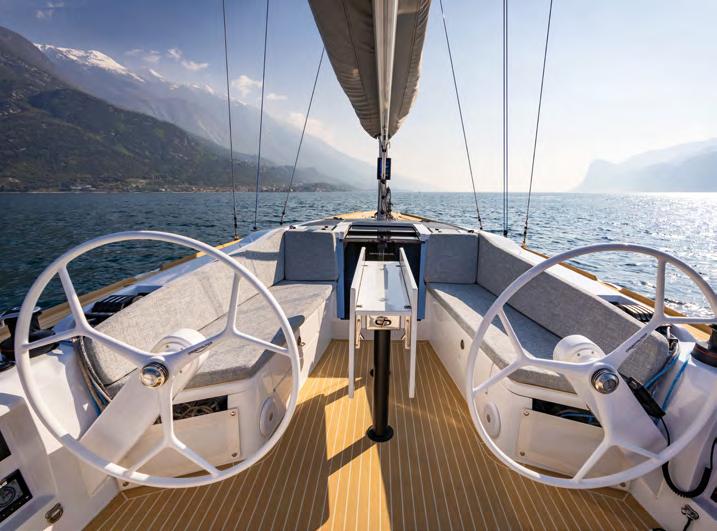
the easier separation of accessories and components of the vessel, similar to practices in the automotive industry. This process ensures that each part can be disassembled and recycled with the process seen above.
The boat also mounts a 6 kW electric motor with direct transmission pod drive by E-Propulsion with 8 kW 48V battery pack and Solbian photovoltaic system with a power of about 340 W integrated in the deckhouse, walkable and equipped with non-slip finish. The system recharges not only the engine batteries, but can transfer excess energy to those dedicated to onboard services. Furthermore, during navigation thanks to hydrogenation the electric motor allows to recharge the batteries allowing a minimum recharge of 250 W already at a speed of about 6 knots. The interiors have a height of about 1.40 meters, so you cannot stand up but they offer space for four people, a kitchen with icebox and a bathroom. The V-berth in the bow can be transformed into a sofa
[ ] PRESTA zioni | PERFORMANCE
tWs Velocità barca angolo Vele true wind Boat speed vento sails speed (kts) (kts) aWa
raNDa/FIOCCO maIN/JIB
raNDa/FIOCCO maIN/JIB
raNDa/FIOCCO maIN/JIB
raNDa/GeNNaKer maIN/GeNNaKer
raNDa/GeNNaKer maIN/GeNNaKer
raNDa/GeNNaKer maIN/GeNNaKer
raNDa/GeNNaKer maIN/GeNNaKer
raNDa/GeNNaKer maIN/GeNNaKer
CAnTiERE | SHIPyARD CAnTiERE dEl PARdo inFo@CAnTiEREdElPARdo.CoM www.CAnTiEREdElPARdo.CoM
area thanks to a pair of backrest elements. The wind on lake Garda is a certainty and after lunch the Ora blows from the south reaching peaks of 17/19 knots, perfect conditions that enhance the hull designed by Matteo Polli. The boat being tested is equipped with a Selden mast without a backstay and OneSails sails in 4T Forte, also made with thermoplastic materials: glues, resins and solvents traditionally used in the manufacturing process have been replaced by a hot fusion process, while the basic polymer is 100% recyclable through normal waste sorting disposal processes. The model tested has a 2.20 meter deep keel with a steel box blade covered in fiberglass and lead torpedo while a less deep and slightly heavier version is being studied. The boat is fun and responsive, with the fixed gennaker the maximum speed of the day is 10.5 knots under a nice gust with the gennaker. When sailing upwind, with the boat heeled, you feel the need for a toe clip for the helmsman.
SCHEdA TECniCA TECHNICAl DATA
